Vampire: The Masquerade by Halloween Jack
| 1 | Intro |
| 2 | Introduction |
| 3 | Setting |
| 4 | Interlude: A Dark History of Face Grabbing |
| 5 | Storytelling |
| 6 | Rules |
| 7 | Character |
| 8 | Chronicle |
| 9 | Clans |
| 10 | Traits |
| 11 | Bondage & Discipline |
| 12 | Dramatic Systems |
| 13 | Dramatic Systems |
| 14 | Drama |
| 15 | Appendix, Part 1 |
| 16 | Forged in Steel |
| 17 | Scenario |
Intro
Original SA postIt’s five days until Halloween. I’ve got a bottle of pinot noir and the complete discography of Clan of Xymox. Let’s do this.
quote:
Hold on to your asses, ass-holders.
--Heinrich Heine, AmeriKKKa's Most Wanted

When I was a 7th grade band geek, my friend Jonathan told me about a new game his big brother was playing. “You play vampires,” he said, and that was all I needed to hear. My mother had cravings for Count Chocula when she was pregnant with me; I’ve been consuming vampire anything since I was a fetus.
“What kind of game? Like a board game?” I whispered as I drained the spit from my French horn. Soon, I had managed to learn about roleplaying games without D&D even being mentioned. I don’t remember exactly how or how much I pleaded with my parents, but Vampire: the Masquerade was not under the tree that Christmas. Instead, after I’d unwrapped my other presents, my parents asked me to get the paper off the front stoop. There it was, wrapped in brown paper.
Mom and Dad have regretted it ever since.
Why This Matters
It would be a waste of energy to try to full explain Vampire’s importance to the industry. If you’re interested, I refer you to Shannon Appelcline’s Designers & Dragons Vol. 3: The 90s. Spoiler: There’s a reason that the cover features an ankh logo.
Even if you don’t care for Vampire or the many games it inspired, White Wolf changed the industry. They made room for a whole new kind of game and experimented with new publishing models. Companies such as Atlas, Eden, Dream Pod 9, Last Unicorn, and others published games that were far afield from the World of Darkness, certainly not imitators--but I can’t see them publishing the games that they did, the way that they did, without White Wolf setting a standard.
That said, Vampire: the Masquerade inspired at least a few games that were nakedly aping its style. I don’t think any other roleplaying game besides Dungeons & Dragons has ever inspired so many companies to mimic it so closely and so shamelessly. When you crack open a World of Darkness ripoff, you can immediately recognize it by the block quotes from such scattered sources as Percy Bysshe Shelley and My Life with the Thrill Kill Kult. Ron Edwards once lamented in his essay “More Fantasy Heartbreakers” that it was dispiriting to see RPG writing turn into a contest “to see who could present a game with prose that imitates Vampire the closest.”
When I mentioned that I wanted to review Vampire, someone suggested I start with the first edition. I probably should, but...the first edition wasn’t the one on my doorstep on Christmas morning.
Preface: The Damned
Before we even get past the author credits page, Mark Rein$Hagen lays some heavy shit on us:
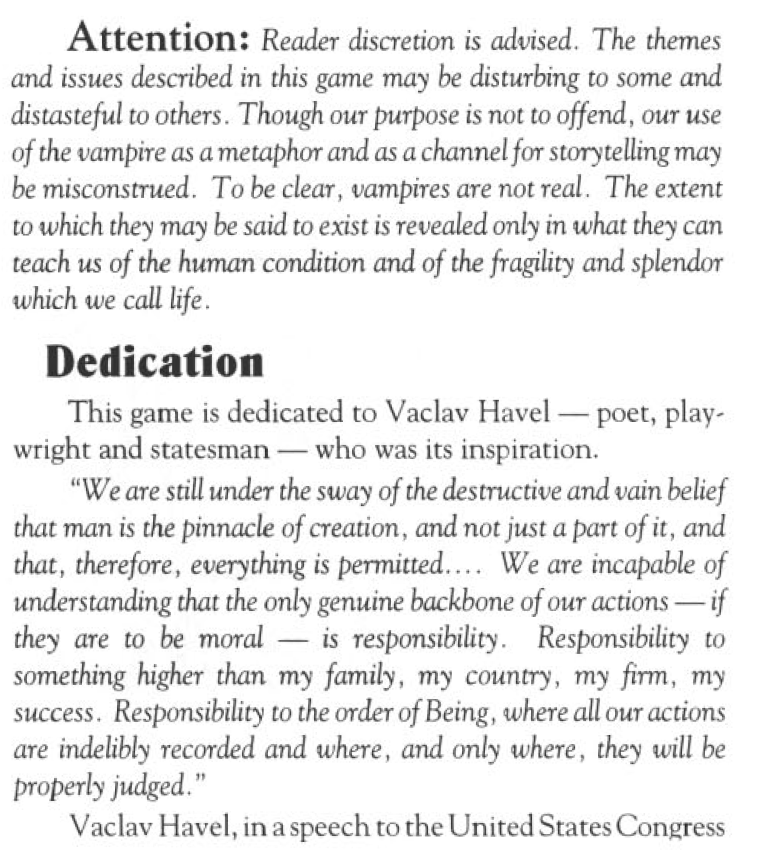
Also, a shout-out to my dogg Bulgakov, holla at your boy
A warning that you’re messing with Dark Sided Stuff, and a dedication to Vaclav Havel. Clearly this game is a little more serious in tone than its antecedent Nightlife.
The text itself begins with an essay titled Monsters, Monsters, Everwhere… The gist of it is that societies have always imagined supernatural Fiends, and in every age, these monsters reflect social anxieties. The evolution from trolls, demons, and witches to creatures like Godzilla reflect our changing concerns and values. Of course, modern people are aware that Godzilla isn’t real. But our rationalist conception of the universe allows us, even forces us, to come back around and examine our monsters as aspects of the human condition. Vampire’s tagline is “By becoming a monster, one learns what it is to be human.”
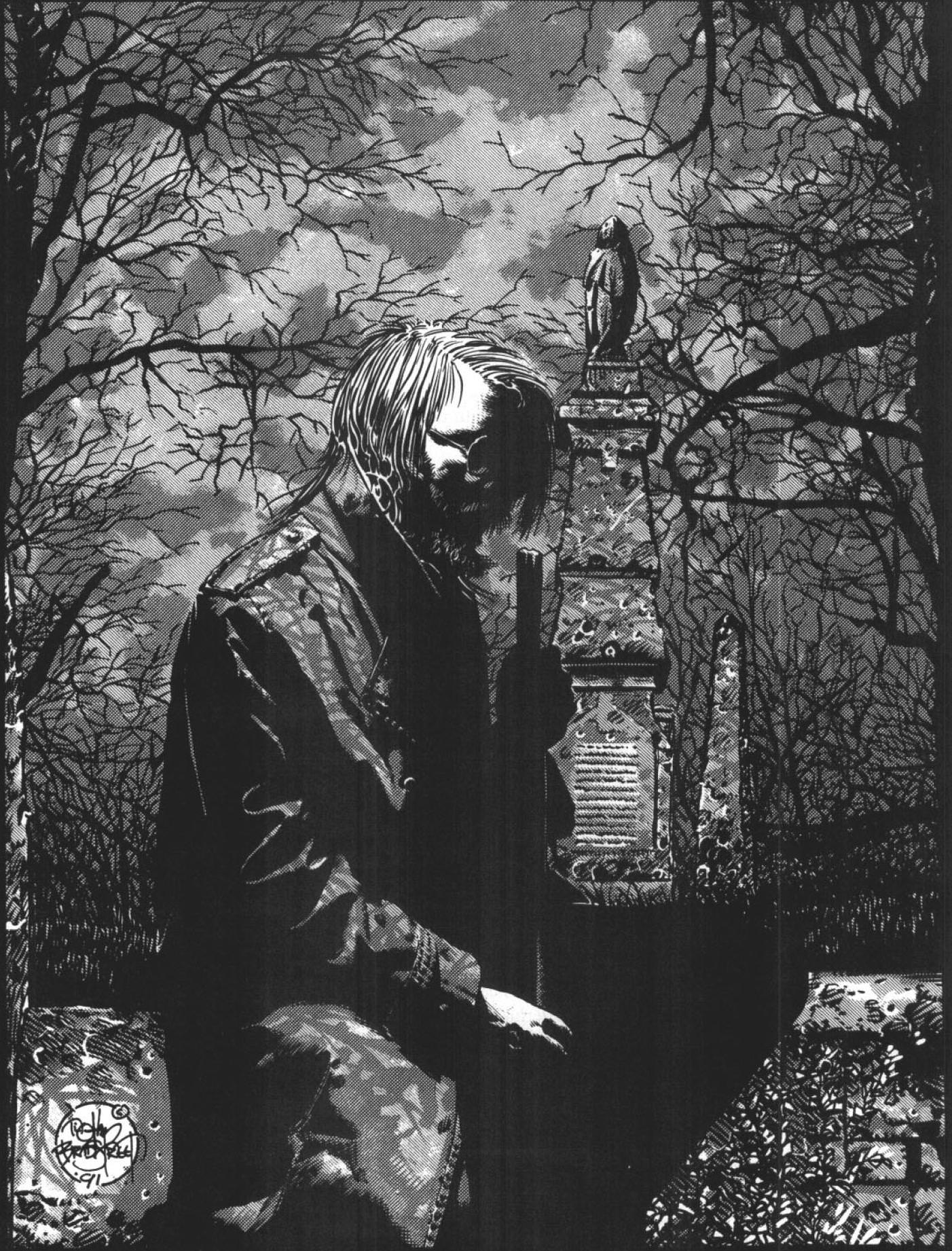
Vlad Tepes is Alive and Well and Playing Bass for Fields of the Nephilim
The next section--printed in Gothic font on a grey background--is a letter “To W.H. from your most devoted servant...V.T.” I won’t insult your intelligence by explaining what is implied here. The letter purports to apologize and explain for some unnamed incidents. The author, an admitted vampire, separates fact from fiction with regards to their nature and their powers and weaknesses.
Since much “serious” papal literature on vampires concerns identifying and destroying them, our pal V.T. starts with that. Sunlight burns a vampire like a raging fire. Vampires sleep during the day, and are very difficult to rouse. Even when they do, they are very sluggish.
Speaking of fire, they’re especially vulnerable to it. Decapitation is also lethal. Staking a vampire through the heart will only paralyze them until the stake is removed. They can be harmed by other weapons, but heal quickly. (He mentions being stabbed by W.T.’s “American friend.”)
Religious symbols are powerless against vampires, much less crossed candlesticks and the like. Except for very rare individuals with powerful religious faith, who can channel this faith through religious symbols to repel a vampire.
Garlic and wolfsbane? Mirrors and running water? Crossing thresholds? All meaningless. Vampires can go where they want, and they can’t drown because they can’t breathe.
Vampiric powers are many and varied, and many of the legends are true. Sharp senses, super strength, and hypnotism are all very real. So is shapeshifting, though this is a rare ability.
Vampires are created through a process called the Embrace. A vampire drains a victim of their blood, nearly to death, then feeds the mortal some of the vampire’s own blood. The mortal awakens as a vampire. The process is indescribably painful--V.T. compares it to “the sting of vinegar on a cut finger,” the pangs of starvation, and sleep deprivation, magnified a thousandfold and suffused through every tissue of your body. A newly created vampire can think of nothing but their hunger for blood.
So, the anatomy of a vampire. First, they’re clinically dead. They don’t have a heartbeat and they don’t bleed; their blood doesn’t flow unless they force it to. (No one knows why impaling the heart paralyzes them, since the heart seems to be useless.) In fact, they have no other body fluids--if they cry, they cry blood.
They don’t eat, or breathe, except to speak.Their digestive system withers and they become more pale and lean than in life. Their hair, nails, and so on are nightly restored to the state they were in at the time of death. (So if you’re thinking about becoming a vampire, you might want to get a haircut and a bikini wax.) Sex is possible, but vampires have no real sex drive.
The canines become long and retractable. Vampires like to feed from the carotid artery, and when they’re done, licking the wound will heal it. Human blood is the fuel that powers a vampire. They consume it to wake each night and to heal wounds, and if they don’t feed, they go mad and eventually give in to a bestial, murderous frenzy.
The Hunger for blood is a vampire’s constant companion and endless torment. It’s never fully sated, and it combines all a human’s base drives into one. Vampires don’t want food, or water, or sex, or drugs--they want blood, and the taste of blood is pleasurable beyond human imagination. All vampires are addicts like you can’t believe.
Part and parcel with the Hunger are two concepts that vampires call the Beast and the Riddle. The Beast is a vampire’s animalistic urge to seek blood and a safe place to sleep, and destroy anything that gets in its way. Kill, eat, sleep, repeat: that’s the Beast. The Riddle is “A beast I am lest a beast I become.” If you resist the Hunger for too long, you’ll snap and go on a rampage. If you do nothing but feed and sleep, you’ll lose not only your sanity, but your sentience. Some vampires seek a sort of spiritual transformation called Golconda, which supposedly allows them to control the Beast.
Vampires are functionally immortal, so once they ensure that they’re safe and fed, their biggest problem is simply keeping their minds occupied and not giving in to despair. Here they’re presented with further paradoxes. It’s hard to fit into mortal society, and even harder to watch your friends and family die off. But living like a hermit will make you starve or go mad. Imagine the trauma experienced by war veterans, now imagine living with that as it builds up over centuries. You can choose to become detached from humanity, but that too is a road through madness to the clutches of the Beast. As they age, vampires gain knowledge and power, but often their grip on humanity slips. Elders occupy themselves with cutthroat political games.
So where do vampires come from? No one knows. Most vampire lore comes from an ancient text called the Book of Nod. There is no complete edition, only conflicting fragments--but they all claim that vampires are descended from the Biblical Caine. The curse and mark of Caine was vampirism, and he established a city where he and his creations ruled over mortals. Caine created three vampires, called the Second Generation, who in turn created an unknown number of Third Generation vampires, after which Caine forbade any further Embraces. When a great flood came, Caine took it as a sign from God, and abandoned his children. The Third Generation rose up and slew the Second, and later the Fourth Generation against the Third, and 2,000 years later, their mortal slaves revolted against them. The city fell, and vampires insinuated themselves into the civilizations of ancient Greece and Mesopotamia. The rest is history.
There are legends that Caine still wanders the earth, and apocalyptic myths that the sleeping survivors of the Third Generation will someday awake and destroy their children, and the world along with them.
Vampires society is organized under a principle called the Masquerade. Throughout human history up through the Middle Ages, many vampires flaunted their power as an open secret. But the Inquisition of 1435 brought a newfound power and organization to the war against heresy. Most of the victims were innocent Christians and Jews, of course, but many vampires and genuine diabolists were killed, until vampires were in danger of extinction. A group of survivors formed a society called the Camarilla. Their first and foremost law is the Masquerade: vampires must present themselves as mortals, hiding their nature and their powers. Their polite term for one another is Kindred. Their second aim was to influence society so that no one even believes in vampires--thus, vampires helped foster philosophy from the Renaissance to the Enlightenment. That doesn’t mean Kindred secretly rule the world and engineer all human beliefs. Marx was human, and Kindred had nothing to do with the rise of fascism.
(Historical note: Vampire plays fast and loose with history, basically going along with the narrative of Genesis, the concept of the Dark Ages, the “Burning Times” myth, and being extremely Western-centric. I assume the Inquisition of 1435 is based on the [url=https://en.wikipedia.org/wiki/Council_of_Florence]Council of Basel[url].)
The key to understanding the Camarilla is that it’s more like a mafia syndicate than a real government. It’s made up of several Clans, and the polite and every city of significant size is ruled by a Prince (male or female). Princedom belongs to whoever can hold onto it, and it’s up to the Prince to interpret and enforce the Camarilla’s laws. So in practice, cities can vary widely from tyrannical dictatorships to anarchic collectives with a presiding figurehead.
Every city makes its own rules and resents intrusion by outsiders. The Camarilla has a powerful Council of Elders, but in practice, it’s extremely difficult to travel the world telling Princes how to run their cities. The Camarilla’s laws are called “Traditions” for a reason. There is a rival sect, called the Sabbat, that disregards the Masquerade and humanity itself. They control much of the Northeastern U.S. and basically act like slasher movie villains.
The Prince enforces the Masquerade, keeps track of Kindred living in the city, and controls the creation of new Kindred, among other Traditions I’ll enumerate later. Although the Masquerade is almost universally regarded as common sense, many young Kindred, called anarchs, resent the other Traditions and flout them as much as they can get away with.
Now is a good time to talk about what happens when someone drinks vampire blood. First, Kindred often create Ghouls by feeding vampire blood to mortals. Ghouls remain mortal, but they don’t age as long as they have vampire blood in their system. They can also develop vampiric powers. These run out quickly if they lose their steady diet of vampire blood. Ghouls are in the cellar of Kindred society, kept in the dark and fed on shit. Some believe that they are vampires, and many go insane. (Yes, you can have your own Renfield.)
Second, the only way to “lower” your Generation is to drain an elder vampire to death in a process called diablerie, consuming their soul to increase the potency of your own blood. But simply drinking another vampire’s blood doesn’t give you power over them--quite the opposite! If you drink a vampire’s blood three times, you become “blood bound” to them, unable to disobey them. Elders often use this to control their children, and ghouls are Blood Bound as a matter of course. What’s more, it’s said that very old elders have such potent blood that feeding from mortals no longer sustains them, so they must feed on younger Kindred.
This is a major drive of conflict and paranoia in Camarilla society. Young Kindred fear slavery and predation, and elders fear being overthrown and annihilated.
Vlad ends his letter with further apologies. He says that he’s glad that his plans failed, and has followed the fortunes of Mina’s family with interest, leaving contact information. But he admits that he’s written the letter in part because he’s weary of eternal life, and knows it’s likely that sending the letter is signing his own death warrant.
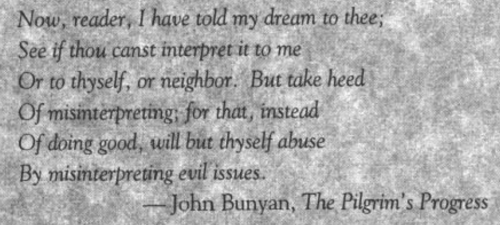
Aw yeah, that's the stuff.
Next time, on Kindred: The Embraced: An introduction that explains “What be a roleplaying???” and gets into the themes of the game.
Introduction
Original SA post
Vampire: The Masquerade (2nd Edition)
quote:
God is not willing to do everything, and thus take away our free will and that share of glory which belongs to us.
--Digital Underground, “She’s Lost Control”
Chapter 1: Introduction
Following “To Mina With Love,” Vampire has a brief introductory chapter which provides an intro to roleplaying, lays out its themes and creative goals, and raises some particulars of the setting. It’s not exactly succinct, and jumps between these three agendas repeatedly. Yet it makes the authors’ goals very clear. First, they very much wanted to capture an audience that was new to roleplaying. Second, playing Vampire: The Masquerade is not like playing other roleplaying games. Vampire is serious business. And don’t you forget it, or the cost may be your very soul!
Fuck, now I’m doing it.
It’s difficult to convey Vampire’s self-seriousness without lengthy quotations, but I’ll try. It promises “stories of madness and lust...from the darkest recesses of our unconscious minds.” The myth of the vampire is the perfect embodiment of our antisocial yet relatable impulses. The promise of perverse thrills is couched in warnings that playing Vampire requires facing your inner demons. “Madness as well as wisdom rewards those who dare to gaze into eternity.”
Looking back, it’s easy to see why most people seemed to play Vampire as a game of political intrigue or, failing that, edgy superheroes. Vampire folklore is employed to tell many stories about the dark side of human nature, but fears of alienation, exploitation, rape, disease, and death are at the forefront. Diving into the “darkest recesses” of these themes is a lot to ask, especially from an audience new to roleplaying. I think there’s a strong argument that the elements of Vampire that differentiated it from the works of Rice, Hambly, et al. were the key to its success.
Storytelling and Myth
Vampire posits that before mass media existed, people were active participants in storytelling. Modern humans are passive receivers, unconsciously absorbing narratives through our television screens. Our worldview is being manipulated by an oligarchy of artists and their patrons, usually to our detriment. Roleplaying is not merely a hobby, but a way to become an active participant in the stories that inform your perspective. Vampire may be the first game to posit roleplaying as a method for personal growth; I can’t think of an earlier one.
Vampire also makes it clear that in order to get the most out of it, you must be on board with its creative agenda: romance and tragedy. Despite its punk aesthetic, Vampire’s moral universe is one where good and evil exist in stark contrast, and the characters are cursed to do evil in order to survive. This makes the PCs tragic heroes, like in the works of Aeschylus or Shakespeare; the curse of vampirism takes the place of the prophecies and exigencies that doom such heroes in spite of their best efforts. (I’d say Kindred are more like Romantic heroes, e.g. Faust and Heathcliff, but I’m dutifully summarizing the text for you.)
For this reason, the prospect of winning and losing is much different from that in other roleplaying games. “Winning” requires a victory over the self, or finding a way to serve a greater good. It’s possible that the only victory for your character is a noble death.
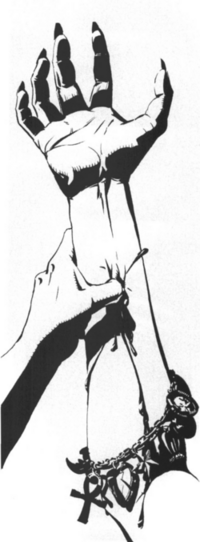
No, don’t pop it!
Roleplaying
This chapter provides an introduction to the roleplaying hobby that, by today’s standards, verges on patronizing. It explains that there is no board or minis, and invokes Cops’n’Robbers and Cowboys and Indians to explain roleplaying. Readers are advised to procure 10-sided dice, pencils and scratch paper, and a table to put them on.
However, as Vampire explains the role of the players and the GM, it presents more of its creative agenda. The GM is called the Storyteller, and is responsible for entertaining the players and balancing the “skeleton of the story” against their ability to improvise. Players have near-total control over what their characters say and do, but the Storyteller runs the world, and everyone is encouraged to put story above any PC’s motivations. Vampire is ultimately a very GM-driven game.
On the player side, Vampire doesn’t go in for the fallacy of total “immersion.” Players are encouraged to think both as an actor and a player. Act out your character’s responses and motivations, yes--but as a player, drive the narrative towards accomplishing their goals and resolving their story.
Vampire goes on to justify its stance with a rather audacious theory of self. It argues that what we call the self is an ad hoc performance, constantly changing from one situation to the next and drawing from many different sources. For that reason, you can never totally immerse yourself in a character, and characters are storytelling tools which can never be as fully-realized as human beings. Using Frankenstein’s monster as an analogy, Vampire argues that quantifying a character as a set of stats, and even giving them many fictional details, is far easier than giving them “the breath of life,” some essential and relatable aspect of yourself.
One last, peculiar note on roleplaying in Vampire concerns live-action roleplaying. The game was designed to combine LARP and tabletop, with LARP taking over for “downtime” or scenes that are anticipated to be heavy on drama but light on rules. I’ve never known a group that did that. The closest I can think of is a LARP group doing “interactive downtime” when playing in public, with the expectation that people would roleplay but avoid doing things (like combat) that demand a Storyteller’s attention. Some butthole always fucks it up.

Deal with it
Becoming a Vampire
In and amongst all this Jungian frou-frou are some notes on the game’s premise beyond “You’re a vampire, deal with it.” Becoming a vampire is an agonizing, traumatic experience. A new vampire awakens from death with a ravenous hunger for blood. They spend months or years under their sire’s tutelage, learning to cope with their vampiric nature.
Your sire’s lineage determines your special powers and your familial relations among Kindred. But elder vampires see you, first and foremost, as a cohort of young vampires who have just been released by their sires and “come out” into Kindred society. It’s assumed that the PCs will form a brood (or coterie). This doesn’t make you best friends, but you look out for each other and your mutual interests.
In the end, your unlife is ruled by the fact that you need to drink blood to survive. Getting this far doesn’t mean you’re at peace with it--you’ve just got what it takes to survive this long without getting caught or going totally insane. Some vampires strive for Golconda, a spiritual enlightenment that allows you to either become mortal again, or transcend the influence of the Beast.
The Hunger is never fully sated, and the Beast always strains against its cage. There's more of this stuff about how being a vampire is sad. It’s really, really sad, you guys.
So sad.
Next time, on Kindred: The Embraced: The setting chapter. It's J-J-J-JARGON TIME!
Setting
Original SA post
Vampire: The Masquerade (2nd Edition)
quote:
On days like this
In times like these
I feel an animal deep inside
Heel to haunch on bended knees
Johann Wolfgang von Goethe, “The Raven”

First Carl McCoy, now Groovie Mann. By the end of this book, everyone in every band will be a vampire.
Chapter Two: Setting
Before getting into the particulars of its setting, Vampire discusses its mood and atmosphere. It defines it in brief as Gothic-Punk. “It is a world of darkness. All in all, the world is more corrupt, more decadent and less humane than any suburbanite would like to believe.” Hey, this sounds like the start of a brand!
Vampire says explicitly that its Gothic-Punk setting is a dystopian vision of its own time, not a meticulously researched alternate history. The same faces are on Mt. Rushmore, the same shows are on TV, but all the symptoms of civilizational decline are exacerbated. Institutions are as corrupt as they are monolithic, existing only to perpetuate themselves. Inner cities are stricken with poverty and ruled by gang violence and organized crime. The Church is strong only because people turn to superstition in their lives of quiet desperation. Culture is bankrupt; all art leans toward escapism. Even fashion and architecture are more dark and Gothic than in the real world.
The dystopia of Vampire is very much of the zeitgeist of the 1990s. It rages against what would come to be called the “end of history” after an essay (later a book) by Francis Fukuyama. It was the idea that the current political status quo was the ultimate form of government, and the future would just be a process of perfecting and managing it. You can criticize capitalism, consumerism, and the many injustices of the world all you want, but there are no better alternatives. (The second edition of Vampire was published just months after the Soviet Union finally dissolved.)
It’s a status quo predicted in works like They Live and Watchmen, and treated more literally in films such as The Matrix and Children of Men. And the 90s gave us a lot of art in which transgression and antisocial violence attained a sort-of folk-heroic status--for example, any movie with Quentin Tarantino or Gregg Araki’s name attached to it. Those artists moved on to other things, and so did Vampire in its later iterations.
Quite a tangent, I know, but my point is that Vampire’s setting is an expressionistic one. The unstated theme is a society decaying while, paradoxically, being locked in a kind of stasis. It’s not incoherent for depicting a society so decrepit that the United States ought to have collapsed into a Third World hellhole already--that it does not do so is the point.
Ecology of the Vampire
Vampires are not a natural species, but they have a place in the food chain like any other predator. The mortal population can only support so many vampires, and when the Kindred population grows too high, starvation and outbreaks of violence drive it back down. This is not the best way to regulate the population, of course, because it threatens the Masquerade.
Vampires are creatures of the city. It’s where all the food is, of course, but that’s not the only reason. First, vampires don’t travel well. I’ve heard some horror stories from people who missed their flight, but none of them involved spontaneous human combustion. Second, rural areas are dominated by Lupines--werewolves--who hate vampires with a passion. But the most important reason is that nearly all Kindred crave security and some semblance of a normal life. It’s not easy to stake out a safe haven and a cover identity that allows access to mortal blood. Kindred, even old and powerful ones, are loath to operate outside their tiny sphere of influence. This is why the Camarilla doesn’t wield much central authority, despite being backed by the most powerful Kindred around.
Centuries ago, every Kindred was lord of their own city, with only their progeny to keep them company. But as the mortal population has expanded and learned to coexist in vast metropoli, so too have vampires. As a general rule, a city can support 1 vampire for every 100,000 mortals. For example, the metropolitan area of a metropolis like Chicago, with 13 million, will support 130 vampires. That doesn’t mean it doesn’t climb higher. The efforts of the Prince and the city’s elders to restrict the population of young vampires is a major component of the endless cycle of intrigue and violence that Kindred call Jyhad.
Vampire Society
quote:
Immortality is the best recollection one leaves.
--Percy Bysshe Shelley, Highlander II: The Quickening
The most important factors in establishing social class among Kindred is Generation and age. Sure, the elders take note of talent and accomplishment, but the greatest accomplishment is surviving for centuries.
(Your “Generation” is how far removed you are from Caine, assuming the old bastard ever really existed. Caine is the 1st Generation, cursed by God Himself, his childer were the 2nd Generation, and so on. In game-mechanical terms, your Generation determines stuff like your maximum level in supernatural powers and other stuff, and you can’t increase Generation with experience points. It’s a major component of a character’s power level, and PCs start at the bottom--the 13th Generation.)
Thanks to Jyhad and the pull of the Beast, there’s an attrition rate even among the elders. But for the most part, the elders in charge stay in charge. Imagine how stupid and awful your city government would be if that corrupt old bastard everyone hates just never, ever died. And if you piss him off enough, he can throw a car at you.
A childe (plural childer) is a vampire that is still being trained by their sire. Childer are not considered adults in Kindred society, and their sire is held accountable for their fuck-ups. (You might call someone a childe if they make a stupid rookie mistake.) People who just can’t hack it as vampires are put down by their sires before they get past this point.
A neonate is a Kindred who has recently had their coming-out, which includes being presented to the prince of the city. (That often includes some catechism, bar mitzvah type shit where you have to recite the Kindred laws and your ancient Dracula lineage, and do some medieval vassalage ritual.) If a neonate survives a few decades without majorly fucking up, they’ll become an ancilla. Neonates are typically 11th-13th Generation Kindred.
Ancilla (plural ancillae) is the rank between neonate and elder. These Kindred are typically 100-200 years old, have carved out a niche for themselves, and are building their power and influence. They are usually 9th-11th Generation Kindred.
Elders, at 200-1000 years old, are the old and powerful vampires who are the movers and shakers in any given city. They are consumed with Kindred politics, making them visible faces of the establishment. Kindred considered elders are generally 6th-8th Generation.
Methuselahs are truly ancient Kindred, of the 4th and 5th Generations. At that age, Kindred undergo a change that makes them even more paranoid and consumed with ennui. They withdraw from Kindred society, manipulating their pawns from afar. These ancient conspirators are the engines of Jyhad.
Antediluvians are the stuff of myth and legend. The name is literal--we’re talking about Caine, his childer and grandchilder, who were lost to history after the fall of the Second City. These are the 1st, 2nd, and 3rd Generations. They are as frightening to the Methuselahs as the Methuselahs are to the rest of the Kindred, and the mere rumour of their involvement is enough to instigate chaos. No one really knows how many of them have survived, what their motives are, or what powers they possess. Many believe in a coming apocalypse, called Gehenna, when the Antediluvians will awaken and destroy their childer as they war with each other, laying waste to the earth. It’s also possible that some have reached Golconda and are trying to guide Kindred toward a higher state. In any case, if these ancient vampires are still involved in Jyhad, they do so at an even further remove than the Methuselahs, and all Jyhad is ultimately down to the chess moves of the Antediluvians.
Two other distinctions worth mentioning are the Caitiff and the anarchs. Caitiff are vampires with no Clan--perhaps their sire abandoned them or died before they could be properly trained and introduced to other Kindred. Elders regard them as the scum of the earth, and the typical Caitiff is a bottom-feeding vagabond. Anarchs are young Kindred who reject the rule of princes and elders as much as they can get away with. As far as some elders are concerned, all young Kindred might as well be anarchs. If Caitiff are the homeless of the Kindred, anarchs are the anarchist punk squatters.
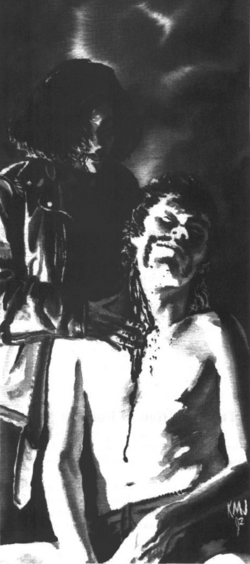
Lemmy. Also a vampire.
Traditions
The book has a long section covering what it means to be a Prince, followed by one on the Traditions that constitute the oldest laws of the Kindred. I’m covering the latter first.
The Six Traditions are supposed to have existed for as long as vampires have had any kind of society. Some claim they were handed down by Caine, but it’s more likely that they were established after the war that destroyed the 3rd Generation and the Second City, to prevent such a thing from happening again. Furthermore, the common wording and interpretation of the traditions is a few centuries old. In the modern nights, the meaning of each Tradition is whatever your city’s prince can and will enforce.
I. The Masquerade: Thou shall not reveal thy true nature to those not of the Blood.
The first rule of Vampire Club is that you do not talk about Vampire Club. This is the ultimate law of the Kindred. Even anarchs obey it as a matter of common sense. The vampire who breaks the Masquerade endangers all Kindred and is not Kindred at all.
II. The Domain: Thy domain is thine own concern. All others owe thee respect while in it.
This is the most iffy Tradition, because it’s a throwback to the age when each Kindred ruled over a city with only their childer to keep them company. In modern times, the prince is considered to hold domain over all the city. Kindred constantly war over turf, and anarchs think the prince grants turf to their favourites--but it’s more like they’ll recognize the niche you’ve carved out for yourself and your right not to be fucked with. (Most especially, the right not to have your haven burned down while you sleep.)
Like so much else in the Camarilla, possession is nine-tenths of the law. Kindred basically operate like organized crime, so you’ll see things like anarch gangs claiming a feeding ground but giving elders wide berth when they roll through. Like any feudal lord or mob boss, the prince has to have a light touch and tolerate some internecine conflict in order to protect their own position.
III. The Progeny: Thou shall only sire another with the permission of thine elder.
“Thine elder” refers to your sire or your prince or both. Control over the creation of new Kindred is one of the prince’s most vital powers. Any given prince will likely create childer to expand their power base, and try to prevent Caitiff and anarchs running around their city. “Illegal” childer are likely to be put to death along with their sire. Anarchs say “fuck you” to this Tradition as a matter of course.
IV. The Accounting: Until thy Progeny shall be Released, thou shall command them in all things. Their sins are thine to endure.
Thee thou thy whatever, this is perhaps the simplest tradition. Childer have no rights, and no responsibilities either. Until you release them, their fuckups are your fuckups.
V. Hospitality: When thou comest to a foreign city, thou shall present thyself to the one who ruleth there. Without the word of acceptance, thou art nothing.
When you travel to a new city, you’re obligated to present yourself to the prince. Some princes make a big ritual out of it, while others are fine with a phone call. A lot of Kindred despise this Tradition out of principle. The anarchs hate the whole idea, while elders find it humiliating. That’s ironic, because enforcement is typically mild. Even those who never present themselves and get caught are typically just hauled in front of the prince, roughed up, and tossed out on the street. Princes value this Tradition because it gives them the right to know who’s in their city, and question them about who they are and what shenanigans they’re up to.
VI. Destruction: The right of destruction belongeth only to thine Elder. Only the Eldest among thee shall call the Blood Hunt.
There it is, the answer to the question “What if I break these rules?” The only punishment enshrined in the Traditions is also the most extreme. The Blood Hunt combines a death sentence with the ancient punishment of outlawry: you are no longer Kindred, and it’s open season on you. It’s similar to being declared an “enemy of the people” in ancient Rome: all Kindred are obliged to join the Hunt, and aiding you is treason. It’s not some weird ritual where vampires dress up like fox hunters and sicc hounds on a renegade Kindred. It’s a coordinated effort to track them down, find them, and kill them, with mortals being none the wiser.
As with the other Traditions, princes interpret the “Elder” as themselves, and a prince who can’t enforce his monopoly on the right of Destruction is not going to be prince much longer. The prince must invoke this Tradition to carry out a death sentence, and doing so for capricious reasons likely results in a half-hearted Hunt and humiliation for the prince.
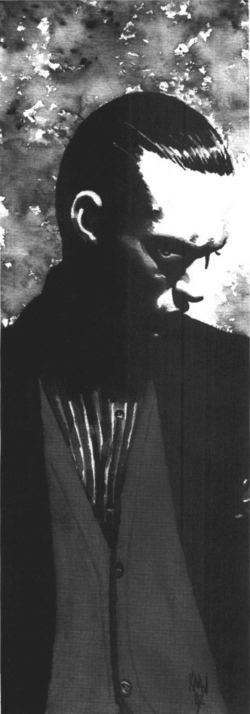
You knew Mister Rogers was a Marine sniper, but did you know that he was...a vampire?
Seriously, I’m 90% sure they cast the star of Kindred: The Embraced from this picture.
Princedom
The title of prince is a throwback to the era of feudal baronies and city-states, but the modern age is the age of the princes. Simply put, the prince is the vampire who maintains political control over a given metropolitan area. The Camarilla, which purports to govern all Kindred, began formally recognizing princes in the mid-18th century.
As I’ve said, the Camarilla wields little central authority over everyday affairs. I mean, if shit gets really fucked up, the Camarilla has higher-ups that are more powerful than any prince. But they really don’t want to uproot themselves and come clean up your shithole city. As a result, there’s no barrier between de facto power and “legitimacy.” If you’re the one in charge, the Camarilla recognizes your right to rule.
Another consequence of decentralization is that rulership varies widely from city to city. Some princes assume fancy titles and hold court with elaborate rituals, while others are content to abide as the guy you don’t fuck with. Some cities don’t have princes at all, and are ruled by a council or informal agreement.
Anyone can claim princedom, and anyone can challenge the prince--this is another component of Jyhad. The struggle takes the form of gang warfare, as each side marshals its soldiers and musters all its influence over mortal institutions (press, police, politics, etc.) to destroy the other. The aftermath of such a war is often a power vacuum. Perhaps this gives the impression that princedom is an endless game of king-of-the-hill, but not so. A good prince uses his privileges to build power and prevent rebellion. The elders will support him, if only to prevent chaos.
The Prince can interpret the Traditions however they like, and make up whatever other laws they like--if they can’t enforce them, it’s their problem, and a prince who can’t back up their claims is swiftly replaced. A prince is often the eldest and most powerful Kindred in the city, but not necessarily. Other elders are often disdainful of the prince--either they want the job themselves, or they think anybody who does is still immature. But elders generally support the prince’s mundane efforts to keep order, preventing anarchs from roaming the streets, creating too many childer and threatening the Masquerade. Elders are often members of the primogen, a council of advisors that is tradition in many cities.
Another strong tradition is that of Elysium. Princes can declare an area elysium, meaning that it is neutral ground where no violence is permitted. That rule also applies to any damage to the premises, as elysium is usually a place of high culture like a museum or art gallery.
Sects and Violence
quote:
A person who cannot live in society, or does not need to because he is self-sufficient, is either a beast or a god.
--Alan Moore, The Picture of Dorian Gray
Over half of all vampires claim membership in one of the major sects; some are only loyal to their Clan. (Now this is interesting. I believe the mysterious other half is meant to be anarchs, Caitiff, and obscure Clans which may be profitably detailed in a future sourcebook. As time went on, those vampires were understood to be the Kindred of the East and the Kindred of the Ebony Kingdom, who aren’t quite Kindred at all, as well as miscellaneous bloodlines like the Daughters of Cacophony.)
The Camarilla was founded in the 14th century in response to a newly reorganized Inquisition, and is the largest sect of vampires worldwide. Seven of the thirteen major Clans took part in its founding, and are considered to be of the Camarilla. (These are, incidentally, the Clans that you can play.) The Camarilla recognizes the Traditions, but not the Antediluvians--the semi-official stance is that they never existed, or if they did, they’re all dead. They don’t offer any alternative explanation as to where the fuck vampires come from, though.
The Camarilla considers itself the governing body of all Kindred, and the official view is that all vampires are members of the Camarilla, whether they want to be or not. This theory is, well, just a theory. Princes and elders don’t want oversight, Methuselahs are practically invisible, and the Sabbat dominates entire regions of developed nations.
I’ve repeated that Kindred politics are intensely local, but the Camarilla does have some overarching power. The core of Camarilla leadership is the Inner Circle and its Justicars. The Inner Circle meets in Vienna every 13 years, as it has for five centuries. Each Clan sends one voting member. The main purpose of the Inner Circle is to appoint Justicars, one from each Clan. The political campaigns are long and bloody, as Justicars are invested with broad powers.
Justicars are the highest officers of the Camarilla, and the way the Camarilla can actually impose its will. First, Justicars are empowered to call a Conclave, a mass gathering of Kindred to deal with very important matters. Any Kindred is welcome to attend, and has the right to vote and to give testimony. Among other things, Conclaves allow Kindred to air grievances against princes, and princes to invite aid to crush dissent. The Camarilla has always claimed the right to intervene in local affairs and to depose princes, and Conclaves are where that can happen. Conclaves are called in times of emergency, or just every few years to deal with big-picture concerns. The Justicar of Clan Gangrel holds one in New Orleans every 3 years.
Justicars are also empowered to judge any Kindred who violates the Traditions, prescribing whatever punishment they deem necessary. When a Conclave reaches a decision, it’s the presiding Justicar who carries it out. Each Justicar has a crew of skilled Agents called Archons, who are willingly Blood Bound to the Justicar.
So what is the largest sect besides the Camarilla? The Sabbat. Also known as the Black Hand, the Sabbat is said to have begun as a medieval death cult. The Sabbat rules some of the biggest cities in North America--including NYC, Philly, Toronto, and Montreal--yet almost nothing about them is known for sure.
The Sabbat creates new members by torturing mortals to death, feeding them the blood of many vampires, and then burying them alive. Only those who claw their way to the surface are strong and crazy enough to be part of the Sabbat. Its members are organized in “packs” that fight and feed together. Its two preeminent Clans are called the Lasombra and the Tzimisce.
The Sabbat rejects all the trappings of mortal society, and holds Kindred who try to hold on to their humanity in utter contempt. They revel in being monsters, and consider mortals nothing more than livestock. They worship death, holding rites at cemeteries and tombs. They are known for destroying their enemies with fire, and for practicing diablerie with abandon, even upon their own elders when they become too weak.
The unspoken weirdness here is that the Sabbat controls some of the biggest and most important cities in the US and Canada, is always at war with the Camarilla, and doesn’t give a fuck about humans--but we know almost nothing about them and they haven’t brought the Masquerade crashing down. It’s hard to predict how the tabletop business will go in this year of our Lord 1992, but I’m sure this state of affairs will be modified when White Wolf is ready to publish a sourcebook.
Finally, the Inconnu is a small and mysterious sect of ancient vampires who claim not to be a sect at all. They remove themselves from Kindred politics, and are able to live outside the cities by virtue of their extreme age and power. Sometimes they appear at Conclaves, but their only apparent commitment as a sect is to avoid Jyhad at all costs. They’re so removed from the world that they often sleep for years. Many seek Golconda, that mythical spiritual state that allows a vampire to transcend the evil inherent in their condition.
Of course, the existence of a brotherhood of extremely old and powerful vampires, who all claim to have turned away from material things, engenders exactly as much paranoia and speculation as you’d expect.
Clans
quote:
All happy families resemble one another; every unhappy family is unhappy in its own way.
--Anne Rice, The Sorrows of Young Werther
Vampires are naturally solitary and selfish, but blood ties are very important to them. Most young vampires have more in common with each other than with their sires and grandsires, but lineages stretching back thousands of years is still a vital part of Kindred culture. Most vampires can trace their lineage back to an antediluvian of the 3rd Generation. There was a time when every vampire could recite their lineage going back to Caine, but neonates don’t give a shit. This has the elders grumbling about kids these centuries.
Each Clan has unique vampiric powers and a unique curse, and conforms to a general archetype. But all that will be fully covered in the character creation chapter; this brief section is more about each Clan’s mythic origins.
The Brujah were once known as lovers and guardians of knowledge; their founder supposedly invented the written word. But they killed their sire in the name of freedom, and ever since they’ve been rebels and radicals on the fringe of Kindred society. The Brujah are the only clan that supports the anarchs as an institution.
The Gangrel are wanderers who pride themselves on avoiding politics and other entanglements. Their founder is also the ancestor of the Gypsies--like that’s a thing--and the Gangrel are supposed to have some kind of bond with them. Okay.
The Malkavians’ origin is a mystery, featuring many contradictory legend. The most common is that Caine cursed their founder with insanity, which was passed on to all his childer. The Malkavians have always been on the outside looking in, with their founder’s secret manipulations supposedly keeping them alive.
Legend says the Nosferatu were founded by a man with a beautiful face but an evil soul, so Caine cursed him with the face of a monster. All Nosferatu are horribly ugly. Their founder was a violent monster, but Nosferatu tend to be sober and secretive.
The Toreador are a Clan of artists and aristocrats. Their founder was a leader of the rebellion against the Second Generation, but allowed his own childer to nurture their civilized instincts. Toreador are strong supporters of Elysium and of tradition in general.
The Tremere are, frankly, the product of a colossal mistake. A vampire Embraced a family of sorcerers, who quickly synthesized their magick with their new vampiric powers and took control of their Clan. They’re even said to have destroyed their Clan’s original founder. The Tremere are especially secretive and close-knit, and widely distrusted because of it.
The Ventrue believe that their founder was slain by one of the Brujah. Rather than nurse a grudge, they took advantage of their freedom from manipulation to become the leaders of the Camarilla. More princes come from the Ventrue than from any other Clan.
Mortals and Other Bumps in the Night
The biggest threat to a vampire is usually another vampire, but they share the world with a lot of other freaks--werewolves, sorcerers, Boo Berries, spies, tenured professors, televangelists, Moonies, the works.
Powerful Kindred typically manipulate local governments, but it’s hard to say how much federal governments know about vampires. In the United States, the people most likely to be on to something are in the FBI and NSA. The remnants of the FBI’s investigations into Communist super-science are now called Special Affairs. They have active case files open on mysterious phenomena, but not much pull within the FBI. The NSA sifts a lot of data, and flags interesting or “anomalous” reports--but for all anyone knows, anything that could potentially bring own the Masquerade just gets lost in the churn. No vampire has been able to infiltrate the NSA to find out. The Center for Disease Control is the closest to outright investigating vampires--they’re concerned about the transmission of AIDS and other blood-borne diseases with no apparent vector, and have launched a large investigation into the matter.
It’s common knowledge that the Roman Catholic Church proved the existence of vampires, and formed the Inquisition that spurred the founding of the Camarilla. Today, that Inquisition survives in the form of the Society of Leopold. The Society is not part of the Church, but is mostly Catholic and includes many priests. They don’t have encyclopedic knowledge of vampires, nor are they any kind of armed-to-the-teeth vampire hunting militia. Mostly they study old records in an attempt to piece together the truth. But they have learned that individuals with strong, genuine faith can use it to repel vampires.
When they do capture a vampire, they hold elaborate trials before executing their prisoners. A Jesuit splinter group has become more aggressive in hunting down vampires. Meanwhile, official Camarilla policy is to leave them alone and avoid them. Many elders remember that first Inquisition and are still afraid, while some anarchs enjoy baiting them.
The Arcanum grew out of the “War of the Roses” among Parisian occultists in the late 1880s. (Vampire is quite accurate here: the people involved called it a “magical war” but to everyone else it was a very entertaining, very embarrassing scandal among prominent Rosicrucians that was played up in the newspapers.) The most serious and scholarly members of various splinter groups left in disgust and formed the Arcanum.
The Arcanum is a group of serious and well-funded scholars researching the supernatural. The Camarilla is unsure how much they know about vampires, as they’re much more interested in more spiritual and intangible phenomena like miracles and hauntings than in vampires and werewolves and the Loch Ness monster. Even so, the Arcanum is under the same order as the Inquisition: monitor them but never ever let them take notice of you.
So what about actual mages? Powerful sorcerers not to be trifled with, most of whom follow the ancient Order of Hermes. They aren’t particular enemies of Kindred, but they despise the Tremere as traitors. (I suspect that if White Wolf was already thinking about launching Mage, the concept hewed closely to Ars Magica at this point.)
Lupines, or werewolves, are “the mortal enemies of vampires...since the dawn of time.” Why? No explanation. Lupines live in close-knit tribes, and hunt down and kill any vampires trespassing on their territory. Only the Gangrel have contact with them, and even then, they usually hide their true nature. By the by, the World of Darkness seems to be a setting where every place that isn’t a big city is savage wilderness. Or at least, a Stephen King type ominous small town, where ominously creepy old men sit on ominously creaking rocking chairs outside dilapidated country stores, saying “Ah, can’t get there from here” and ominously advising you to be inside before dark. But hey, White Wolf was based in Georgia.
Ghouls are a sort of gentleman’s exception to the Masquerade. (For that reason, you ought to get a by-your-leave from the Prince.) Many Kindred create ghouls to do their grunt work and guard them while they sleep. Ghouls are Blood Bound as a matter of course. Once they surpass their natural lifespan, they need vampire blood in their system constantly lest they age to death in a matter of hours or days.

Hey baby, wanna help me eat all the humans?
Fangin’ and Slangin’ with the Type A List Brother
Now we come to White Wolf’s most famous innovation: slang.
Vampire features a “Lexicon” of three lists: terms that most Kindred use, terms that are only used by dusty old Grandpa Munsters and their bootlickers, and vulgar terms that are only used by anarchs and other scum. Vampire is notorious for inspiring a lot of other games to characterize their setting with lots of Capitalized Jargon Words; when you find a game that has multiple Jargon Words for the same damn thing, this is why. A lot of these terms concern when, where, and how vampires feed on humans.
I’ll be damned if I make the mistake I did with Everlasting and Immortal and detail every goddamn thing, but I will go through some highlights. There are a lot of terms here that I’ve already covered, like “anarch” and “childe.”
Alleycat (vulgar): A vampire who feeds on street people, and is usually one himself. The archaic version is footpad. When more respectable vampires do this, it’s called slumming.
Banker, Banking (vulgar): Kindred who rob blood banks.
Barrens: Parts of a city that are devoid of life, and thus of good eating--abandoned warehouses and suchlike.
The Beast: A vampire’s animalistic drive to feed, sleep, flee fire and sunlight, and forget everything else.
Blister (vulgar): A vampire that picks up a disease from feeding, and passes it on to future victims.
Butterfly (vulgar): A vampire who mingles among high society. The archaic form is Whig.
Cainite (archaic): Vampires. Even “Kindred” is too vulgar for some elders.
Cauchemar (archaic): A vampire who only feeds on sleeping victims, leaving them mostly unharmed. The vulgar version is Sandman.
The Damned (vulgar): Vampires.
Farmer, Vegetary (vulgar): A Kindred who feeds on animals.
Haven: The place where you sleep during the day. Vampires have a very “a man’s home is his castle” view of their havens.
The Hunger: The all-consuming urge to feed.
Jyhad: Any kind of war or political struggle between vampires, but especially that involving the ancients using the rest of us as pawns in their inscrutable master plans.
Kine: Mortals.
Kiss: A prissy term for biting people and drinking their blood.
The Life: An even prissier term for said blood. The archaic version is Vitae.
Lush: A vampire who feeds on intoxicated people. This is the only way vampires can get high, by the way.
Osiris (archaic): A vampire who creates a mortal cult to feed upon. This practice is now rare.
Praxis (archaic): The right of princes to rule.
The Rack (vulgar): The red-light district of nightclubs, brothels, and so on, considered prime hunting ground. The archaic form is Papillon.
Rake (vulgar): Those who hunt in The Rack are Rakes. The archaic form is Gentry.
Regnant (archaic): One who holds a Blood Bond over another. The bonded person is called a Thrall.
Retainers (archaic): Mortals, usually ghouls, who serve vampires. Many are so thoroughly controlled that they have no free will.
Rogue: A vampire who hunts other vampires to commit diablerie. The vulgar form is Headhunter.
Siren: A vampire who seduces mortals and feeds on them while they sleep, without taking too much blood. The vulgar version is Casanova or Tease.
Vessel: A human, coldly considered purely as a source of blood. The vulgar version is Donor.
So yes, Vampire has a lot of Capitalized Jargon, including some Latinish archaicisms, but its slang mostly sounds like plausible slang. And that lexicon rounds out the setting chapter.
Next time on Kindred the Embraced: A brief chapter on GMing. Yes, Vampire does this before rules and character creation.
Interlude: A Dark History of Face Grabbing
Original SA post
Vampire: The Masquerade (2nd Edition)
quote:
The apparition of these faces in the crowd;
Petals on a wet, black bough.
--Thomas Stearns Eliot, “Bela Lugosi’s Dead”
Interlude: A Dark History of Face Grabbing
I wanted to finish a Vampire update yesterday, but I was busy. I can only review Circle of Hands while smoking weed and listening to Sleep, and I can only review Vampire while drinking vermouth and listening to Clan of Xymox. I hope you understand. (Eventually, I'll review Vampire: Undeath. I guess I'll have to get into the Insane Clown Posse and get addicted to meth.)
In recompense I wanted to offer a brief interlude that touches on a crucial element of Vampire: the Masquerade that's been missing from my review thus far. It's very easy and very common to discuss every detail of a game while missing the forest for the trees. I'm talking about theme, of course. People have used vampire fiction to tell stories about addiction, exploitation, sexuality, alienation, and sin and redemption--often in combination. I'd even argue that most of the WoD edition wars over the years have boiled down to differences of opinion regarding theme.
But regardless of whatever other themes may be present in a Vampire campaign--sorry, chronicle--they are all ultimately stories about someone grabbing someone by the face. Their own face, or the face of another. It may arrive in the context of a pulse-pounding scene of violence where the grabbing of a face is the dramatic climax, or a quiet and deliberate scene in which a PC thoughtfully grabs their own face. But this is a vision that was presented consistently from the very start. These images are all from the corebook:
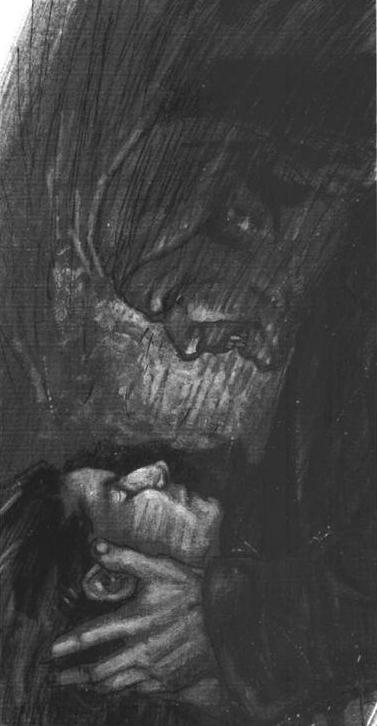
I reserve the rights to Mr. Bandanagrabber, Baby Bandanagrabber, and any other Bandanagrabber family character that might emanate therefrom
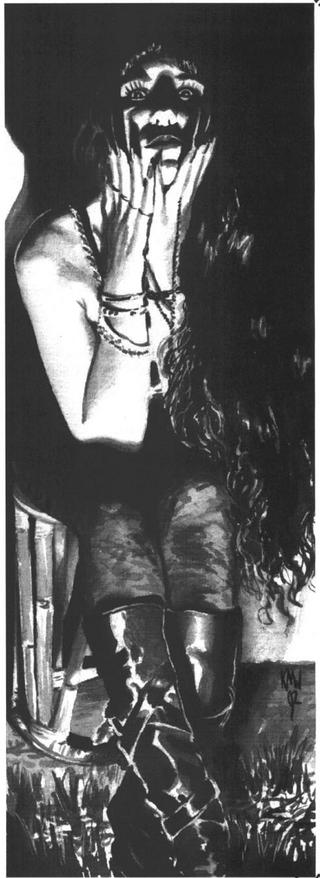
As a vampire, wearing Elvira nails is hiding in plain sight.
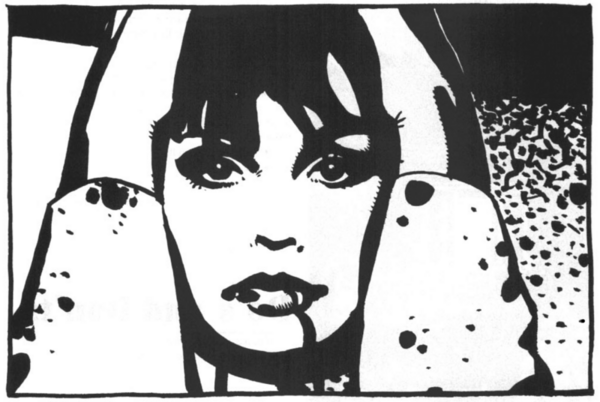
New Wave Face Grab
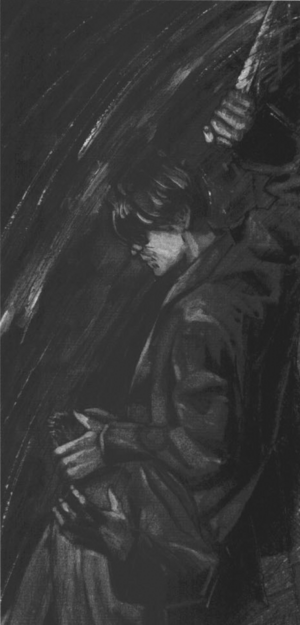
they cant troll you if there dead
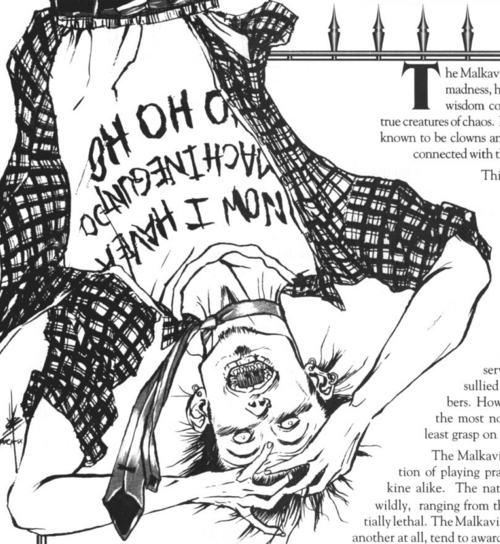
Oh, where do I begin?
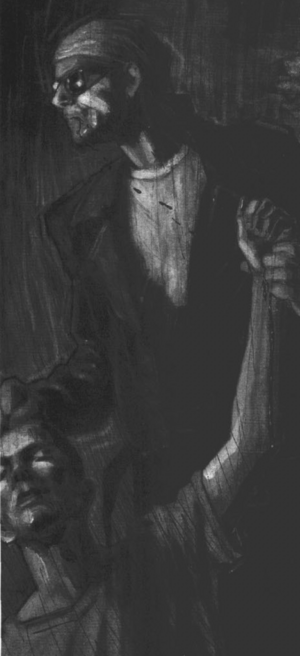
I mean, why would a guy with a bandana wanna grab another bandana? These are the questions I don’t want to answer.
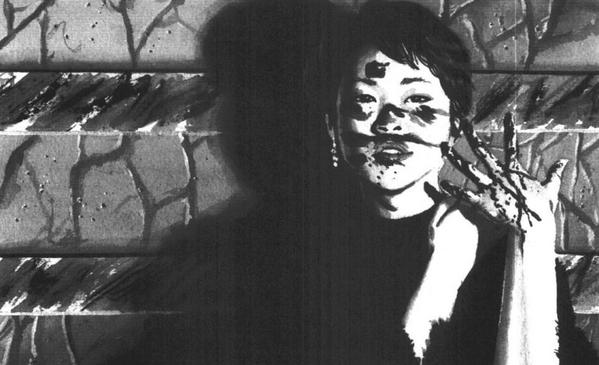
You’re late. We already grabbed our faces.

Just leaving this here
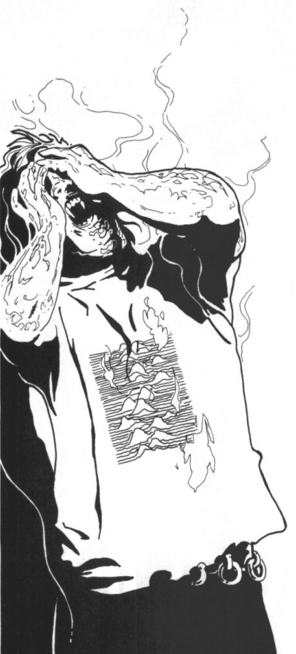
His Joy Division shirt is also a vampire
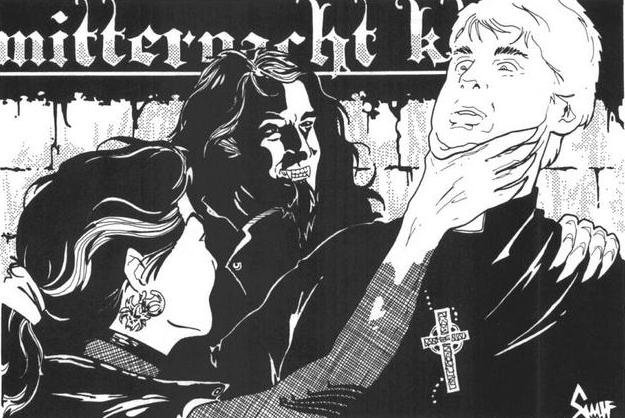
The Bishop!

Who can forget that scene in 9 ½ Weeks where they have rough sex behind some Florida glass?
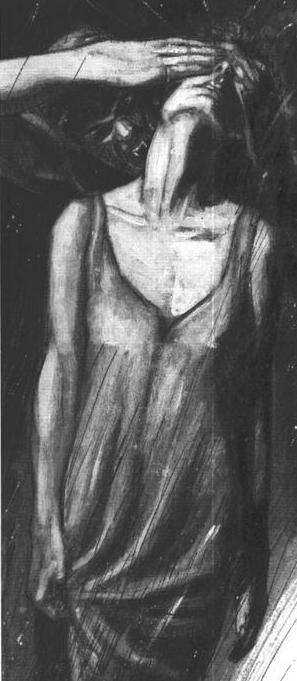
Peekaboo
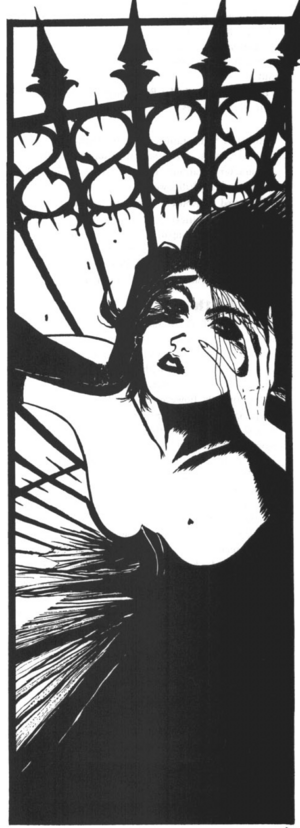
So I was out with this girl, right? And she wanted to, y’know, grab my face...but she left her glove on. Weird.
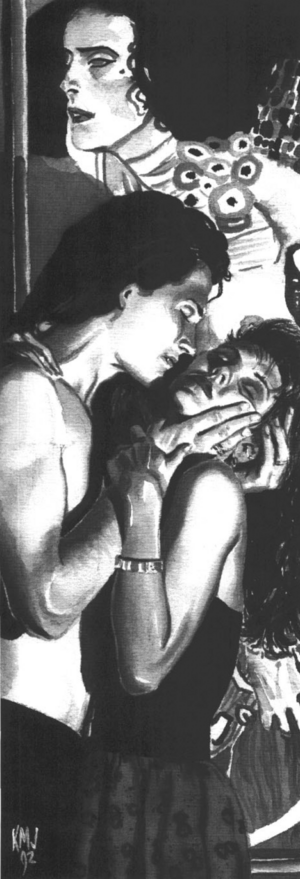
You can fall, I will catch you I’ll grab your face
Time after time
Time after time
Time after time
Next time on Kindred the Embraced: The first of two GMing chapters!
Storytelling
Original SA postWell, this is a long time coming. Sorry, everybody!

Vampire: The Masquerade (2nd Edition)
Preface
Chapter 1: Introduction
Chapter 2: Setting
Interlude: A History of Face Grabbing
quote:
To reign is worth ambition though in Hell:
Better to reign in Hell, than serve in Heaven.
--Christian Death, Beyond Good and Evil
Chapter Three: Storytelling
Vampire does something I don’t think I’ve seen in any other game: it has two chapters on the art of gamemastering. The first, “Storytelling,” gives advice on GMing in the moment, while a later chapter advises you on assembling a campaign.
If you follow this thread, you’re likely aware that Vampire came to be associated with a particular style of GMing. You could call it auteur theory for roleplaying; the gist is that the GM is the author of the Story. The players’ job is to figure out where they’re supposed to go and what they’re supposed to do to allow the story to progress. A rough synopsis for the campaign has already been written. Critics of Vampire and the games it inspired say that they confine the players to being passive participants in storytelling, perhaps wallowing in melodrama for lack of any real agency.
I have experience with several games from the 90s-00s that were designed from this point of view. They tend to portray the GM’s job as an enormous design project, and the players as dirty, sticky-fingered children prone to wrecking everything they touch. The worst product of these games are “narrative mechanics” that really serve as a cudgel to keep the PCs in line. (If you’re curious, read my review of Everlasting: a Vampire Heartbreaker full of “legendmaking” mechanics that mainly serve to punish players whose style doesn’t meet your standards.)
Why were there so many of these games? My analysis is that it was simply the state of the art. The hobby was still breaking away from from the adversarial, punitive style of GMing that enshrined itself in the 80s. The focus of discipline just shifted away from rules mastery and tactical decisionmaking, and onto roleplaying “the right way.”
But back to Vampire itself. Is it fair to lump it in with the games it inspired? That’s one of the questions that led me to revisit it. Whatever the case may be in later White Wolf publications, the advice given in this chapter is solid. It advocates a healthy balance between preparation and improvisation, uses specific examples to discuss common problems, and puts priority on keeping yourself and the players entertained.

Gonna jump this sweet baby over a pope
The Role of the Storyteller
It does, unfortunately, kick off by emphasizing the godlike power and responsibility of being the Storyteller. The Storyteller’s role is likened to that of a director, stage manager, and other behind-the-scenes roles in a stage production combined, and a poet, inventor, even a god. After all, it’s your job to create a detailed world out of thin air, be the final authority on the rules, play all the NPCs convincingly, and most importantly, improvise responses to the PCs, who have complete freedom of action.
With that out of the way, the first specific advice it gives is that you should “never simply tell a story” and force the game down a predetermined path. Prepare, but don’t over-prepare: anticipate the likely paths the PCs may take, but have a few contingency plans. Prepare story hooks, not a detailed plot.
The advice on rules is mostly about when to set them aside. On the spectrum from “rules lawyer” to “freeform,” Vampire leans toward the latter. But whether you use every optional rule in every subsystem, or only make simple rolls on occasion, the PCs’ should always feel like their decisions matter. It raises an example: Let’s say the PCs have spent weeks tracking down a centuries-old tome with vital information about the Sabbat. A botched roll results in the PC holding the book falling into a huge fire. How to handle it?
One way is simple to negate the roll. That works, but may teach the players both that the plot is set in stone and that they can never really fail. A better way is to amend the story--the book and the PC are toast, but another way forward soon presents itself. Yet another way is to allow the player a last-ditch effort to throw the book to safety. The best way to handle it is a matter of opinion, but ideally you want to run a game where failure is real, but the campaign isn’t going to end abruptly because of a few rolls of the dice.
The next section is about managing the players and the advice here is...mature and reasonable. (Today, that’s a low bar to clear, but in 1992 it was still common for games to encourage Machiavellianism, vindictiveness, and outright cruelty on the part of the GM.) If a player becomes too domineering, talk to them privately and point out the problem. If other players aren’t speaking up, solicit their input. And if a problematic player refuses to change, don’t invite them back.
This section also says that the GM is first and foremost an entertainer, encourages you to cater to the players’ tastes, and lists off some reasons that people enjoy roleplaying games: storytelling, problem solving, accomplishment, emotional catharsis, power fantasy, the chance to be someone different, and just hanging out with friends.
Storytelling
The next section goes into detail about effective storytelling in horror, and how that applies to roleplaying games, dealing with several interrelated concepts one by one. I’ll discuss them in terms of how they relate to one another, not the order in which they’re presented.
The first and foremost is suspense. Anticipation and mounting dread are more important than shock or gore to the kind of horror Vampire wants to create, which is “suspense in the Hitchcock tradition,” not “splatterpunk or slasher horror.” Simply adjusting to their new existence as a vampire is a source of fear and mystery. You want the players to feel anxiety, and vampiric existence is constant anxiety because there are so many dangers and risks beyond the limits of what you can perceive, much less predict or control.
Another vital element is timing, which is “so personal and subtle that it is impossible to teach.” That’s just wrong, but anyway, timing has two functions. First, you want to begin with mystery and anticipation before spiraling into horror and chaos. Second, you need to control the pacing of scenes so that fast-paced events, like combat, actually feel frenetic and desperate.
Two more closely related concepts are change of pace and the deadline. The first is simple--like most horror films, you can’t just build tension to a fever pitch and then keep it there for the rest of the story, so build in calmer scenes that ultimately serve as “the eye of the hurricane.” At the same time, horror stories are often built around some looming threat that will reach critical mass if the protagonist doesn’t actively fight it. If the players get so comfortable that they think the plot is something just sitting there while they decide how to approach it, ambush them. You don’t have to force them down a railroad, but you do have to deny them the luxury of planning out their every move.
Two elements that stand in contrast are description and what Vampire labels imagination--by which it means “don’t tell them what to imagine.” Setting the scene in lavish detail, right down to the odor of blood, establishes a Gothic horror atmosphere. However, any horror fan will tell you that a great deal of it is about what isn’t there. Give them clues that point them in a certain direction, but leave out the details and let them drive themselves crazy.
An element that stands alone is “delayed success.” Vampire has extended roll mechanics, and encourages you to use these for set-pieces where the PCs are in a race against time.
Next are secrecy and intrigue. Horror roleplaying isn’t just about constantly menacing the players, it’s also about creating a setting full of mysteries that demand to be investigated. This is easy in Vampire because Kindred live on intrigue as much as blood. They’re selfish, never totally honest about their agenda, and (knowingly or not) always doing the bidding of a Kindred higher up the pyramid--all the way up to the Antediluvians themselves. With that in mind, a related element is scope--start small and build to an epic conflict, or start big and slowly focus more and more on character drama. (I understand what they’re trying to see, but this comes across as vague and strange. It even uses the Death Star as an example of a threat that at first seems overwhelming, which is a downright bizarre choice of example. I can think of better examples from contemporary films that would be more relevant to a game about vampires.)
The last, and most dubious concepts I’ll discuss are the safe haven and dependents. Don’t let the players have a “home base” where they can always assume they’re safe. Better yet, do, and build their trust in it over time so that you can pull the rug out from under them. By the same token, encourage the PCs to build relationships with mortals...then kill them off, or turn them into villains. Though the book does caution you to be careful with turning allies into villains, any experienced GM can tell you that menacing the PCs’ homes and loved ones has to be done gracefully if you don’t want the players to think that you’re punishing them for investing themselves in the story.
A small but intriguing idea I’d like to point out is the idea of storytelling as a cure for the alienation of modern society. In the list of reasons people roleplay, Vampire says that people enjoy power fantasy because “many people feel powerless in today’s impersonal, hypertechnological society.” On the same page, it says that the unique appeal of roleplaying as a medium is in the free will it affords, “unlike the real world where it is all too easy to feel like a very small cog in a very large machine.” This sentiment doesn’t recur often enough for me to think that a lengthy critique would be fruitful, but I think it’s interesting in light of the fact that the World of Darkness was often accused of being anti-technology and anti-modern.
Advanced Storytelling
What the book calls “advanced storytelling” techniques are more like a series of specific gimmicks. The first is flashbacks, in case you’re really jazzed about Highlander. But seriously, they encourage you to use flashbacks to explore some event in a PC’s past, with other players taking the roles of people close to them. It suggests using flashbacks to show that a PC’s sire was observing them for some time before their Embrace, perhaps since they were born. That’s creepy as shit, and I have to admit it has storytelling potential, but I don’t think I’ve ever known a Vampire group that tried it.
A similar idea is the parallel story, where the group takes on new roles as other characters involved in the events of the campaign. One idea I like is playing out a slasher-movie premise wherein the PCs are vacationers who run into, say, a pack of Sabbat vampires. I doubt any of my players would go for it, but I do like the idea of taking a break to play some poor dumb bastards who suddenly realize they’re living in a bleak horror setting.
Some ideas that don’t impress me at all are foreshadowing, dream sequences, and symbolism. Vampire suggests you play out scenes where some characters are receiving premonitions of some future threat, or exploring a character’s psyche, perhaps with Auspex (a Kindred power of psychic awareness) as a rationalization. They even suggest having players search for a nonexistent “Talisman” that encourages them to think about their characters’ real goals. In my experience, professional RPG writers are inconsistent when it comes to writing scenes involving dream-logic and symbols without being clumsy and obvious, and your average GM is much worse.
Last, and most importantly, a couple of pages are devoted to Live Action Role Playing. I don’t know if any game before Vampire included advice for LARPing in its corebook. As far as rules are concerned, LARPing requires the GM to make snap judgments about whether attempts should succeed or fail based on the PCs’ Traits--the famous rock-scissors-paper rules from Laws of the Night haven’t been developed yet.
The other rules are the common-sense ones that everybody knows and everybody breaks. No real weapons or realistic replicas should be used. Never play in a place where the other people present don’t know what’s going on.* Always respect the Storyteller’s authority to call a time-out. It also has plenty of suggestions for appropriately atmospheric decorations. Candles, Black fabric hangings, “creepy” music, more fucking candles, top hats, capes, and canes. Try to find a cane and a top hat with candles on top. Preferably black.
*I once threatened to kill someone, loudly, in a hotel room. Fuck you, I roll Brujah.
Do’s and Don’ts
The chapter ends with a straightforward set of bullet points for the aspiring Vampire Storyteller. Most of this has been woven into what we’ve already discussed.
Do keep all the players involved. Always give everyone something to do. Even if you pay more attention to the more active players, don’t ignore anybody.
Do go beyond the rules. “The rules are for keeping the players in line.” Hm. Anyway, you don’t have to carefully roll dice for everything NPCs are doing--especially if you’re dealing with elder vampires, werewolves, sorcerers, and other things we haven’t written sourcebooks for yet.
Do let the PCs interact with each other. If they only roleplay in interaction with NPCs and not each other, something’s wrong.
Do take breaks. Players get time to think when you’re dealing with other players, but you don’t, unless you decide to take one. (It even encourages you to pretend you’re consulting the book in order to get a break, which seems strange.)
Do let the players have input. If you don’t keep a PC’s goals in mind, the player can’t stay in character.
Don’t punish the players. While bad choices and bad rolls should have negative consequences, don’t punish players for coming up with ideas that aren’t exactly what you anticipated.
Don’t railroad. Vampire is a game of selfish bastards with desires and goals. Leading the group around by the nose through some plot you’ve already decided defeats the purpose.
Don’t let the dice decide everything. The primary driver of the plot should be the characters’ choices. The dice are there to add some unpredictably.
Don’t forget the characters’ Traits. Vampire characters have critical weaknesses and superhuman powers. For example, if your story rests on a single missing clue, a character with certain powers can instantly find it. You might also find yourself guilty of springing an ambush on the PCs that their powers or their allies should reasonably have warned them about.
Don’t rely on stereotypes. Stock characters are useful, but you should always challenge them and add nuance. A dangerous villain, for example, might be acting out of fear and desperation.
I came away from my reread of Vampire surprised at how much it emphasizes the freedom, creative input, and self-motivation of the players, as opposed to the “auteur director” reputation it attained, deservedly or not, later in the life of the product line.
This update of Vampire: the Masquerade was brought to you by absinthe. Absinthe! When the world is a fuck but you're too refined to be a craggy Bukowski type...what was I saying?
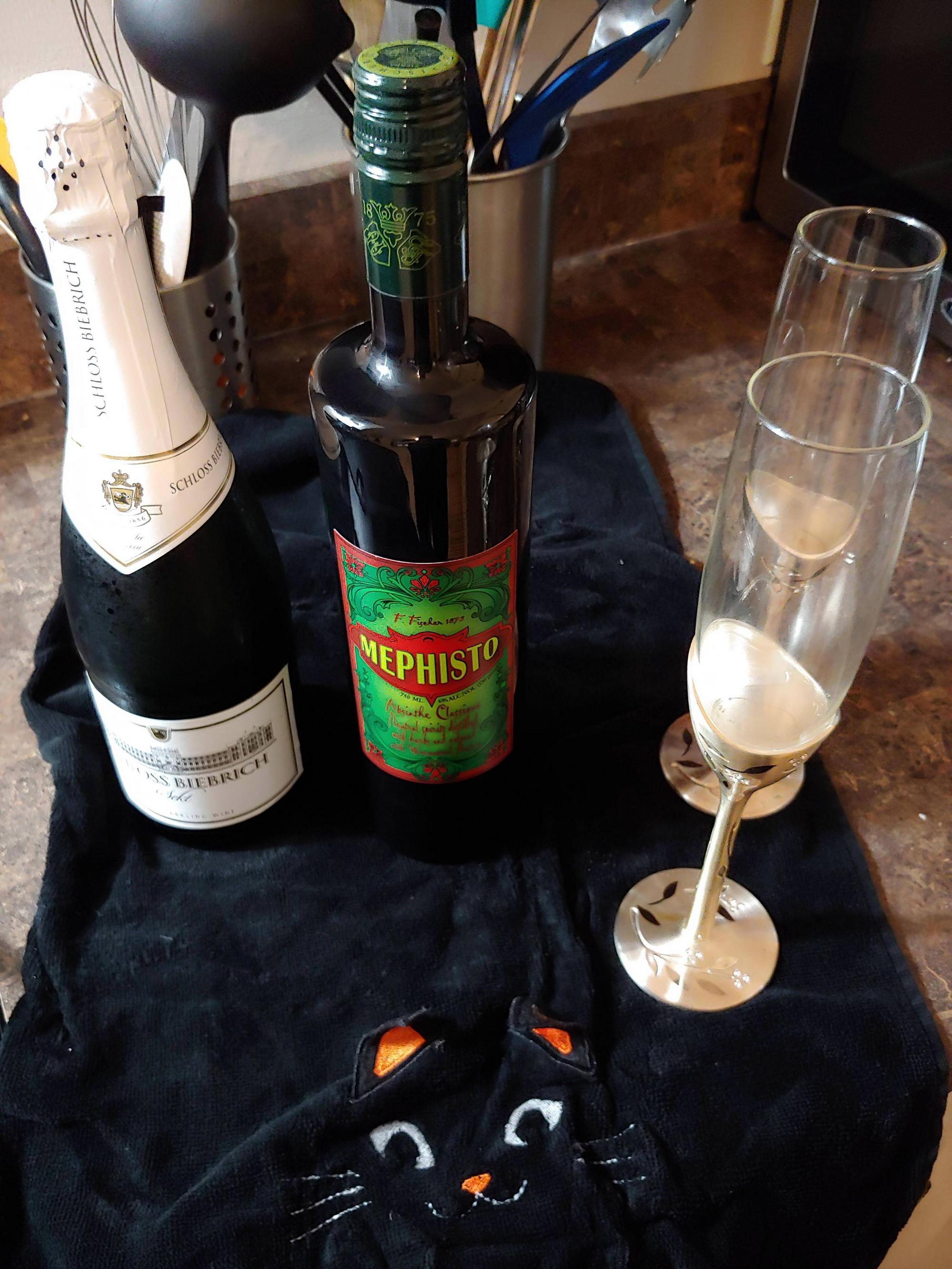
Next time on Kindred the Embraced: The basic mechanics of this game. Hope you like Shadowrun!
Rules
Original SA post
Vampire: The Masquerade (2nd Edition)
Preface
Chapter 1: Introduction
Chapter 2: Setting
Interlude: A History of Face Grabbing
Chapter 3: Storytelling
quote:
Rule, after you have first learned to submit to rule.
William Shakespeare, Northanger Abbey
Chapter Four: Rules
I have terrible, horrible, no good very bad news: it’s time to talk about rules. Vampire give the impression that its authors would rather talk about anything else but rules. Because that’s what they do. Before the chapter even begins, there’s an excerpt from the Book of Nod, telling the story of Caine in pseudo-biblical language. Since I haven’t spelled out the mythic prehistory of the setting yet, I suppose I must.
As you know, God cursed Caine with vampirism with killing Abel. He founded Enoch, the First City, where he was worshiped as a god. Out of loneliness he created more vampires, but regretted it and forbade the practice. A great Deluge destroyed the City, and Caine took it for divine punishment, leaving forever. His grandchilder rebuilt the City and founded Clans, but vampire overpopulation ignited a war...the first Jyhad.
The survivors built what is only known as the Second City. Fearing another war, they forbade the 4th Generation to sire more vampires. But the Second City eventually collapsed after a long and unexplained decline, and the Kindred were forced to flee. Since then, a cycle has repeated itself: as more vampires are created, they inevitably come into conflict, while the elders remain in hiding and consolidate power. Now vampires hide from mortals and each other, and Jyhad is an eternal cycle.
But This is the Rules Chapter, Right?
Sure. Right after a page of fiction about a vampire about to attack a woman, but chickening out.
And a cool picture of Count Orlok.
And an overview of the rules that begins with quotes like “You need only learn basic rules, but their permutations evoke the flavor of the game to reflect the true complexity of real life.” And “Rules are like the myths which shape and describe a culture. They define what is important and delineate the possibilities of existence.”
And a quote from Plato.
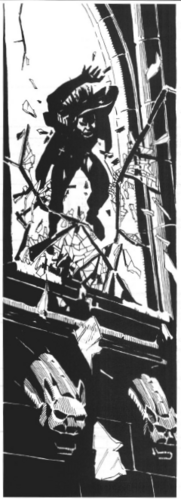
No! No more quotes! I...oh, hi Mom. Hi Dad.
Bleeding Jesus Just Tell Me How to Roll Dice
Okay, okay! First, Vampire explains how it measures time. A turn is enough time to complete one action--a few seconds in a fight scene, a few minutes in a social scene. Speaking of which, a period of action or roleplaying in a single location makes up a scene. A chapter is several scenes of action and downtime, comprising the typical game session. A story is a story arc within a campaign. Vampire calls a campaign a chronicle, and defines it as a series of connected stories, perhaps with an overarching theme or plot.
As for the dice, it’s pretty simple. It’s a d10 dice pool system. Characters have various Traits, rated 1-5. Roll your Trait in dice, and count any dice that meet or exceed the Difficulty as successes. The Difficulty can range from 2-10, with 6 as the standard. One success means you barely made it, three is a complete success, and five is exceptional and impressive.
Most rolls are Attribute+Ability (e.g.Dexterity+Firearms, Charisma+Etiquette), so barring superhuman powers, you’re rolling 1-10 dice. An interesting innovation for the time is that different Attribute+Ability pairings are possible, even ones that don’t seem like common sense. Given examples include Stamina+Acting to hold up under prolonged interrogation, Dexterity+Streetwise to slip out of handcuffs, or Manipulation+Brawl to square up and show some mean drunk that you mean business and he should fuck off.
An important rule to single out is the Rule of One. Any 1s you roll count as anti-successes. If you roll more 1s than successes, you botch, a critical failure with nasty consequences. The Storyteller system has often been criticized for this: without going into detail, it produces wonky dice math as your pool increases. It also means that on a Difficulty 10 roll, you’re as likely to botch as to succeed no matter how many dice you’re rolling! The text explicitly calls this out and says you should rarely if ever call for a Difficulty 10 roll.
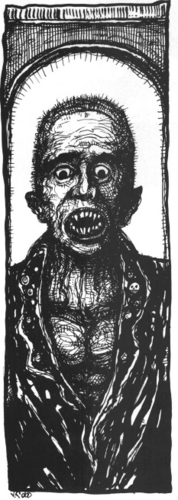
All that nonsense just to tell me it’s Shadowrun with ten-siders?
Special Actions
A resisted action is when two people are competing or one is resisting the other--like trying to sneak up on someone, or an exchange of wits. You both roll and the higher number of successes wins.
An extended action happens over a period of time. It could be a very long time with each roll representing days of work, like creating a work of art or conducting research. It could also be a race-against-the-clock scenario in one scene, like escaping a burning building. Whatever the case, you keep rolling, and try to accumulate a given number of successes. Failing might mean you have to start over; botching almost certainly does.
An action can also be both extended and resisted--a car chase is a good example. Both opponents are in a race to accumulate a given number of successes first.
There are also rules for teamwork, where both characters roll and add their successes together, usually on an extended action like collecting information or creating something.
Last is the Gooolden Ruuule. Which is: every rule besides the basic die mechanic is just a suggestion. Do what you want. Thanks, Vampire!
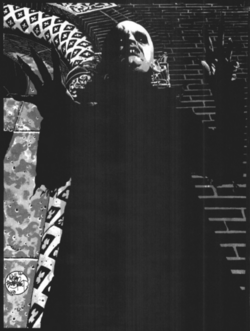
Do it! Say “Chubby Bunny!”
Next time on Kindred the Embraced: Character creation.
Character
Original SA postSomebody say Thaumaturgy?

Vampire: The Masquerade (2nd Edition)
Preface
Chapter 1: Introduction
Chapter 2: Setting
Interlude: A History of Face Grabbing
Chapter 3: Storytelling
Chapter 4: Rules
quote:
Character is what you are in the dark.
James O’Barr, Human, All Too Human
Chapter Five: Character
The character creation chapter is strangely unsatisfying. It coaches you to come up with an interesting character concept, gently leads you through the process of spending your points on traits, and explains those traits briefly in terse sidebars, leaving the detailed explanations for a following chapter. That’s standard.
What’s not standard is sandwiching another chapter, on crafting a campaign, in between the two! So Chapter 5 is character creation, Chapter 6 is Chronicle creation, and Chapter 7 explains all the Traits, including the ones you care about most: the Kindred Clans and their supernatural powers. It’s good that Vampire devotes a lot of pagecount to “How do I run this?” since it’s an innovative, dungeon-unfriendly game. But the layout is a spasmodic fever-dream.
This is probably why I’ve never read Vampire cover-to-cover before. After the introduction, I skipped to the middle of the book and read about the Clans and their cool vampire powers. Didn’t everyone? I carried this habit forward to most games I’ve owned.
Nonetheless, I can’t think of a better, nonsequential way to cover it. Guess I’ll just give short shrift to campaign-building on my way to those cool vampire powers, like I did when I was 13.

I’m the best character in Hackers. Admit it.
Vampire emphasizes coming up with a strong character concept before you even think about how their abilities are measured in stats. It features a sidebar with a list of one-word concepts that you can build on, and uses a cooking metaphor to describe how you have to let some ideas sit and stew for awhile before they form a nuanced personality that’s more than a one-note stock character. Since no one is born a vampire, you’re encouraged to develop your character with their mortal life in mind. The only hard limit is that you’re a 13th Generation Kindred with no more than 50 years of experience as a vampire. You can play a character born in the distant past, but that means something happened to put you in hibernation for a long, long time. Vampire suggests that you spend the first session creating characters together, and insists you create characters that can get along. Kindred may be vicious, selfish creatures, but by the same token, a coterie doesn’t survive without mutual trust.
There are seven Clans from which players can choose, which get full write-ups later. From a mechanics point of view, each Clan has a unique weakness, and three Disciplines where you spend your starting points and get an experience point discount later on.
Brujah: Rebels.
Gangrel: Nomads.
Malkavian: Crazy.
Nosferatu: Ugly.
Toreador: Artists.
Tremere: Wizards.
Ventrue: Rich.
Caitiff: Clanless.
Nature and Demeanor is an optional rule, but in my experience, everyone uses it. There’s a list of personality traits, like “Survivor” and “Visionary” and “Caregiver,” and you can choose one to be your Nature (true self) and Demeanor (public self). Your Nature gives you a situation in which you recover a point of Willpower, which is why people like using this rule. It doesn’t have much impact on the game, but it’s a tool for character-building with a mechanical benefit.
Now we get to the meat and potatoes. Vampire has nine basic ability scores, called Attributes and divided evenly into 3 categories: Physical, Social, and Mental. You don’t just get a big pool of points to spend, you have to prioritize. You start with 1 dot in--
Oh, I forgot to mention. Since everything runs on a 1-5 or 1-10 scale, the character sheet has you stat out your PC by filling in dots, and points in a Trait are literally called “dots.” Vampire was my first RPG, and it seemed intuitive enough to me.
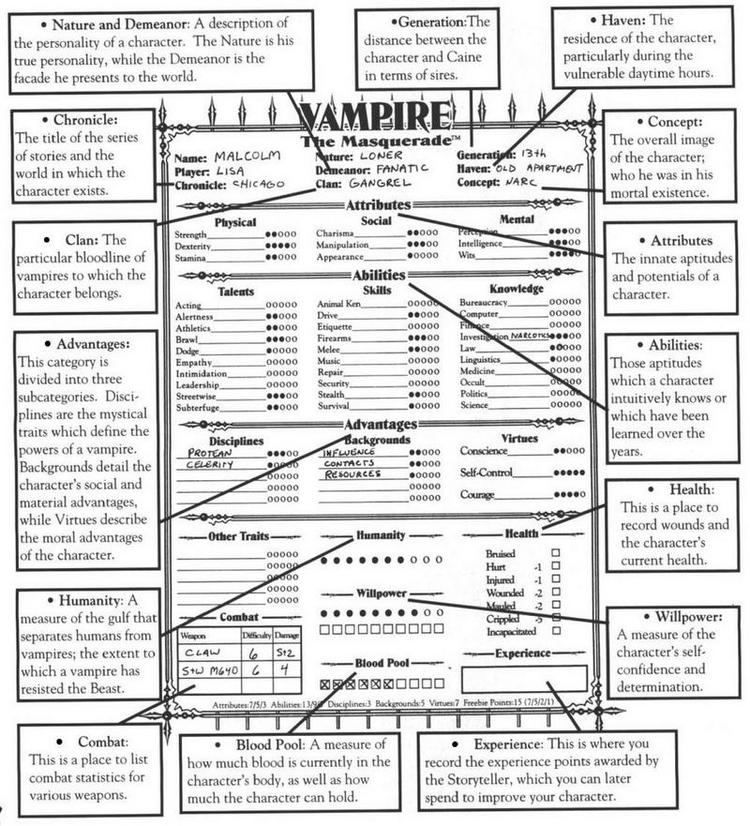
The game devoted a lot of effort to easing potential players into the concept and the rules.
You start with 1 dot in every Attribute, and get 7 more in your primary category, 5 in the secondary, 3 in the tertiary. Since the human average is 2 and anything over 5 is superhuman, you’re playing very capable characters even before you get into the spooky vampire tricks.
Vampire’s skills are called Abilities, and these are also divided into categories: Talents, Skills, and Knowledges. You get 13 points to spend in your primary, 9 in your secondary, 5 in your tertiary. I'm not going to list them all out.
You get 3 dots to spend on your Clan’s Disciplines--supernatural powers beyond the ones that every vampire has.
Animalism: Controlling animals.
Auspex: ESP.
Celerity: Breaking the combat system.
Dominate: Mind control.
Fortitude: Super-tough.
Obfuscate: Super-stealth.
Potence: Super-strength.
Presence: Super-charisma.
Protean: Shapeshifting.
Thaumaturgy: Creepy blood magick.
Backgrounds are neat. Vampire has an ahead-of-its-time set of Traits for measuring advantages that go beyond Attributes and Abilities like wealth, contacts, and social status. Unfortunately, some of these have a clear mechanical advantage while others are rather vague.
Allies: Humans you can call on for aid.
Contacts: Sources of information.
Fame: What you get when things are hollow!
Generation: You come from a lower Generation, meaning a bigger Blood Pool. You’re going to buy as much of this as the Storyteller will let you get away with.
Herd: Mortals you can feed on without hassle.
Influence: Political power.
Mentor: An elder Kindred who supports you.
Resources: Money, baby.
Retainers: Renfields.
Status: You have respect and standing among Kindred.
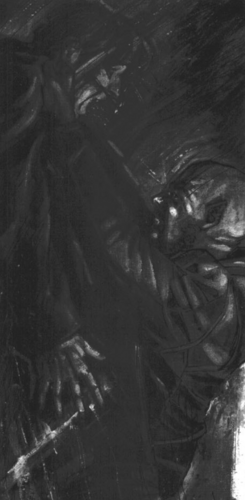
Here’s where it gets weird. The internal struggle of being a bloodsucking monster is part of the rules of the game. Characters have three Virtues, as well as a Humanity and Willpower stat. You start with 1 dot in each Virtue and have 7 more to spend.
Conscience: When you do bad things, you feel bad about it, and thus do not lose Humanity.
Self-Control: You can resist going into frenzy. Frenzy is dangerous and stupid and very very funny.
Courage: You can resist fleeing from fire and sunlight.
Your base Willpower is equal to Courage, and you should raise it higher. You can spend Willpower points to boost rolls, and you roll it for stuff like resisting mind control.
Your base Humanity is equal to Conscience+Self-Control. Your Humanity limits how well you interact with mortals, and if it drops to zero, you lose your mind and become an unplayable beast that only exists to feed and sleep.
(One of the oddities of the World of Darkness is that werewolves, mages, and most other PC types don’t have a Humanity stat to worry about. They’re free to be serial-killing, puppy-kicking, landlord cops, and even the “good guy” factions often tolerated some mass-murdering lunatics among their ranks. But Kindred angst out and they go crazy when they do that shit.)
Your Blood Pool is your fuel. You consume a Blood point every night you wake up, you can spend it to boost your Physical Attributes, and Disciplines often cost Blood. You roll a d10 to determine your starting Blood Pool.
Finally, you get a pool of 15 Freebie Points to spend wherever you didn’t have enough dots--with varying costs. (Was Vampire the first game to do this? Maybe.) Disciplines are the most expensive, while Backgrounds are cheap, so you can buy up Generation while no one is looking.
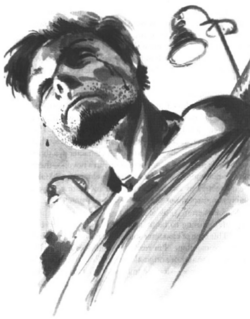
All cops are bastards

Just because Vampire exhorts you to create a complex, well-rounded character doesn’t mean that said character can’t be a gritty action movie protagonist. The example of character creation introduces us to Malcolm, a bitter ex-cop in the Dirty Harry mold who is clearly set up to become a vigilante. Malcolm can’t be a cop anymore*, but he was a narcotics detective and still has scores to settle with drug dealers. So Malcolm is a violent, amoral bloodsucker...and now he’s a vampire too!
*Vampire often ignored the fact that living a more-or-less normal life as Kindred is virtually impossible. How do you hold down a day job when daylight burns you up like an oily rag in a fireplace?
Malcolm’s Nature is Loner, and his Demeanor is Fanatic. He’s a workaholic undercover cop so he can be alone. The details of how all his points are spent is not that interesting, but I’ll point out some highlights: all 3 Discipline dots are spent on Protean, because Malcolm’s player wants to eventually get that cool power that lets you transform into a wolf. Some Freebie Points are spent on a dot of Celerity, because super-speed is good. Malcolm’s Conscience of 2 and Self-Control of 5 give him a total Humanity of 7, which is the human norm, and surprising given that he is explicitly an asshole with a dismal view of human nature. Speaking of which, the player decides that Malcolm prefers to feed only on drug dealers and addicts, and is consequently becoming an addict himself, though this has no mechanical effect (at least not yet). He also has a Contact named “Sgt. Grabowski” and another named “Softshoe.” Man, you corny.
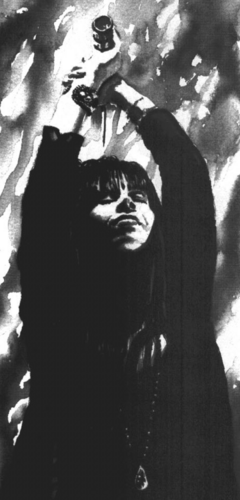
Every woman I have ever dated shows up in this game’s art somewhere. Creeps me the fuck out.
That's it as far as mechanics are concerned. Next is some duh-no-shit stuff: describe your character’s appearance, list your Contacts and retainers, and describe your lifestyle. Equipment is basically just a matter of listing whatever notable gear you could reasonably afford based on your Resources or a grant from the Storyteller.
The Prelude is a brief, one-player scenario designed to get a feel for the character and how they react in different situations. (I’ve never played in a group that used the Prelude, but I think it’s a good idea, and something you could do at the same session where you’re creating characters.) It’s meant to have personal stakes or none at all, with no combat. Things like “You come home from work, but your key doesn’t work…what do you do?” Another suggestion is “Your father is dying in the hospital, but visiting hours end before sundown.” It’s also an opportunity to explore and justify the characters Backgrounds (e.g. where they get their Resources or who their Contacts are).
Character creation ends with a Questions and Answers section to help fit your character into the game world. In addition to stuff about your childhood and your job are things like “Who was your sire and how did they treat you? How did the Embrace change you? Where do you make your haven and where do you hunt? Has the Prince accepted you?”
Next time on Kindred the Embraced: Chronic Chronicle Chreation
Chronicle
Original SA postNight10194 posted:
I find the issues often crop up when something doesn't examine that part of itself, or is ashamed of it and tries to layer sexual menace and muck all over it to make it 'mature'.

Vampire: The Masquerade (2nd Edition)
Preface
Chapter 1: Introduction
Chapter 2: Setting
Interlude: A History of Face Grabbing
Chapter 3: Storytelling
Chapter 4: Rules
Chapter 5: Character
quote:
Acts of injustice done
Between the setting and the rising sun
In history lie like bones, each one.
--Siouxsie and the Banshees, “Porphyria’s Lover”
Chapter Six: Chronicle
This chapter is about crafting the campaign and fitting the player characters into it. Oh, I’m sorry, it’s about crafting a chronicle for your troupe. The advice given here is a mixed bag. Some of it is innovative, some is woefully of its time, some is just strange. But you can’t say that Vampire suffers from the “But what do I do with it?” problem that often befalls unique games. This chapter provides many seeds for campaign themes, roles for the player characters, individual storylines, and conflicts to set them up.
Vampire was written before it became common practice to use the first meeting as a “jam session” where the players create characters together and the GM solicits player input to build the setting. The GM is advised to ask the players about their characters and incorporate that into the chronicle design, but also discusses chronicle design as if you are doing this while the players create their characters, so the procedure is a bit murky.
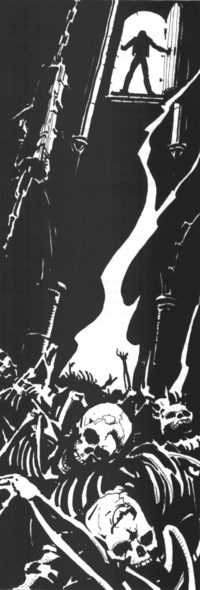
Hm. Well, there really ought to be a handrail here.
Elements of a Chronicle
The foundational element of a chronicle is its Motif...and Vampire’s understanding of that word is very broad and very weird. In narrative art, “motif” usually describes specific, recurring symbols. The appearance of smiley faces and clocks in Watchmen, the phrase “Valar morghulis” in Game of Thrones, and many of John Williams’ leitmotifs are famous examples.
Vampire does give some appropriate examples, like an outdoor statue or a rambling bum who gives cryptic insights. But it understands motif to mean “anything that recurs in a story,” so most things the Storyteller does are part of the motif. The overarching theme of the campaign? Motif. Your conversational style with the players? Motif. House rules? Motif. Everything you do to establish theme, mood, and atmosphere is part of one big Motif.
The book has already gone over these topics separately and together, so I don’t know why it’s so confused here. Maybe this is what happens when you split the “how to GM” stuff into separate, disconnected chapters.
After motif comes Setting. I think this is one of the game’s greatest but least acclaimed virtues. Its “Gothic-Punk” aesthetic requires that it be set in a city, it is perfectly clear why Kindred need to live in cities, and it wants you to create an urban setting that, to invoke a hoary cliche, is a character in itself. That said, little space is devoted to discussing how to bring a city to life. You’re advised to purchase travel guides and contact the Chamber of Commerce, along with some vague advice about adding historical and geographical detail as you go.
More important and complex than the mundane geography and politics of the city is the Kindred power structure. You must answer questions such as how many factions are involved and their standing with one another, who are the most important Kindred, and whether the Prince is a dictator or a puppet or something in between.
The player Characters are a vital element in themselves. You should ask the players how their characters know each other and make sure that they have a reason to stick together beyond being allies of convenience. You can use the “Prelude” method we discussed earlier to fit the PCs into the campaign setting. It acknowledges that while Kindred society is rife with intrigue, a campaign that’s nothing but the PCs backstabbing each other won’t be about anything or go anywhere...unless that’s what everybody wants! There is some solid advice here about catering to the players’ instincts instead of trying to herd cats; if they’re “incorrigible anarchists” then shit, let them play anarchs!
But this is quickly followed by advice to use “a system of rewards and punishments,” i.e. experience points and the Humanity rules, to tame uncooperative players. No! Bad game! Bad!
While this is a game of moral dilemmas and “personal horror,” you still need Antagonists to fight. They suggest having a big, chronicle-defining archenemy who is diabolically evil. This could be the Prince, an ancient Methuselah secretly controlling the city, or something more mundane. You should nurse the players’ hatred by having the villain thwart their endeavors. They suggest making the villain very powerful--not to slap the coterie around, but so that the coterie has to play it smart, do the legwork, and erode the villain’s power base.
Another way you can play it is to have a group of enemies who are more on the coterie’s level, so that personal rivalries can emerge. One suggestion is a Sabbat pack whose members are a dark mirror to the PCs. Sounds like a really fun idea for a one-off, since in the corebook, the Sabbat are just characterized as crazed Satanic spree killers.
The last element is an overall Scheme for where you want to chronicle to go. Vampire has a reputation for being very railroady, to the point of inspiring other games to follow suit. But it says up front that your chronicle will probably be very different from the initial concept, and if it isn’t, you’re being too controlling. So the scheme is just a rough outline, a tool to help you manage the pacing and maintain the atmosphere, so that the chronicle has a satisfying beginning, middle, and end. It’s particularly important to stage a grand finale when you’re ready to wrap it up.
This section also touches on the possibility of setting chronicles in the distant past, versus setting it in the modern day. While a historical chronicle can allow for months, years, even decades of downtime between sessions, a modern chronicle will be much more day-to-day and week-to-week...because Gehenna is approaching! I’ll go into more detail on Gehenna later. I’ve long thought that Vampire contains a handful of big themes, and no single chronicle has room for all of them. Gehenna and its theme of impending millennial doom--and all the related metaplot--is one of those Big Themes that some groups will make their game all about, and others will completely disregard.
Anyway, Caine did 9/11.
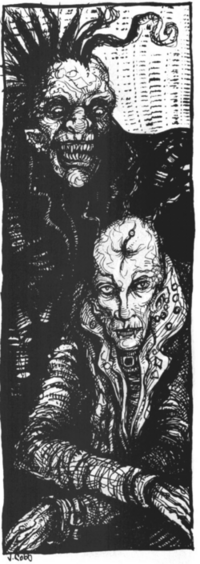
Grandma was a punk rocker
Chronicle Archetypes
Like I said, Vampire isn’t lacking in the “what do I do with this game” department. They provide a list of over a dozen models for a chronicle to follow.
Gang: You’re a vampire street gang. Your turf is your hunting ground, which you protect from mortal gangs and poaching Kindred. You’re anarchs openly defying the Prince, but you have to respect the Traditions at least enough to keep the Justicars from coming down on you. Interesting possibilities include being affiliated with mortal gangs that the players get to characterize and lead, or being elder-sponsored “counterterrorists.” Fuck the police.
Wanderers: Hey, Near Dark is one of the best vampire films ever! Unlike most Kindred, you are nomads, roaming the earth in search of blood and a safe place to sleep. This makes for a picaresque chronicle where the PCs are concerned with the basics of survival, rolling into a new town only to be forced out in order to stay one step ahead of trouble. Wherever they go, established Kindred will resent their presence, and they’ll have to tangle with Lupines sooner or later. (The 2nd edition was published in the same year as Werewolf, so all we know about werewolves is “they control rural areas and they hate vampires.”)
Rock Band: Vampire is excitement! Vampire is adventure! Glamour and glitter, fashion and fame! Yeah, so maybe your whole band was Embraced by the same vampire, or you got together later. You have to decide who plays what instrument according to stereotype. And if you’re successful, you have to figure out how to go on tour when the only safe way to travel is in a shipping container.
Refugees: You came to this city fleeing something bad. You’re probably not supposed to be here and the established Kindred probably regard you as trash.
Historical: This is where the seeds of the Dark Ages line were planted! While you can play in any era, the obvious choice is medieval Europe, since Kindred society still follows a model of feudal vassalage today. You’ll probably be playing members of the nobility, but that just means that you’re caught between servitude to monstrous elders and fearful, restive peasants.
Primogen: You are the primary (perhaps only) Kindred of a medium-sized city. This chronicle emphasizes power and responsibility instead of being a pariah surviving on the margins. The Storyteller has to contrive crises for the PCs to deal with, which will typically involve external threats from factions of Kindred looking for a new city to make their own.
Prince’s Brood: The coterie are all the childer of the Prince, who may be a noble who sees them as heirs or a monster who sired them to be disposable pawns. This chronicle calls for giving the PCs more points, but they also have the thankless job of doing the elders’ dirty work while controlling the discontent anarchs.
Mortal Politics: Control of local government institutions is a huge asset for Kindred. The PCs will be involved in mortal political campaigns, leveraging their Backgrounds to handle the aboveboard stuff and using their vampire powers to commit all sorts of ratfucking.
High Society: The coterie is part of high society and concerned with its scandals and intrigues. This overlaps with some other archetypes so much that it seems like a weak premise on its own.
Archons: The coterie are the minions of a Justicar, one of the high officials that keep the Camarilla intact. You are powerful and feared, traveling from city to city cleaning up messes to maintain the status quo. It’s suggested that you use the premise to introduce moral dilemmas and minor crises that hint at big-picture conflicts.
Fanatics: The coterie is part of a violent extremist group, like IRA partisans, Muslim fundamentalists, or eco-terrorists. LOL no one would ever actually do this. (I don’t know why people in the 90s though “eco-terrorists” is something that really exists.) Bits like this are where you start to see the emergence of obsessively edgy character options that no one actually played--at least, not with the same group more than once.
Cult: The coterie has started a cult so they can have minions and easy access to blood. The game is up front about the fact that this is an Evil Campaign even by its own standards, and the coterie are abusing and cheating these people. The Humanity rules should be central to this chronicle.
Patrons: The coterie are the patrons of some mortal organization like a business, a charity, or even a sports team (The Bad News Brujah!). You’re do-gooders, and you have to balance that with being a bloodsucking freak. The more you succeed, the more is expected of you.
Other World: If you want to set your game in a cyberpunk future or a Tolkienesque fantasy, they’re not going to come to your house and stop you.
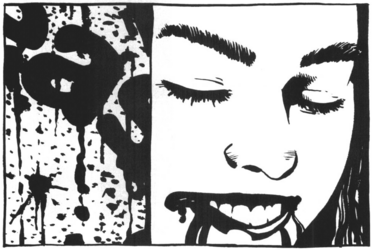
Peas! I love ‘em!
Creating a Story
The section on creating storylines and individual sessions shows a more nuanced understanding of storytelling elements, instead of mashing a slew of concepts together as “motif.” Again, belying the game’s reputation for being railroady, it advises you to give the players a pressing problem, then get out of the way and let them deal with it. It also advises you to find inspiration in newspaper headlines, because “vampires are behind many major disruptions in the world, so the repercussions of their conflicts are sure to end up in the news.” How much influence Kindred have over world-historical events is something White Wolf would go back and forth on through the history of the product line.
Every story needs a theme, which Vampire understands to mean a moral or philosophical question that is posed but not answered. Given examples are grouped into categories like Love, Hate, Chaos, Morality, and Society, and are big-picture dilemmas like “How is love both a weakness and a strength,” and “Are there any ultimate moral truths?”
Conflict is the basis of any story. While Vampire deals with a lot of internal moral and psychological conflict, that’s difficult to deal with in a group setting, and most of the given examples are conflicts with enemies who want to kill you or aggrandize themselves at your expense. It does note that Kindred are political animals and their conflicts don’t always have to come to violence. There’s a list of sample conflicts, which overlap a great deal.
Kindred vs. Lupines, Kindred vs. Hunters, and Camarilla vs. Sabbat are about fighting off an irreconcilable enemy that wants you dead. As I’ve said, Lupines and the Sabbat haven’t yet been detailed beyond “they’re bloodthirsty and they hate you.”
Humanity vs. Beast, Sanity vs. Madness, and Survival vs. Justice are about those mostly internal struggles. These are clear concepts, but how to realize them in a session is an open question.
Kindred vs. Kindred, Clan vs. Clan, and Kindred vs. Prince concern intrigue within Kindred society. Factions fight each other for influence over mortal affairs and control of hunting grounds. The Prince’s dominion in these matters is not always a sure thing.
Anarchs vs. Elders and Elder vs. Elder bring in that punk element of generational conflict. Kindred politics are worse than mortal politics in every way. The interests of the old and young can’t be reconciled, the elders mostly reproduce to use their children as pawns, the old want to hang onto power forever, and they have all the advantages except numbers.
Kindred vs. Society and Kindred vs. Victims concern the Masquerade. The PCs might find themselves hunting mortals who fight back, and threats to the Masquerade can’t be easily solved with skulduggery and magic powers.
Kindred vs. Unknown and Kindred vs. Magi are both “make shit up” categories. I only bring it up to point out that the book mentions mages, but tells us even less about them than about werewolves.
The advice on plot concerns principles for sketching an outline and then handling the pacing of the session. You must begin sessions by setting the scene for the PCs, followed by a hook that grabs their attention and lets them know what’s at stake. There should be a steady buildup of tension approaching a climax, and part of that is making sure that dead-ends and red herrings are dispensed with quickly. They also advice cliffhangers and plot twists to provide excitement and momentary resolution, especially when the story can’t be completed in one session. One bit I particularly liked concerned the denouement after the story reaches its climax--this is a good opportunity for downtime scenes where the PCs can interact with each other without anything at stake, and for the Storyteller to distribute rewards.
The section on creating drama doesn’t give much detail or any examples, but repetitively emphasizes how very important it is to create drama. Granted, this is because there’s a whole chapter on creating drama in the moment, and how to use the game mechanics to do that, much later in the book. There is one particularly good bit of advice, which is to never have a combat where the characters involved are just pulling weapons and blasting each other. It should be like a good set-piece action scene in a movie, where combat is alternated with a chase, or the combat is set in a location that creates a deadly game of cat-and-mouse instead of a straight-up fight.
The following section is on establishing mood and atmosphere to get the players into their characters’ heads and evoke real emotion. It enumerates all the tools the Storyteller has to convey atmosphere, including your voice and mannerisms and the degree of attention paid to different aspects of the scenery itself. For example, building a “dank” mood in an urban environment requires playing up the literal filth and ugliness of the surroundings.
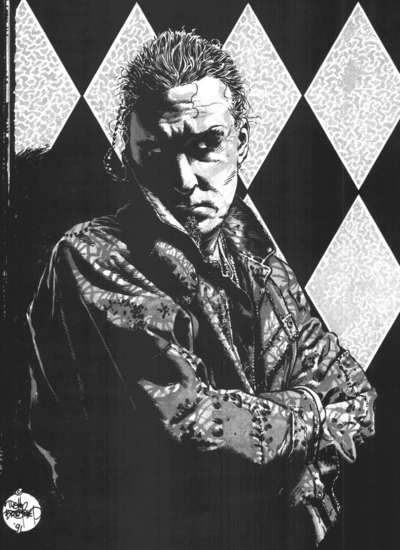
Shut up, you guys. My mom says my soul patch is cool.
Finally, we’re given a list of Story Archetypes that can apply to a single session or an ongoing storyline. They’re divided into three categories: “Mean Streets” is self-explanatory, “Illuminatus” concerns conspiratorial plots, and “Bourbon Street” emphasizes that ol’ time personal horror. I’ve been to Bourbon Street on Halloween, and I was horrified by all the puke. Anyway, these archetypes aren’t premises for a story, but loose bundles of setting, mood, and theme.
Urban Nightmare: Kindred are by nature part of the city’s dark underbelly, characterized by urban decay and poverty. Can the coterie do anything to make this world better, or are they just another disease?
Adventure: Sometimes you just want the exhilaration of combat. The Storyteller is encouraged to give it to them, but not without risks and consequences. (In this entry and the one above, Vampire emphasizes that its Gothic-Punk setting is not so lawless that you can just go around biting people in the street and killing any cops who intervene. There are more of them than there are of you.)
Wilderness Trek: Anything outside the city is “wilderness” to vampires, and rural areas are populated with werewolves, spirits (!), and faeries (!!) who have their own territorial claims. If you give the coterie a compelling reason to leave the city, they’re in a desperate situation.
Diablerie: The only way to lower your Generation is by drinking an elder to death, which is a big part of why elders are such Machiavellian bastards. Plotting the death and diablerie of elders can become a whole campaign and prompt moral questions about who is the real monster and all that jazz.
Jyhad: To the extent that Kindred society goes beyond squabbling over a feeding ground or political asset, it’s truly ancient vampires using their lessers as pawns. If you want to do complicated spy games where agents carry out missions for reasons they don’t understand, and the coterie’s nemesis turns out to have been the one pulling their strings all along, this one’s for you.
Vendetta: Something really bad happens to the players, and they want revenge on the bastard responsible. The only hard part is wounding the coterie without leaving the players feeling like they just got fucked over with no recourse. Make the villain really nasty, then let the players loose, and they’ll do all the work.
Masquerade: A story based on preserving the Masquerade is a good way to get the players to understand that fangs and a few points of Disciplines doesn’t mean they can do whatever they want. Handling a coverup is a job that can’t be accomplished with more violence and magic powers.
Escape: Eventually, the coterie might just have to go on the run from the Prince, the Sabbat, or just the police.
Mission: The easiest way to set up any kind of story you want to do is by having the Prince or some other powerful figure give them a job to do. In my personal experience this is overused, and Vampire anticipated that--it’s better if the coterie has the prospect of a reward, or is doing the mission as a favour or on their own initiative, rather than because a Ventrue Prince waved his Dominate powers around.
Tragedy: Kindred existence is inherently tragic if you give a shit about being a decent person. This doesn’t work if the Storyteller is just fucking over the PCs; instead, it’s about having to constantly choose the lesser of two evils because a vampire’s nature is inherently against them.
The Becoming: You can start the story before the PCs are even Embraced and walk them through the process of becoming vampires, learning to live with it, and eventually breaking their bonds with their sires.
Romance: What’s a vampire roleplaying game if it doesn’t acknowledge romance? Vampires as we know them were born from Romantic literature, after all. Kindred trying to maintain romances with mortal lovers and loved ones are in an inherently tragic situation, and the same principles apply. By the same token, vampires who fall in love with one another are star-crossed: Kindred are solitary predators, and a romance maintained by becoming Blood Bound is necessarily a reckless, desperate love.
Redemption/The Quest: Some vampires don’t give a fuck about fighting for the right to seduce people in a particular nightclub. They want to become human again, or stay as human as possible. They may actually assist mortals against particularly nasty vampires, help other Kindred come to terms with what they’ve become, or even seek Golconda, the legend that a vampire can become human again or at least transcend vampirism.
Normal Life: The coterie are trying to maintain their normal lives. Pretty hard when sunlight burns you up like flash paper. The point here is to draw a sharp contrast between their “normal” life and the necessity of existence as a vampire.
This update was brought to you by absinthe. Absinthe! When you want to experiment with new cocktails but not remember any of the recipes the next day...absinthe!
Next time on Kindred the Embraced: Clans! Disciplines! All the fun stuff, finally, all at once!
Clans
Original SA postmegane posted:
I feel like a lot of WW stuff follows the same sort of pattern. They come up with a passable and straightforward idea, but then I guess they struggle to fill out however many pages of copy about it, since they kinda conveyed the whole idea in two sentences. "Defenders are protectors, who choose a place or group of people and keep them safe. Sometimes this makes them too cautious when aggression is called for."
So in comes the questionable filler stuff -- the stereotype lists, the in-character pontificating, the whiny equivocations about whether drowning babies is really bad, the "twists" and unnecessary examples that weaken and confuse the concept. If they'd just know when to shut up about things it'd be so much more palatable.

Vampire: The Masquerade (2nd Edition)
Preface
Chapter 1: Introduction
Chapter 2: Setting
Interlude: A History of Face Grabbing
Chapter 3: Storytelling
Chapter 4: Rules
Chapter 5: Character
Chapter 6: Traits
quote:
All happy families resemble one another; every unhappy family is unhappy in its own way.
--Friedrich Nietzsche, Exquisite Corpse
Chapter Seven, Part 1: Clans
All the details of the players’ stuff is crammed into one massive chapter that includes Clans, Disciplines, basic Attributes and Abilities, Backgrounds, how Blood is spent, and a few other things.
I’ll start with the clans, of which there are seven. We’re told that these are not the only Kindred clans in existence, but the ones that make up the Camarilla. Each clan gets a writeup which includes sections on their typical background and character concept, how they’re organized, what kind of havens they favour, what they typically look like, and their stereotypical views on the other clans. It also lists their clan Disciplines and a unique supernatural Weakness for each clan.
This formed a pattern that would be repeated in almost every single game White Wolf has ever published, where instead of races and classes, PCs were divided into type based on genealogy or political faction. Sometimes this was shoehorned into games where it didn’t make much sense, namely Hunter: the Reckoning and Mummy: the Resurrection, both published in the waning days of the original World of Darkness. (As Jef of System Mastery pointed out, the Stereotypes sections had a particular tendency to be lists of pompous, snarky insults directed at every other PC faction. Despite Kindred being bitchy and treacherous as a rule, there’s a fair bit of “Yeah, they’re cool” in original Vampire.)
These clans/tribes/guilds/etc. came to be known as “splats” and are still widely imitated in the tabletop business today. The term arose because White Wolf published sourcebooks called Clanbooks, Tribebooks, etc. and the Usenet community collectively referred to them as *books. Some computer nerds pronounce the * as “splat,” hence splatbooks, hence splats.

Also, all the clan illustrations were done by Joshua Gabriel Timbrook, who did a ton of, dare I say it, iconic work for Vampire and other White Wolf games in the form of stark black-and-white character sketches. I have no idea whatever happened to him.
quote:
It's a dog day afternoon
The Clan go bang, and the bang go boom
How you love it, how you like it, and how you get it
Do that damn thing and quit bullshittin’ with it
Clan of Xymox, “Luke Havergal”
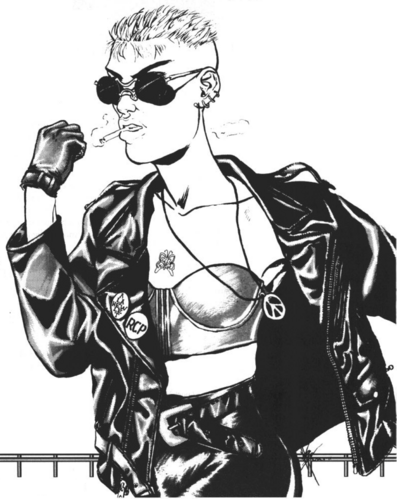
1. Brujah are rebels.
2. Brujah are angry ALL the time.
3. The purpose of the Brujah is to flip out and kill people.
First up, the Brujah! The only thing uniting this clan is that they are all rebels of some kind, never happy with any status quo, and really pissed off about it. Many are political radicals, but their ideologies run the gamut from anarchist to fascist and everything in between, as long as it’s anti-establishment. Others are gangbangers and squatter punks with no firm convictions beyond “fuck authority.” This includes Kindred authority, and the Brujah support the anarchs as an institution.
Regardless of their convictions, Brujah tend to be loud, aggressive, and dressed in outrageous street fashion. They have a well-deserved reputation for being touchy and vengeful, and other Kindred give them a wide berth. They’re disorganized, but tend to band together against common enemies, and any Brujah can issue a clarion call for solidarity if they’re willing to stake their reputation on it. They’re prone to Embrace on a whim and abandon their progeny to sink or swim, and they often make their homes in squats or even by way of home invasion.
The Brujah put the Punk in Gothic-Punk--it’s like the writers were really, really excited about that time Anthrax performed with Public Enemy, and they mashed up gangsta rap and anarchist with fringe politics to create a vague aesthetic. Even their clan logo is an inverted circle-A. They’re not subtle.
The Brujah have become my favourite clan, and I’m not even sure why. Later supplements and editions would expand on their history as a clan of philosopher-kings whose mistakes doomed them to devolve into a rabble of bitter malcontents, and open up their conceptual space to include nerds trying to weld that rabble into a force for good, or at least something better than the Camarilla’s ossified feudal politics. As a goth nerd who hung out with punks, I suppose that appealed to me.
But there’s also a passage in this book that I’m obliged to call out: Brujah may “dress and assume the attitudes of street hoods, neo-Nazis, or even Deadheads.” So hippie burnouts are more outré than fucking Nazis? Why, because Doc Martens are on brand? What the fuck, White Wolf? I will say that in years of playing Vampire, including a couple LARP events, I never met anyone who leaned into this and played a fash skinhead.
Disciplines: Celerity, Potence, Presence. They’re super-fast, super-strong, and look good while they rip people apart. Brujah are the best straight-up combat monsters.
Weakness: Brujah take +2 Difficulty to resist Frenzy, and can’t spend Willpower to prevent it. They get really mad when this lack of self-control is pointed out.
Stereotypes: The Brujah respect the Gangrel and Nosferatu for being tough survivors, and keep the Malkavians at arm’s length. They loathe the Toreador, Tremere, and Ventrue for reasons which will soon become obvious.
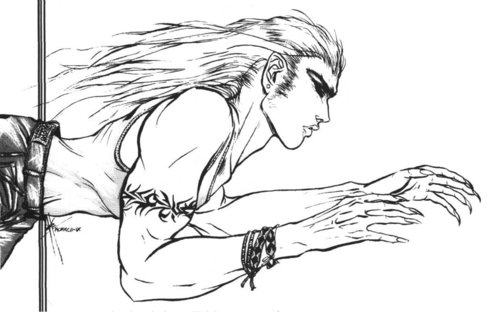
mrhands
The Gangrel are a bloodline of loners and survivors who hardly consider themselves a clan at all, with little in the way of internal politics or recognized leaders. It’s not that they hate cities or other Kindred, they just don’t need them, and they self-select for independence and self-sufficiency. Gangrel choose their childer very carefully, but when they Embrace, they usually leave their progeny on their own for awhile before revealing themselves.
I’m not getting into the Disciplines just yet, but spoilers: Gangrel have a power that lets them meld into the ground. This allows them to make their haven anywhere, and even travel between cities with relative ease. It’s rumoured that they’re even on good enough terms with the Lupines to not have to worry about them.
One weird and cringeworthy aspect of the Gangrel is that they have close ties to the “Gypsies” with legends saying that they are descended from Gangrel himself, and under his protection. I have no idea why the writers were fascinated with Roma stereotypes. It’s one of several strange examples where White Wolf employed 19th-century Gothic literary tropes without considering how they fit into the contemporary world.
Disciplines: Animalism, Fortitude, Protean. The first two are honestly pretty mediocre, but Protean is one of those Disciplines that belongs to a particular clan and can’t be learned by just anybody.
Weakness: Every single time a Gangrel frenzies, they permanently gain some animalistic feature--pointed ears, catlike eyes, a tail, etc. Every five animal features permanently reduces a Social Attribute by 1. This is generally considered one of the shittiest clan weaknesses, and was often house-ruled until later editions changed it to make it less punitive.
Stereotypes: The Gangrel are pretty chill about the other clans. They like the Nosferatu and are ambivalent about the Brujah and Malkavians. They despise the Toreador and the Tremere, and shrug their shoulders at Ventrue politicking.
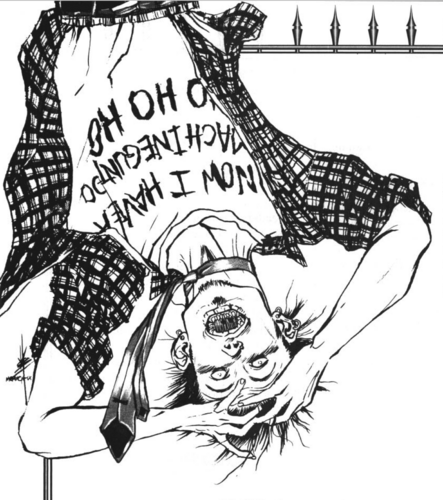
Yeah, that's right, I said playing a Malkavian in Bloodlines is overrated. Deal with it.
The Malkavians are so crazy, you guys! Like, you never know what they’re gonna do next!! You laugh at them because they’re different, they laugh at you because you’re all the same!!! They’re like Deadpool and the Joker, and they live in a society!!!! EPIC BACON CUPCAKE WIN GOOD SIR!!!!!
Yeah, so the Malkavians’ thing is that they’re all insane. They go back and forth on whether this should be played for pathos with a serious treatment of mental illness, or...that. Besides being mentally ill, their sole unifying trait is that they love “pranks.” The Malkavians give a license to That Player who has to be wacky because “that’s what my character would do.”
I’m sparing you all a lengthy tirade about how this is insensitive, disruptive, and frankly low-effort, because I know when I’m preaching to the choir. Some good ideas and interesting NPCs have come from the Malkavians over the years, but nothing that couldn’t be done without specifically creating Clan Monkeycheese. The term “fishmalk” evolved to describe the stereotypical loony Malkavian, supposedly after an illustration of a Malkavian kissing a dead fish.
The writeup of Malkavians’ typical appearance, haven, etc. is tedious because it’s rife with that “Many of them are X, but some are the opposite of X!” cliche that often afflicts this sort of thing.
Disciplines: Auspex, Dominate, Obfuscate. They get the stuff that lets them creep around and get into your head.
Weakness: We haven’t discussed this yet, but Vampire makes mental illness something you write down on your character sheet. They’re called Derangements, and every Malkavian has at least one, which can never be healed.
Stereotypes: I’ll spare you. It’s several variations on “Ho ho, if only they saw the horrifying Truth!”
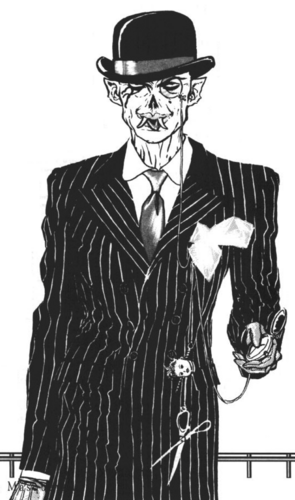
Don’t kinkshame.
Here’s another clan who are defined by their weakness: the Nosferatu are ugly as sin. The Embrace transforms them into monsters with twisted proportions, pustulant skin, bestial features, and disgusting odors. The obvious inspiration is Count Orlok, but Nosferatu come in all shapes and sizes so long as they’re revolting. The art in the supplements explored just how unsettling they can be.
Nosferatu have it rough, and they aren’t even compensated with, say, a great unique Discipline. If you play a Nosferatu, it’s because you really want to play a monster hiding in the shadows. They make their havens in abandoned buildings and sewer systems, and pass unnoticed among the homeless population. They have a reputation for being cranky and lewd, and don’t try to hide what they are.
Under this gruff and gross exterior, Nosferatu are remarkably sane. They know their Embrace is a curse, so they choose people who are lost and hopeless, with the hope that the Embrace can serve as a last chance at redemption where all others have failed. While they usually live alone, they have a very strong mutual support network. Combined with their Disciplines, this makes them the unparalleled information brokers among Kindred. Nosferatu may not have a good side, but you don’t want to be on their bad side.
In my opinion, Nosferatu is one of the best-developed and most interesting clans over Vampire’s lifetime. Their figurative and literal mastery of the underground, the dirt, of everything that falls through the cracks...there’s a lot of opportunity there. And their history and overall concept didn’t get too muddled by metaplot and new character options.
Disciplines: Animalism, Obfuscate, Potence. They can appear out of nowhere and hit you like a truck, then summon a pack of rats to finish off what’s left.
Weakness: Nosferatu have an Appearance of 0 and automatically fail Appearance rolls. They’re obviously inhuman--at best, they could pass for an impoverished burn victim.
Stereotypes: They’re cool with the Brujah and the Gangrel, and distrust the Malkavians, Tremere, and Ventrue. They despise the Toreador and are despised in turn.
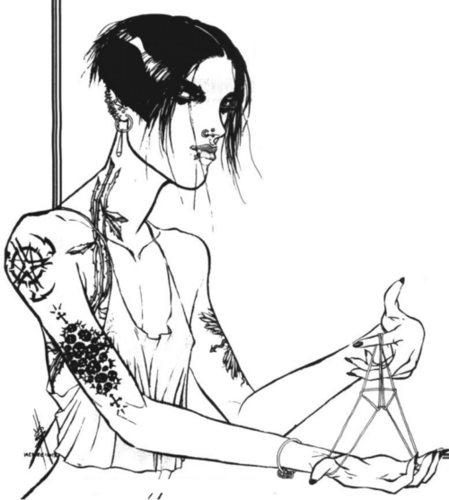
Vampire was way ahead on the whole Soundcloud Rap thing.
The Toreador are lovers of beauty. They hold fast to the belief that undeath is not just a curse, but something to be enjoyed--including pleasures that are beyond the reach of human senses. They cultivate exquisite and expensive tastes, and indulge them to a degree that earns them a reputation for degenerate hedonism. That said, the Toreador are artists, and believe in a higher purpose than pleasure. They seem themselves as conservationists, Embracing the world's finest artists to preserve their talent. The Toreador include some of the greatest artists in history...as well as being the "Lestat" option for those of you who are so inclined.
Toreador are refined and cosmopolitan; even those who were starving artists in their mortal lives acquire these tastes after death, while continuing their artistic pursuits. They are the only clan who keep up with mortal fashions in art, clothing, et cetera, even to the point of being avant garde. Toreador are highly social and meet frequently, but these are typically social events. As a faction, they are too self-involved to be an effective coalition.
So...I don’t like the Toreador. To explain why, here’s another bit of White Wolf fandom: the Chupp Test. It was named after Sam Chupp, a White Wolf employee whose job included engaging the fandom and fielding questions like “Why would anyone want to play a Nosferatu?” The Chupp Test says that the worthiness of any PC faction is measured in how much the writing interests you in playing them. This also applies to sourcebooks about them: If you think Malkavians are stupid, does Clanbook: Malkavian change your mind?
I actually like the Toreador as they're presented in the core rulebook, but the way they were written over time made them less interesting. Supplements actually pulled a 180 on Toreador being preservers of beauty and introduced the idea that unlife gives you time to master your technique, but kills your creative spark. (The exception is a raft of templates whose concept was some variation on “outsider artist”: graffitist, martial artist, metal musician, etc.)
One of the most common Stereotypes directed at Toreador is “Do these spoiled brats contribute anything?” The writing on the Toreador doesn’t even offer any retort! Well, besides “Yes, we’re rich and influential because we’re beautiful and charming. Fuck off, peasant.” You’d think they would emphasize how the Toreador exercise “soft power” to protect the Masquerade in ways that can’t be accomplished with money, violence, and skulduggery, but no. Perhaps I’m wrong and rereading the books will force me to eat crow, but it seemed that they liked the idea of Toreador as a clan of bitchy queens.
Disciplines: Auspex, Celerity, Presence. It's a pretty good haul, because it includes Celerity.
Weakness: The Toreador are prone to becoming entranced by beautiful things: beautiful people, works of art, neon signs, and if they're not careful, even sunrises. The Storyteller decides when this kicks in, and it takes a Willpower roll to break free. This is one of those "So does the Storyteller have the guts to be a dick to you at random?" weaknesses that I'm not fond of.
Stereotypes: They hate the Nosferatu, consider Brujah and Gangrel beneath them, pity the Malkavians, and regard the Tremere and Ventrue as fellow patrons of high society.
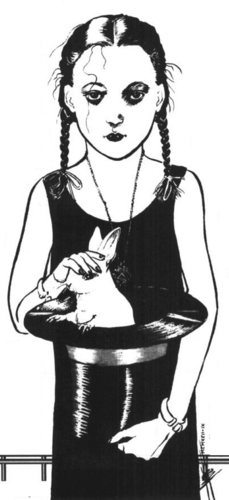
Trust me, fans spent years trying to figure out why they used this picture of Wednesday Addams.
Most clans don’t consider themselves a family. The Gangrel don’t think of themselves as a clan, the Nosferatu regard their bloodline as a curse, and Malkavians often deny that they’re Malkavians at all. But the Tremere aren’t just a family, they’re a conspiracy.
The Tremere began as a mystical sect in medieval Transylvania. They claim that they have no Antediluvian founder, and unlocked the secrets of vampiric immortality through magick. Whatever the truth, their unique Discipline of Thaumaturgy gives them power over vitae itself. They only Embrace ambitious and educated mortals, and groom them for years to be loyal agents of the clan. Tremere are expected to obey their elders without question and always advance the clan’s interests, especially if it means using their own coterie. (What are those interests, by the way? Well, acquiring more power and influence, for sure, but nothing beyond that is explained. Trust your elders and don’t ask questions.)
Tremere don’t do anything to disclaim their image as devious sorcerers, either--they like dressing in formal black outfits accentuated with arcane sigils and talismans. They operate “chantries” in every city where they have a significant presence, a headquarters where Tremere can go for aid and often haven with their fellow clan members. Tremere are the Olive Garden of vampires.
Like I’ve said, I don’t want to get into much detail about the Disciplines yet. But I’d be remiss if I didn’t discuss how Tremere got a reputation for being, well, kind of bullshit.
First of all, Tremere are a PC faction who are openly serving a dual agenda, and really arrogant about it. That’s bound to ruffle some feathers. Second, their clan weakness is kinda bullshit. This is before White Wolf invented Merits and Flaws, but the Tremere weakness is an example of a narrative disadvantage that only comes up if the Storyteller wants to make you the star of the story and give you more opportunities to earn XP.
Last and most important is Thaumaturgy. It’s supposed to be a really scary Discipline that lets you fuck with other Kindred’s blood, but Thaumaturgy 5 is a lot less scary than Celerity 5. However. Thaumaturgy also has Rituals and Paths--bonus powers you can buy with XP that no other Discipline has. Every sourcebook was another opportunity to publish more Rituals and Paths, and even entirely alternate forms of Thaumaturgy, most of which the Tremere get to buy at Clan Discipline rates. This effectively makes the Tremere a wizard class with access to a literal book full of powers no one else gets. Enough to fill a few books, in fact. Some of them are very ill-considered and poorly-balanced. Very.
Disciplines: Auspex, Dominate, Thaumaturgy. No straight-up combat monster stuff, but they get all the spooky wizard shit.
Weakness: All Tremere are taken before the Tremere Council and forced to drink their blood, so every Tremere is already one step toward being a Blood Bound minion of the clan elders.
Stereotypes: Brujah, Nosferatu, and Malkavians are riff-raff. Gangrel are okay. Toreador and Ventrue are rivals, and inferior rivals at that. (The Tremere are the most guilty of Snarky Bullshit.)
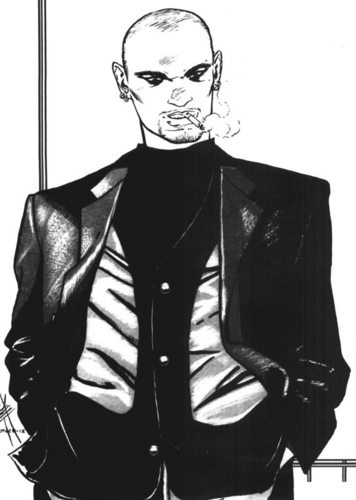
Damn, Uncle Fester looking svelte these days
The Ventrue are noble, sophisticated, and above all, powerful. They Embrace those who are wealthy and influential, and they intend to stay that way...forever. The stereotypical Prince is a Ventrue with an investment portfolio and a cold dead hand gripping city politics.
Ventrue are invested norms and institutions, both mortal and Kindred. They claim they founded the Camarilla, and are the most active in preserving it. They have long traditions of hospitality toward one another and noblesse oblige toward the other clans. God damn it, am I the only one here who gives a shit about the rules?
Ventrue aren’t just about the crude exercise of wealth and power. It’s important to them that they be well-mannered, cultured, and have impeccable taste. But they don’t keep up with fleeting mortal fashions the way the Toreador do. They tend to be set in their ways, which extends to dressing in exquisitely tasteful clothing from whatever century they died in. Are you going to throw shade at them for it? It’s good to be the king.
Disciplines: Animalism, Dominate, Fortitude. Dominate is good, but frankly I think their spread kinda sucks.
Weakness: Ventrue have rarefied tastes. You have to pick some kind of restriction on who you feed from: only beautiful women, only Swedes, only green-eyed male virgin electricians, and so on. It’s really up to you how hard you want to make your unlife here.
Stereotypes: The Ventrue’s genteel sense of superiority means they don’t hate anyone but the Brujah. Gangrel are fine, Nosferatu not so bad, and they regard Malkavians with the same suspicion as everyone else. The “upper-class” clans are good, but not as good as Ventrue. Naturally.

Doesn’t Ol’ Gil get a lick?
Last, and definitely least, are the Caitiff, the clanless vampires. Some young vampires just don’t have a clan...since clans are bloodlines, I don’t get how that works and they don’t really explain it. I suppose if your sire immediately abandons you, and you never find other members of your clan to school you, its supernatural advantages and disadvantages don’t take. Caitiff are generally assumed to be hopeless outcasts who will fall in with the anarchs, if anyone will have them at all.
Much later, the concept of the Caitiff was more-or-less supplanted when they introduced “Thin-Bloods.” Long story short, it turns out 13th Generation vampires can Embrace, but the results are shitty half-vampires.
The Caitiff were the first example of White Wolf games having a “non-splat splat.” For more information on what I think of this, check out my review of Tradition Book: Hollow Ones.
Disciplines: None. Caitiff can put their starting points in whatever they want, and pay for all Disciplines at a rate in-between clan and non-clan. Over time, this is generally an advantage.
Weakness: Also none. I suppose this is compensated by being treated like shit. This is another thing where the text is unclear, so expect your Storyteller to give you grief if you want to be of a lower Generation, or have Status, or take unique Disciplines like Protean or Thaumaturgy. Caitiff are supposed to be the cast-off dregs of Kindred society.
Stereotypes: None. Caitiff don't get a writeup. But attitudes toward the Caitiff range from pity to "exterminate on sight."
Next time on Kindred the Embraced: Attributes and Abilities, and a little thing called...Personality!
Traits
Original SA post
Vampire: The Masquerade (2nd Edition)
Preface
Chapter 1: Introduction
Chapter 2: Setting
Interlude: A History of Face Grabbing
Chapter 3: Storytelling
Chapter 4: Rules
Chapter 5: Character
Chapter 6: Chronicle
Chapter 7, Part 1: Clans
Chapter Seven, Part 2: Traits
Following the clans, the Traits chapter details everything else you write down on your character sheet. This includes not only your stats, skills, and super powers, but unique narrative traits like Virtues and Humanity.
Much of Vampire’s reputation is built on its narrative mechanics. It wasn’t the first game to do so, but it introduced them to a conventional game structure in a way that players found accessible and intuitive. Humanity was the big one, but there are others. The first I’ll deal with is Personality.
quote:
The clearest indication of character is what people find laughable.
--Morrissey, “Cult of Personality”
It appears that Rein-Hagen, like way too many game designers, was into Jung and Campbell. Every Vampire character has two Personality Archetypes, noted as “Nature” and “Demeanor” on your character sheet. The former is the true self, while the latter is what you present to others.
The text regards these Archetypes as important and versatile tools for realizing your character as a complex, multilayered individual. Mechanically, your Nature allows you to earn back spent Willpower points by doing things that satisfy your central motivations. A very forward-thinking aspect of this mechanic is that it’s player-driven: they ask for the points when they think it’s appropriate, and the Storyteller judges whether it’s meaningful enough to be worth it. Demeanor has no mechanical impact.
Nature and Demeanor are the ignored middle children of Storyteller’s narrative mechanics. They’re always there, and White Wolf fans will recognize them immediately. But except in specific cases, they don’t interact with the Humanity rules or other narrative mechanics that are more central to the game. And you know, that’s okay. You can invoke these rules often, or set them aside entirely, without it having a huge effect.
Architect: You care less about the here and now than about leaving a meaningful legacy. Regain Willpower when you create something of lasting value.
Bon Vivant: Bite, drink, and be merry, for tomorrow we die! Regain Willpower when you can really cut loose and have a good time.
Bravo: You live to bully other people. Regain Willpower when you coerce someone into letting you have your way.
Caregiver: You need to be needed. Regain Willpower when you protect or nurture someone else.
Child: You never really grew up, and want others to take care of you. Regain Willpower when someone helps you for no apparent gain.
Conformist: You fear chaos, and instinctively throw your lot in with whatever leader or movement seems like the surest bet. Regain Willpower when your cause succeeds thanks to you.
Conniver: Why work when you can get something for nothing? Regain Willpower when you get what you need through deception.
Curmudgeon: Everyone is foolish, except you! Regain Willpower when you see someone fail, just like you said they would.
Deviant: Your beliefs and desires are radically different from most people’s, and you’re not sorry. Regain Willpower when you flout the status quo and get away with it.
Director: You fear chaos, and you deal with it by taking charge. Regain Willpower when you act as leader and accomplish something.
Fanatic: You believe in a cause so powerfully that it consumes your life. Regain Willpower when you further it in some way.
Gallant: At heart, you’re a performer who lives to impress other people. Regain Willpower when you dazzle someone with your charms.
Jester: But you see, doctor...I am Pagliacci! Regain Willpower when you lift your spirits and those of others through humour.
Judge: You’re a born diplomat who believes all differences can be resolved by getting people to see reason. Regain Willpower when you sort truth from lies, or intervene to settle a dispute.
Loner: For whatever reason, you’re happier when alone. Regain Willpower when you accomplish something by yourself that still aids the coterie.
Martyr: You feel a drive to suffer for your beliefs, whether that comes from genuine compassion or a personality disorder. Regain Willpower when you sacrifice yourself for your beliefs or for someone else.
Rebel: You are independent and free-thinking to a fault. Regain Willpower when your rebellion against the status quo turns out to be correct.
Survivor: You’ve been through some shit that would break other people, and it defines you. Regain Willpower when you get through a difficult circumstance thanks to your own grit.
Traditionalist: You know what works and what doesn’t, and nothing will change your mind. Regain Willpower when you protect the status quo from change.
Visionary: You have a dream, even if the path to realizing it isn’t obvious or pragmatic. Regain Willpower when you convince others to follow your vision.
Do you see the same problems with this that I do? Some of these seem more gameable than others. There aren’t clear guidelines on how meaningful an action should be to earn a point back. The Chronicles of Darkness really cleaned up these rules by incorporating them into the Morality system with Virtues, Vices, and Breaking Points, and the guideline that fulfilling a motivation should involve a substantial cost, risk, or moral decision.
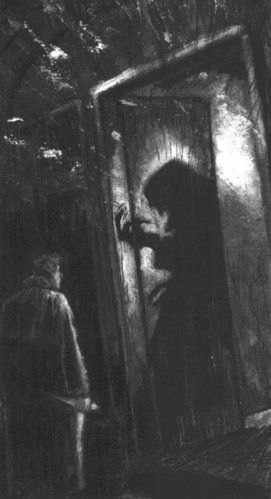
Psst...hey, kid...you ever LARP?
quote:
Life’s barely long enough to get good at one thing. So be careful what you get good at.
--Herman Melville, Young Goodman Brown
Now we get to the basic Attributes and Abilities. (Although the first games I owned were White Wolf books, I keep wanting to call Abilities “skills.”) There are nine basic Attributes in Vampire, and in essence, they are D&D’s classic ability scores but with INT/WIS/CHA split up into twice as many stats, with some overlap.
Attributes and Abilities are listed in detail. They provide not only an overview of what they do, but a little scale describing what it means to have Perception 3 or Computer 2. These are often snarky, like “Wits 1: You send money to televangelists” or “Computer 5: Why aren’t you playing Cyberpunk 2020?” Abilities also come with a short list of characters expected to have this skill, which is neat.
Attributes and Abilities aren’t well-balanced. Because of how the Storyteller system works, that requires some reading between the lines. Remember that in this system, the same Attribute+Ability pairing isn’t rolled every time. But some pairings are more intuitive than others, and in some situations (namely Disciplines and combat) the specific Attribute+Ability roll is prescribed. In theory, every Attribute is equally valuable, but in practice that’s not the case. In a later chapter, on adjudicating common scenarios like chase scenes, research, et cetera, some Attributes and Abilities come up more often than others.
Strength really gets the shaft. It’s not used for any to-hit rolls in combat, nor any Disciplines. It’s your base damage pool in melee combat, and it’s used for Feats of Strength (kicking down doors, etc.)
Dexterity is the best stat, period. All to-hit and dodge rolls are based on Dexterity, and it’s assumed you’ll use it with any Ability where coordination is important: Athletics, Drive, Repair, and Stealth are usually paired with it.
Stamina is less dumpable than Strength, but not much. It can be paired with Abilities, especially on Extended Actions where toughing it out matters most--if your Storyteller remembers that advice. Its most important role is “soaking” damage in combat. But in this system, offense scales faster and better than defense, and you’re better off dodging.
(There are several versions of the Storyteller system, but they all have a rep for invalidating “big bruiser” as a concept. It started with Vampire.)
Charisma is not as broad as it is in D&D. It covers being charming, likable, and trustworthy. In practice, it’s often used when you’re influencing a group of people.
Manipulation, on the other hand, is more often used to deceive, intimidate, or persuade someone into doing something specific.
Appearance is the Comeliness stat. Granted, it also measures the expressiveness of your speech and movement. In most White Wolf games, Appearance got a rap for being kinda useless. In Vampire, it has the specific use of being the go-to for seduction rolls.
Perception encompasses situational awareness, intuition, and an eye for detail. It’s used in investigation and is helpful for spotting ambushes.
Intelligence does what it says on the tin, and is naturally used with many Skill and Knowledge abilities, especially in research actions.
Wits is both your ability to think quickly and to resist deception. Most importantly, it determines initiative--at least Dexterity doesn’t get everything.
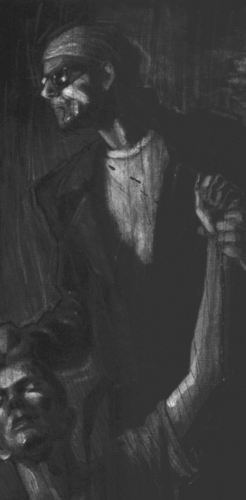
You will never grow old, and you will never die. Your fashion choices, on the other hand…
Abilities are divided into three categories: Talents, Skills, and Knowledges. Besides prioritizing them at character creation, there is a difference between them: if you don’t have any dots in the relevant Ability, there may be a penalty. I can’t see any reason for this but an unnecessary sop to realism. Talents do seem like the most oft-used Abilities and Knowledges the least; perhaps there was an incentive built in there.
Talents are things that anyone can do, or at least attempt to do. There’s no penalty for untrained Talent rolls.
Acting: In addition to performing, you can use this to fool people by feigning emotions.
Alertness: The Perception-check skill. Wits+Alertness is the initiative pool in this game.
Athletics: You know what this does.
Brawl: Unarmed combat of all kinds, including fangs and claws.
Dodge: Dodging in both melee and ranged combat.
Empathy: Discerning others’ emotions and motives. This is often uses as a “social offense” skill, and with the Auspex Discipline.
Intimidation: It does what it says. Unlike a lot of games, Vampire understands that intimidation doesn’t just mean threatening to beat people up.
Leadership: You can win over a group of people to a course of action.
Streetwise: Fitting in, making connections, and getting information among the lowest classes of society. Very useful, considering how many Kindred hunt prey.
Subterfuge: You can conceal your own motivates and suss out those of others. This is both a social offense and social defense skill.
Skills are crafts learned through training. Untrained Skill rolls are at +1 Difficulty.
Animal Ken: You can understand, work with, and train animals. Honestly not all that useful unless you have Animalism, or you’re planning to train a pack of ghoul hounds.
Drive: You can drive common land vehicles. If you want to be a pilot or sailor, you’ll need to buy a special skill.
Etiquette: You know how to conduct yourself, get along, make a good impression, and commit a faux pas. It’s used for diplomacy and, contextually, can be used for other forms of persuasion like negotiation and seduction.
Firearms: Covers all man-portable guns.
Melee: Covers all hand-to-hand weapons.
Music: You can play, compose, and improvise music.
Repair: You can fix pretty much any kind of mechanical device or construction material.
Security: Locks, security systems, and general techniques of breaking-and-entering.
Stealth: It’s the Stealth skill.
Survival: You can navigate and survive in the wilderness.
Knowledges...you know. Untrained Knowledge rolls are impossible unless the Storyteller decides it’s reasonable.
Bureaucracy: You can run and navigate an organization and its red tape. This overlaps with Politics too much, and the text is really vague about what you can do with it.
Computer: Includes operating, programming, and hacking. As you know, this game was published when knowledge of computer systems was a magical ability to conjure information.
Finance: You understand the workings of money, wealth management, and appraising the value of everything from stock portfolios to wine and art.
Investigation: This covers both conducting a search of an area and doing research.
Law: You understand the law and legal system, and may be a practicing lawyer.
Linguistics: Each dot gives you another language, and you can roll it to decipher languages. (This gets kind of funny since there are many real people who know lots of languages. The only one who is definitely an inhuman bloodsucker is Pete Buttigieg.)
Medicine: Covers everything from first aid to surgery.
Occult: You’re familiar with the broad range of mythology and belief systems generally labeled “occult.” At high levels, this does include true knowledge of the supernatural--but only concerning vampires.
Politics: You’re well-informed about political issues and understand the machinations of politics.
Science: You have a broad knowledge of all the physical sciences not covered by another Ability.
As an aside, as the WoD product lines got more developed, I noticed players pulling shit like “My character has Occult 5, so they know all the things I know because I read the sourcebooks.” Assholes.
Specialties is another curious little rule. On the surface, it’s simple: If you have an Attribute or Ability at 4 or 5, you can choose a Specialty, and each Trait writeup comes with examples. When your specialty applies, you can reroll 10s. The problem is that while a lot of Specialties make sense, like Melee 4 (Swords) or Appearance 5 (Sexy), many of them are so broad that it’s hard to see when they wouldn’t apply, and the textual examples encourage this. Attributes in particular have this problem, where the Specialty is often just a synonym. A good example is Brawl 5 (Martial Arts) or Intelligence 5 (Brilliant).
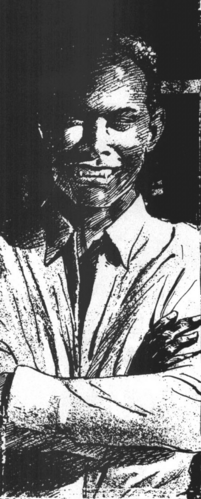
Bitin’ necks and cashin’ checks.
Backgrounds are another set of traits which are commonplace in game design today, but were rare when Vampire came out. They’re advantages which are mostly social, extrinsic, and can’t be measured with a skill system. Looking back, I think Feng Shui improved on Vampire’s rules by assuming that having a skill means having the connections and influence that naturally go along with being good at something. Nonetheless, Backgrounds have stuck around.
The problem with Backgrounds is that some give measurable benefits while others are much more vague about exactly what resources they provide and how they can be used.
Allies: You have mortal friends--close enough friends that they’ll put themselves on the line for you, and expect you to do the same. At 1 dot, you have one Ally “of moderate influence and power.” Five dots gives you five Allies including one who is “extremely influential.” See what I mean?
Contacts: You have an information network of people who, while they won’t come to your aid like Allies, provide you with vital intelligence. Each dot gives you a “Major Contact” in some area of expertise and assumes you have a web of minor Contacts you can get in touch with locally.
Fame: You’re a celebrity. You can use your Fame rating in some social situations, and it subtracts from the Difficulty to find victims in appropriate situations. Fame has its drawbacks, in that you can be recognized, but it also makes it harder for your enemies to get at you without exposing themselves. One dot means you’re a celebrity in some local subculture, while Fame 5 makes you a national celebrity.
Generation: You’re going to wheedle the Storyteller into letting you buy as much of this as possible. Each dot lowers your Generation by one, so Generation 5 means you’re 8th Generation. We will get into why that’s awesome a little later.
Herd: You’ve cultivated a group of mortals that you can safely feed from without worrying about breaking the Masquerade. Your Herd can perform minor favours from you, but they’re not nearly as useful or controllable as Allies, Contacts, etc. One dot gives you 3 people, while Herd 5 gives you 60 people. At low levels, you might have beguiled a circle of mortal lovers, whereas a larger group may mean you’ve founded an honest-to-God cult.
Influence: You can pull strings in mortal politics to get someone’s ear, get out of trouble, and so on. One dot means you have some pull in local politics, while Influence 5 puts you on par with a major Party donor or member of Congress. As if being a vampire wasn’t enough.
Mentor: An older vampire teaches and looks out for you. A one-dot Mentor is an ordinary ancilla; a five-dot Mentor is a Justicar.
Resources: Cold hard cash, baby. You have some way of providing yourself with a regular income, and without any dots in Resources, you’re assumed to be dead broke and probably making your haven in a squat or sewer. One dot in Resources makes you an average poor person, while Resources 5 makes you a multimillionaire with all the lifestyle accoutrements that go with it.
Retainers: You have Renfields that do your bidding, one per dot. Retainers are usually ghouls or mortals you’ve brainwashed with repeated use of your Disciplines. Retainers don’t ask much of you in return, but by the same token they’re not as influential or independent as Allies.
Status: You’ve made something of yourself in Kindred society. One dot makes you a recognized neonate, while Status 5 is the purview of the Prince.
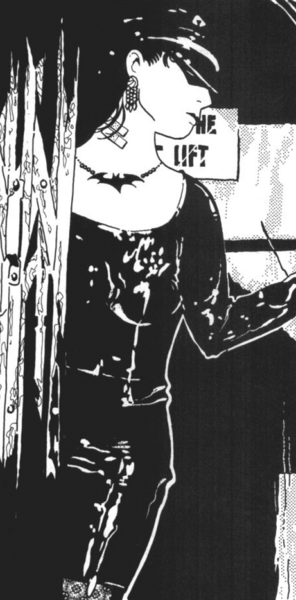
Every. Single. Woman I’ve ever dated is in this book somewhere, and it freaks me out.
quote:
The tradition of all dead generations weighs like a nightmare on the brains of the living.
--Niccolo Machiavelli, The Hellbound Heart
I’ll save Disciplines and other narrative mechanics for a following update, and leave you with the rules for Generation.
Kindred society is a corrupt, oppressive gerontocracy. The elders are not only more experienced than you, with more time to shore up power and influence, their vampire blood is more potent than yours. Each new Generation of Kindred has weaker vitae than the last. The only way to lower your Generation is through diablerie, and that’s a capital offense. Generation doesn’t hinge on age, either--if some dusty Methuselah decides he needs a potent pawn, he can create a 6th Generation childe whenever he feels like it. (For that matter, he can create a dozen.)
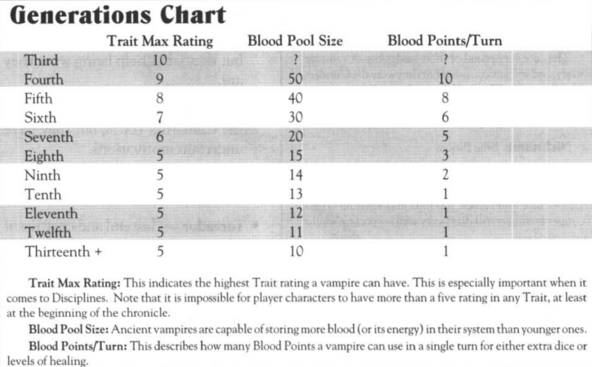
Mechanically, a lower Generation means that you can store more Blood Points, and that you can spend more per turn. The lowest-Generation Kindred can even raise their Traits to superhuman levels with experience points. So Generation is far from an end-all be-all measure of power level, and elders are far from unassailable. But it’s a huge advantage, and it was a terrible idea to make Generation something you can buy at character creation.
Next time on Kindred the Embraced: Disciplines! Oh, the Humanity!
Bondage & Discipline
Original SA post
Vampire: The Masquerade (2nd Edition)
Preface
Chapter 1: Introduction
Chapter 2: Setting
Interlude: A History of Face Grabbing
Chapter 3: Storytelling
Chapter 4: Rules
Chapter 5: Character
Chapter 6: Chronicle
Chapter 7, Part 1: Clans
Chapter 7, Part 2: Traits
Chapter Seven, Part 3: Bondage & Discipline
quote:
If I realised the power of magic to worry and terrify people before, then I certainly would have used it before.
--Gregor Strasser, The Bell Jar
At long last, we arrive at the central theme of this game: Kewl Vampyre Powarz!
All Kindred have certain powers and weaknesses in common, but Disciplines are a bucket for all the powers commonly attributed to some, but not all vampires: mesmerism, shapeshifting, making cows give sour milk, that sort of thing. They’re a big part of what makes the game accessible, because they’re the reason your Clan serves as a sort of character class. (There’s a reason Disciplines were split off into their own chapter in later editions.)
Most Disciplines are a set of discrete powers organized under a theme. One of my longstanding pet peeves about Disciplines was that many don’t feel like a natural progression from one power to the other. It doesn’t bother me so much, though there’s little narrative explanation for how you study and learn new powers. While you can learn non-Clan Disciplines, the designers were kinda vague on whether you need a teacher to do that, especially for the carefully guarded ones like Thaumaturgy.
Disciplines aren’t terribly well-balanced. There are few powers that strike me as near-useless or totally dependent on the kindness of the Storyteller, but some are clearly better than others. Some Disciplines require a different Attribute+Ability roll for each power, while others use mostly the same dice pool or don’t require rolling at all. Some require spending Blood or Willpower points. The corebook doesn’t list powers for Disciplines above five dots--you had to make them up or wait for the supplements.
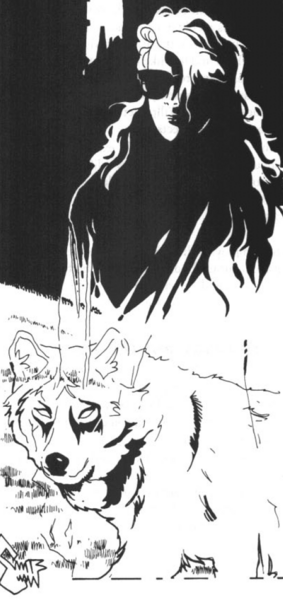
Somehow, this is the only good illustration in the chapter about vampire powers. But it’s enough.
 Animalism allows you to telepathically communicate with and control animals. (Without this Discipline, animals tend to be frightened or angered by vampires.) You can also manipulate “the Beast” inherent to animals, humans, and even Kindred. This boils down to their instincts for fight, flight, and appetite.
Animalism allows you to telepathically communicate with and control animals. (Without this Discipline, animals tend to be frightened or angered by vampires.) You can also manipulate “the Beast” inherent to animals, humans, and even Kindred. This boils down to their instincts for fight, flight, and appetite.The Storyteller is encouraged to characterize individual animals as much as makes sense--most of these powers require you to convince the animal to do what you want it to do, and roleplay talking to it in a way it can understand. (For example, dogs are smarter than mice, but neither understands what a telephone is.) Later books would expand on common tactics that Gangrel and Nosferatu employ using animals, though I never played with anyone who made an animal much of an NPC in its own right.
· Sweet Whispers: By making eye contact, you can telepathically communicate with an animal and convince it to perform complex commands. This can even work over days or weeks, creating useful lookouts and guards. Roll Manipulation+Animal Ken.
·· The Beckoning lets you can summon any animals of a particular species that are in the area, by calling to them in silly animal sounds. Your successes determine how many show up. Summoned animals aren’t under your command, but are presumed to be friendly. This power can depend a lot on the sympathy of the Storyteller, though you shouldn’t have much trouble summoning rats, cats, and dogs in a city. Roll Charisma+Survival.
··· Song of Serenity can soothe the Beast in a mortal or animal, making them passive and helpless. This is a great way for Kindred to feed, since the victim doesn’t understand that they were manipulated, and tend to blot the memory out entirely. Roll Manipulation+Empathy in an Extended Action.
···· Sharing of Spirits means you can possess an animal. The number of successes determines what Disciplines you can use while running around in animal form. Roll Charisma+Animal Ken.
····· Drawing Out the Beast: When you feel frenzy coming on, you can transfer your Beast into someone else, making them frenzy instead. This works on animals, mortals, and Kindred, and is fun at parties. If you leave the scene before your victim’s frenzy ends, congratulations: you’ve just created a side-story where you need to get your Beast back. (Ridding yourself of your Beast is not a good thing: you gradually lose your interest in everything, including “drinking blood” and “going inside before sunrise.”) Roll Manipulation+Animal Ken to completely fuck up whatever the Storyteller was planning.
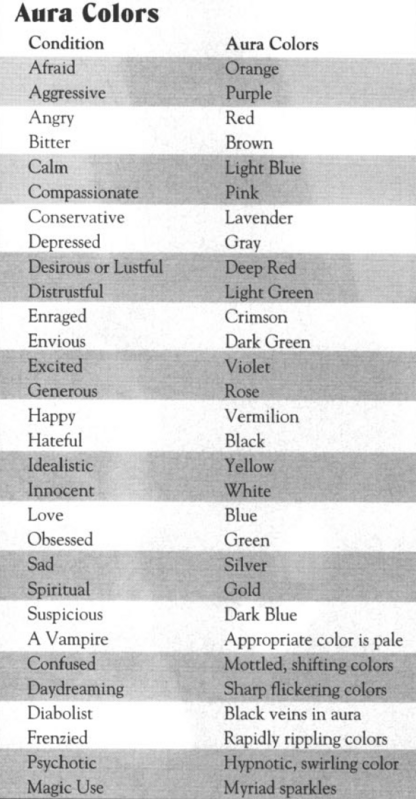
 Auspex is the Discipline of super-senses and ESP. It makes you hard to ambush, and also makes you very good at knowing what bad shit other Kindred are up to. While Malkavians have a reputation for that, they never really took any cues from this in characterizing the Toreador.
Auspex is the Discipline of super-senses and ESP. It makes you hard to ambush, and also makes you very good at knowing what bad shit other Kindred are up to. While Malkavians have a reputation for that, they never really took any cues from this in characterizing the Toreador.· Heightened Senses makes all your five senses supernaturally sharp, doubling the range of your sight and hearing, letting you do normally impossible stuff like tracking people by scent, and giving you an innate danger sense. The downside is that overpowering stimuli can overload your senses. The Storyteller rolls your Auspex when your danger sense comes into play; otherwise, all of this is narrative.
·· Aura Perception: Probably one of the best-known of all Disciplines, this power lets you see people’s auras. Different colours indicate different emotions. It also allows you to see if someone is a vampire, a mage...or someone who’s committed diablerie. Roll Perception+Empathy; your successes indicate how many colours and patterns you can see in someone’s aura.
··· Spirit’s Touch is what they call psychometry. You can handle an object and get impressions of the last person who held it. Roll Perception + Empathy; each success gives you one piece of information about the person or what they were doing.
···· Telepathy lets you read someone’s surface thoughts without them knowing it. You can learn pretty much anything about someone if you keep using this power over time. Roll Intelligence+Subterfuge; more successes gives you more information, and this is very much up to the Storyteller. They’re encouraged to give you information in the form of emotions and a stream-of-consciousness narrative. Using this power on a vampire costs 1 Willpower.
····· Psychic Projection allows you to astrally project. Powers like this crack me up: the game is saying that yeah, there’s this whole other plane of reality, and you access it using this one specific power, and what happens when you use it is completely up to the GM, because it’s literally uncharted territory. (Immortal had half a dozen of these.) Roll Perception+Occult and spend 1 Willpower, and you can float around in astral form with a silver cord connecting you to your sleeping body.
The roll is to make sure you can actually find your destination, and you need to roll again when changing course. Nonetheless, this is a really potent ability. You can travel at up to 500mph as an invisible and untouchable ghost, and can briefly manifest a ghostly form if you need to deliver a message. It’s really to your advantage if the Storyteller assumes the astral plane is a flat endless plane of nothing, since it’s possible to encounter mages or werewolves and have astral brawls, using mental instead of physical Attributes.
 Celerity is the best Discipline. It’s why you have to go to the Toreador’s shitty gallery opening, and listen patiently to the Brujah rant about the military-industrial complex or the Jewish-Bolshevist conspiracy. Each dot of Celerity gives you an extra action per turn, without any penalties or splitting your dice pool or anything. The only downside of Celerity is that it costs 1 Blood Point per turn. You will likely have no problem getting that back from whatever is left of your victims. Celerity doesn’t boost initiative, but it’s insanely broken as it is. (Celerity was changed with each edition, but it wasn’t until Requiem that somebody realized breaking the action economy is always going to break the game.)
Celerity is the best Discipline. It’s why you have to go to the Toreador’s shitty gallery opening, and listen patiently to the Brujah rant about the military-industrial complex or the Jewish-Bolshevist conspiracy. Each dot of Celerity gives you an extra action per turn, without any penalties or splitting your dice pool or anything. The only downside of Celerity is that it costs 1 Blood Point per turn. You will likely have no problem getting that back from whatever is left of your victims. Celerity doesn’t boost initiative, but it’s insanely broken as it is. (Celerity was changed with each edition, but it wasn’t until Requiem that somebody realized breaking the action economy is always going to break the game.) Dominate is the power of straight-up mind control. The effects are potent, but it has drawbacks. It requires eye contact, so its use is obvious and it can only affect one person at a time. It also can’t be used on Kindred with a lower Generation. From a rules point of view, it has the common problem of requiring too many different pools.
Dominate is the power of straight-up mind control. The effects are potent, but it has drawbacks. It requires eye contact, so its use is obvious and it can only affect one person at a time. It also can’t be used on Kindred with a lower Generation. From a rules point of view, it has the common problem of requiring too many different pools.· Command the Wearied Mind lets you issue a one-word command to a target, which they will obey instantly: flee, jump, cough, fall, etc. They’ll hesitate if the command doesn’t make sense. Roll Manipulation+Intimidate.
·· Mesmerize hypnotizes a victim and allows you to implant complex instructions, which can be carried out immediately or at any time in the future. Roll Manipulation+Leadership. It takes more successes to get someone to do something that seems strange to them, or to do something dangerous or contrary to their Nature.
··· The Forgetful Mind messes with your victim’s memories. Roll Wits+Subterfuge. This is commonly used to get away with feeding, but with enough successes, you have free rein to fuck around with their long-term memories.
···· Conditioning is how powerful Kindred create loyal Renfields. Roll Charisma+Leadership in an Extended Action over weeks or months. This makes the victim more vulnerable to your Dominate attempts and resistant those of other vampires. Conditioned subjects carry out orders with little imagination or free will.
····· Possession does exactly what it sounds like. Roll Charisma+Intimidation in an Opposed Roll with your victim, which requires you to strip away all their Willpower with your successes.
 Fortitude grants you supernatural toughness. Each dot of Fortitude gives you an extra die to Soak damage. Fortitude is also the only thing that allows you to Soak “aggravated” damage from fire and sunlight. (And some rare magical attacks, which got a lot less rare as they published more books.) In my opinion, Fortitude kinda sucks.
Fortitude grants you supernatural toughness. Each dot of Fortitude gives you an extra die to Soak damage. Fortitude is also the only thing that allows you to Soak “aggravated” damage from fire and sunlight. (And some rare magical attacks, which got a lot less rare as they published more books.) In my opinion, Fortitude kinda sucks.First, offense scales more and faster than defense in this system, and it has a fixed number of hit points with death-spiral wound penalties. So right out of the gate, we’re not talking about something that lets you hold out for several more rounds of combat. Second, the benefits of the other “physical” Disciplines, Celerity and Potence, give you something much better than an extra die per dot.
Finally, as you’ll see when I get into the rules for such things, Fortitude doesn’t make a huge difference if you’re caught in a raging fire or direct sunlight. It can only really save your bacon in classic Hammer Dracula scenarios where you’re struck by one ray of sunlight coming through a window, or like that scene in Near Dark where you have a waiting getaway car.
 Obfuscate is the stealth Discipline, allowing you to avoid detection through illusions. Its powers are conditional and interesting.
Obfuscate is the stealth Discipline, allowing you to avoid detection through illusions. Its powers are conditional and interesting.· Cloak of Shadows allows you to become invisible as long as two conditions are met: you must remain motionless, and you need some kind of cover, like a shadow or doorframe. You can even do the Looney Tunes bit where you hide behind an impossibly narrow tree. You don’t have to roll anything, and can only be detected by Kindred with Auspex higher than your Obfuscate. One more reason for the Nosferatu and Toreador to hate each other.
·· Unseen Presence lets you do that Matrix thing where you walk around nonchalantly but no one seems to notice you. You’re only revealed if you make a commotion, or to someone specifically looking for you. Roll Wits+Stealth, and the Storyteller interprets how effectively you remain hidden.
··· Mask of a Thousand Faces is a fun power that lets you appear to be someone else. Roll Manipulation+Acting. The more successes you get, the more people will remember you as a specific, distinct individual with a completely different look and set of mannerisms. This is particularly useful if you look like a mutant from a post-apocalyptic movie.
···· Vanish from Mind’s Eye allows you to disappear into thin air, even with a group of people looking right at you. Roll Charisma+Stealth. More successes means that weak-willed mortals are prone to forget that they ever saw you.
····· Cloak the Gathering lets you use any of your other Obfuscate powers on other people. You can affect one ally per point of Stealth. A single roll affects everyone equally. Obfuscate, it’s good!
 Potence gives you supernatural strength. It’s the other reason you have to put up with the Brujah, and why you shouldn’t make jokes about the Nosferatu when you think they’re not listening. Each point gives you an automatic success on all Strength rolls. This includes damage, so Potence makes you a wrecking ball in melee combat. (Now you know why I think Fortitude sucks.)
Potence gives you supernatural strength. It’s the other reason you have to put up with the Brujah, and why you shouldn’t make jokes about the Nosferatu when you think they’re not listening. Each point gives you an automatic success on all Strength rolls. This includes damage, so Potence makes you a wrecking ball in melee combat. (Now you know why I think Fortitude sucks.) Presence makes you supernaturally attractive and impressive to people. It dazzles and seduces people, the velvet glove to Dominate’s iron fist. In practical terms, Presence is good for influencing whole crowds of people, or for manipulating a mortal without them realizing it--because it works by influencing emotions, mortals aren’t likely to realize they’ve been bewitched.
Presence makes you supernaturally attractive and impressive to people. It dazzles and seduces people, the velvet glove to Dominate’s iron fist. In practical terms, Presence is good for influencing whole crowds of people, or for manipulating a mortal without them realizing it--because it works by influencing emotions, mortals aren’t likely to realize they’ve been bewitched.· Awe lets you work the room, making yourself incredibly cool and attractive to a group of people. Roll Charisma+Acting, with successes determining both how you influence people and how many people you can effect. You can’t make people endanger themselves, but with 5 successes, convincing an auditorium full of people to do whatever you want isn’t out of the quuestion.
·· Dread Gaze is, seriously, the “game face” from Buffy. You bare your fangs and snarl at your victim, and roll Charisma+Intimidation. Successes gives them a penalty to do anything but cower in fear or flee in terror. I feel like any self-respecting vampire should be able to do this, and the description implies that it only works on mortals.
··· Entrancement makes you so magnetic to a single person that they want nothing but to hang around you and serve you. Unlike Dominated thralls, they are otherwise free-willed individuals, making more useful but less biddable. Roll Appearance+Empathy to make your victim want to serve you anywhere from an hour to a year, depending on successes. Unlike targets of Awe, they’re not likely to think much of you after spending time as your lackey.
···· Summoning allows you to telepathically order someone to come to you, as long as you’ve met them before. You can Summon someone on another continent, and they home in on your location with a flawless sense of direction, even if you keep traveling yourself. Roll Charisma+Subterfuge, with successes determining how quickly and efficiently they travel.
····· Majesty causes everyone around you to regard you with godlike reverence. They have to make a Courage roll to act with anything other than pathetic servility, with your Charisma+Intimidation as the Difficulty. Even Kindred have to spend a Willpower to overcome Majesty.
 Protean is the power to shapeshift. Of all the Disciplines, it sticks out the most as a collection of random powers, and not only that, but a mixture of combat and utility powers. Protean often costs a Blood point, but never requires any rolls!
Protean is the power to shapeshift. Of all the Disciplines, it sticks out the most as a collection of random powers, and not only that, but a mixture of combat and utility powers. Protean often costs a Blood point, but never requires any rolls!· Gleam of Red Eyes makes your eyes glow red, allowing you to see perfectly even in absolute darkness. Yawn.
·· Wolf Claws, now that’s the stuff! You can grow inch-long talons that do +2 aggravated damage in hand-to-hand combat. Aggravated damage powers became much more common as the product lines went on, but at this point, pretty much the only other things that do agg are fire and sunlight. Gangrel are typically seen as one of the “fighter class” clans for this power alone.
··· Earth Meld is an incredibly useful power. It allows you to melt into the earth, making you invulnerable--yes, you can sleep the day away in the middle of a city park. The only drawbacks are that it costs a Blood point, and you have to be on actual, natural earth. I feel that Disciplines should not just be a bag of dice tricks, but unique powers that really distinguish the way that you are a vampire. Earth Meld is a prime example.
···· Shadow of the Beast allows you to transform into a bat or a wolf. (Yes, you get both.) It costs a Blood point and takes three turns. Being a bat obviously allows you to fly, but other than that, there are no specific rules for the effects of being in animal form.
····· Mist Form does exactly what it says. You can float around at walking speed and slip through the tiniest openings. It’s impossible for most things besides fire and sunlight to hurt you, and it takes hurricane-force winds to blow you around against your will. It has the same costs as wolf and bat form.
 Thaumaturgy comes last, which is good, because it’s fucking complicated. It’s the power to manipulate vampiric blood itself, and is a big reason other Kindred think the Tremere are creeps. While I don’t think the Thaumaturgy powers are super great, Thaumaturgy also includes whole additional powersets that other Kindred don’t get! In addition to its basic powers, Thaumaturgy includes three “Paths” that can be bought separately, and a set of “Rituals” that can be performed by anyone with a high enough Thaumaturgy rating, without spending more experience points. So the Tremere are a clan with a bullshit weakness, and a whole spellbook of extra powers that they get to buy as in-clan Disciplines. Fucking wizards.
Thaumaturgy comes last, which is good, because it’s fucking complicated. It’s the power to manipulate vampiric blood itself, and is a big reason other Kindred think the Tremere are creeps. While I don’t think the Thaumaturgy powers are super great, Thaumaturgy also includes whole additional powersets that other Kindred don’t get! In addition to its basic powers, Thaumaturgy includes three “Paths” that can be bought separately, and a set of “Rituals” that can be performed by anyone with a high enough Thaumaturgy rating, without spending more experience points. So the Tremere are a clan with a bullshit weakness, and a whole spellbook of extra powers that they get to buy as in-clan Disciplines. Fucking wizards.· A Taste for Blood lets you analyze mortal and Kindred blood. You can tell how much blood is left in a mortal, or determine a vampire’s Generation, and other minor things. Roll Perception+Occult.
·· Blood Rage forces another Kindred to spend Blood points the way you want them to. This includes the things all Kindred can spend Blood on, like increasing their Physical Attributes or temporarily appearing more human. You have to touch your victim, so roll Dexterity+Subterfuge with each success forcing them to spend 1 Blood. Try this on a Brujah.
··· Blood of Potency can temporarily make your blood more potent, as if you were of a lower Generation! Roll Manipulation+Survival, and spend your successes to decrease your Generation by 1 or extend the effect for another hour.
···· Theft of Vitae allows you to magically drain other people’s Blood, transferring it into yourself. This works on mortals or Kindred, as long as they’re within 50 feet and you have a clear line of sight. Roll Intelligence+Medicine, each success drains 1 Blood point. The target will know who’s attacking them.
····· Blood Cauldron boils your victim’s blood inside their body. Choose how many Blood points you want to boil, and roll Willpower against Difficulty Blood+4. Each success inflicts 1 damage and destroys 1 Blood point. This is death for mortals, and sucks for Kindred too.
But wait! There’s more!
 Rituals are rated 1 to 5, and anyone with an equivalent Thaumaturgy rating can perform the spell--as long as they know it. Thaumaturgists get 1 ritual at character creation, while the rest must be learned--not with experience points, but by actually finding a tutor or spellbook. In addition to spending Blood points, Rituals often require material components like bones, feathers, herbs, eye of newt, and so on. Fucking wizards!
Rituals are rated 1 to 5, and anyone with an equivalent Thaumaturgy rating can perform the spell--as long as they know it. Thaumaturgists get 1 ritual at character creation, while the rest must be learned--not with experience points, but by actually finding a tutor or spellbook. In addition to spending Blood points, Rituals often require material components like bones, feathers, herbs, eye of newt, and so on. Fucking wizards! They only give a few Level 1 Rituals in the corebook. Bet you can’t wait to buy supplements!
Defense of the Sacred Haven allows you to block sunlight from coming in through windows, by spending a Blood point to smear drops of blood on each window.
Wake with Morning's Freshness allows you to wake up, fully alert, if someone disturbs your haven.
Communicate with Kindred Sire allows you to communicate telepathically with your sire or anyone Blood Bound to you.
Deflection of Wooden Doom makes you immune to staking for a night. Any wooden stake that touches you will harmlessly crumble into dust.
Devil’s Touch curses a mortal for a night, so that everyone they meet will be instinctively hostile to them. It requires planting a “bad penny” on the target.
 Paths are separate Thaumaturgy powers. You buy up the dots like Disciplines, and they’re actually even cheaper than an in-clan Discipline, because each Path is a single power. (Paths initially confused the shit out of me, because there’s a major typo in the tables for them: instead of dots, it lists number of successes. So it looks like you’re supposed to buy dots in a power where that doesn’t affect the roll at all.)
Paths are separate Thaumaturgy powers. You buy up the dots like Disciplines, and they’re actually even cheaper than an in-clan Discipline, because each Path is a single power. (Paths initially confused the shit out of me, because there’s a major typo in the tables for them: instead of dots, it lists number of successes. So it looks like you’re supposed to buy dots in a power where that doesn’t affect the roll at all.)The Lure of Flames lets you summon and control fire. Yes, fire! One of the most dangerous fucking things to vampires, and you just get to throw it around! With 1 dot you create a candle flame, with 5 dots you can create a huge inferno.
Movement of the Mind gives you telekinesis, ranging from a pound to a half a ton. You can use this to fly.
Weather Control does exactly that. The rating determines the phenomena you can create, ranging from creating fog to dropping a fucking lightning bolt on anyone you don’t like. The Difficulty is determined by ambient weather conditions (so it’s really hard to pull lightning down from a clear sky).
Next time on Kindred the Embraced: I was going to get into Virtues, Humanity, Willpower, and some other miscellaneous Traits in this update, but this is long enough.
Dramatic Systems
Original SA post
Vampire: The Masquerade (2nd Edition)
Preface
Chapter 1: Introduction
Chapter 2: Setting
Interlude: A History of Face Grabbing
Chapter 3: Storytelling
Chapter 4: Rules
Chapter 5: Character
Chapter 6: Traits
Chapter 7, Part 1: Clans
Chapter 7, Part 2: Traits
Chapter 7, Part 3: Disciplines
Chapter 8: Dramatic Systems
After the Disciplines, Chapter 7 ends by giving you some of the rules for Humanity, Willpower, Blood Pool, and Health, which it immediately expands on in the following chapter. So I’m going to slide right into Chapter 8, which is all about the “Dramatic Systems” which transcend simple Attribute+Ability rules, and include the narrative mechanics Vampire introduced.
quote:
We judge ourselves by what we feel capable of doing, while others judge us by what we have already done.
--Victor Hugo, The Brothers Karamazov
Virtues are the first set of special traits you have to worry about. They determine those weird narrative traits that run on a 1-10 scale, and they’re rolled to prevent the bad shit that mostly only happens to vampires.
Conscience is rolled to prevent losing Humanity when you do something evil. It’s not just the capacity to feel guilt, but a stable sense of self and self-awareness.
Self-Control is rolled to prevent frenzy. It’s self-explanatory, no?
Courage is rolled to prevent Rotschreck, the instinctive fear of fire, sunlight, and holy powers. It’s the ability to steel yourself and persevere against threats and opposition.
Your starting Humanity is your Conscience+Self Control. Your starting Willpower is equal to your Courage. Because you get 7 starting points to add to virtues, you’ll probably have a Humanity of 6-7 and a Willpower of 3-4.
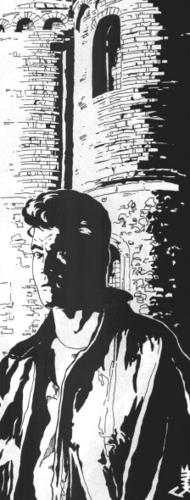
Welcome to Castle Sheen! Enter freely and of your own will.
Speaking of Willpower, it’s one of three Traits rated on a 1-10 scale. It’s useful and versatile, and a common dump for leftover Freebie Points at character creation. I like Willpower because it’s player-driven.
You almost never roll Willpower; it’s a pool of “awesome points.” First, you can spend a Willpower for an automatic success on a roll. That’s great. The other common use for Willpower is to resist being compelled to do something. You can spend it to resist powers like Dominate and Presence, to hold frenzy at bay, or to resist a compulsion caused by a Derangement. In a sense, Willpower is the counter to a common problem with the other narrative Traits, which is that they’re imposed on you by the Storyteller.
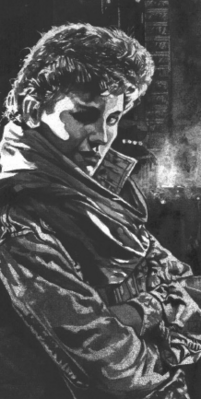
We’re the Kindred in America (Woah)
quote:
The death of one man: that is a catastrophe. One hundred thousand deaths: that is a statistic!
--Sisters of Mercy, “Pagan Lovesong”
What can I say about the Humanity rules that hasn’t already been said? They’re the most hotly debated topic among the fanbase. Vampire certainly wasn’t the first game to introduce morality mechanics, but it was the most influential. Without Vampire, you probably don’t have a bunch of 90s games with traits that track a mixture of sanity, morality, and supernatural corruption. However, Shannon Appelcline correctly observed that despite being hailed as the central theme of the game, Humanity was never the draw for people to play it. The draws are the Clans and Disciplines.
In the final analysis, I see Humanity as a rules module that should have been done in a totally different way, or not at all. (And before I criticize it, I should at least give you the really short version of how Humanity works: When you do evil shit, you have to roll Conscience to avoid losing Humanity.)
The first big problem with Humanity is that it isn’t vital to the game’s design. It’s a narrative module attached to a conventional ruleset. There are consequences for losing Humanity, so it “plugs into” that ruleset at several points, and later developers would find more ways for it to do so. But that’s still just a module creeping over its system, like ivy up the side of a Gothic castle. The designers talk up Humanity as a player character’s most important Trait, but that’s really only true in the sense that there are consequences for losing it, and if you lose it all, you essentially die. That’s also true of Health Levels, and they aren’t your most important Trait.
To compare Vampire to some later games that learned from its mistakes: if you take Love out of My Life With Master, or Strings out of Monsterhearts, you have a system that is no longer playable. If you strip Humanity out of Vampire, you have...a game that a lot of Vampire fans would dearly like to play, though they’re made to feel a little guilty about it.
Even some games with a more conventional structure do a better job of integrating their narrative mechanics. (Nightlife, with its cheeky punk aesthetic that is far less self-serious than Vampire, integrates its Humanity rules into the magic system. Granted, the result is too much bean-counting.)
The second problem with Humanity is that the players do not actively engage with it. It’s a set of rules where if you break them, the referee blows the whistle and gives you a penalty. Being a humane or inhumane vampire is not a choice, like being Jedi or Sith in a Star Wars game. There are penalties for having low Humanity, and the only benefit is expedience, if that. Most of the games that imitated Vampire’s morality mechanics also imitated its mistakes--especially the part where narrative mechanics are just a stick for the GM to beat you with when you’re not roleplaying “properly.”
Anyway, here’s how it works.
Humanity is rated 1-10. The average human, and the average starting vampire, has a Humanity of 7. Losing Humanity works off of what they call the “Hierarchy of Sin.” If you commit some harmful act that is at or below your current rank on the hierarchy, you have to roll your Conscience to avoid Degeneration, which results in losing both a point of Conscience and a point of Humanity. (As you sink into depravity, casually hurting other people no longer bothers you.)
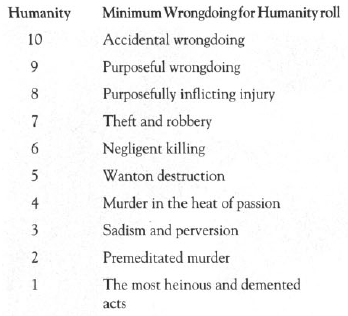
As you can see, the Hierarchy is sketchy and wide open to interpretation, and raises a lot of vague moral questions. What’s a “sin” and a “wrongdoing?” How serious does some crime have to be to count as “theft” or “wanton destruction?” The rules admit right out that they rely on the Storyteller’s interpretation and their own sense of ethics, and tell the player not to argue. The advice given to the Storyteller on this point is typical wishy-washy bullshit: don’t be too strict but don’t be too lenient, and try to warn the players before you punish their characters with a Degeneration roll.
Oh, and those consequences I mentioned? First, if you lose all your Humanity, you lose your mind. You become a wild animal that is going to be swiftly put down by a Blood Hunt. There’s no coming back from inhumanity.
Second, Your Humanity is your maximum dice pool for any of the following: Rolls involving Empathy, rolls to resist frenzy, and any roll you make during the day. There are a few other edge cases where Humanity comes into play, like how long you spend in torpor. I’ll explain that later.
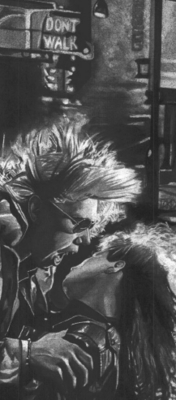
WHAT DO YOU MEAN YOU FORGOT THE CHICKEN NUGGETS
quote:
She's hungry as the hunter and she's shooting for the thrill
She's hungry as the hunter, she shoots to kill
--Samuel Taylor Coleridge, “Ain’t Got Time to Bleed”
Frenzy is less complicated than Humanity, and a hell of a lot funnier. All that talk about the Beast inside you isn’t just poetical whining. Vampires have the instincts of an apex predator, and they can overwhelm you. Like Humanity, it’s up to the Storyteller to decide when they think you’ve been provoked to the point of risking frenzy. But the ordinary triggers are hunger and feeling threatened or humiliated. The frenzy rules are a recipe for “intrigue” scenes to turn into cinematic standoffs where adults act like children.
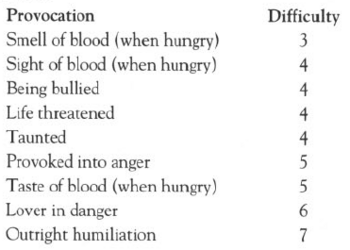
Resisting frenzy is a Self-Control roll, in an Extended Action. If you get to five successes, the urge to frenzy is overcome. If you fail at any point, you enter frenzy, and if you botch, you pick up a Derangement too. You can spend a Willpower point to take control for a turn.
So what happens when you’re in frenzy? Basically, you have to act to satisfy whatever urge drove you into it, and it only lets up when the tension ratchets down. Feed until you’re full, fight until your enemy stops moving, rant and rave until you’re exhausted. There are some benefits to frenzy: you ignore some wound penalties and mind-affecting powers.
Rotschreck (“red fright”) is the flight instinct to frenzy’s fight instinct. It’s the all-consuming fear of the vampire’s bane: fire and sunlight.
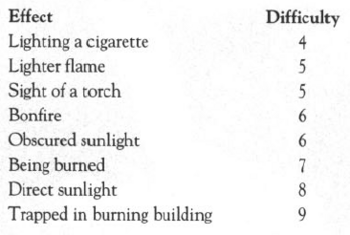
Despite the fancy name, Rotschreck is dirt simple. When you encounter fire or sunlight, make a Courage roll. Failure induces a state similar to frenzy, but all you want to do is flee. The Difficulty is based on the intensity of the fire or sunlight. As with Degeneration, a botch creates a Derangement.
quote:
Darkness for him is another way of seeing the day. Which means that in looking at the night and the nothingness of the night, he does not see at all.
--Thomas Disch, We Have Always Lived in the Castle
Part and parcel with the Humanity and Frenzy rules are Derangements. You get one if you botch a Conscience or Self-Control roll, and Malkavians have them as a matter of course. Picking up a Derangement is pretty much like getting insanities in Call of Cthulhu. Many people have observed that the rules for Derangements in Storyteller make a troubling connection between moral degeneration and mental health. My point of view is that the designers combine a Gothic, premodern concept of “madness” with modern concepts of mental illness, which is seriously problematic. I mean, they’re even called “Derangements.” Somebody should have read Foucault.
To be fair, the rules note that Derangements are meant to be an influencing, not all-consuming force, and they should neither be completely ignored nor a cue to play your character as a one-note caricature. The odd thing is that the writers don’t seem to see Derangements as a punishment at all--they’re more worried about a player enjoying the spotlight and hamming it up so much that it’s disruptive.
There are ten sample Derangements.
Multiple Personalities: You have multiple identities that you switch between. Mechanically, your Nature changes on a regular basis.
Fantasy: You live in a world of delusion where you are the unrecognized protagonist. You fulfill your dreams of being heroic by accomplishing strange goals that only overlap with reality.
Regression: You retreat into a childlike state, rejecting adult responsibilities. Your Nature and Demeanor effectively change to Child.
Perfection: You become an obsessive perfectionist. When things inevitably go wrong despite your best efforts, it triggers a frenzy roll.
Overcompensation: You cover your weaknesses of character by overplaying your strengths, to the point of being obnoxiously self-righteous and foolhardy.
Obsession: You become completely preoccupied with some interest or ambition.
Paranoia: You believe you’re being persecuted. You can’t trust anyone, and go to absurd lengths to protect yourself.
Amnesia: You block out major parts of your long-term memory to avoid dealing with them. This may cause you to “forget” Abilities when you need them.
Manic-depression: You vacillate between deep depressions where nothing can rouse you and energetic fits where you push yourself too hard. This results in either being unable to spend or recover Willpower, or burning through Willpower and Blood at a dangerous rate.
Delusions of Grandeur: Pretty much what it says.
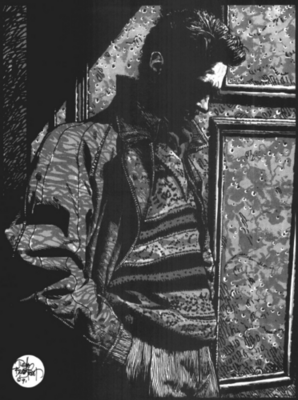
Which one made him buy that sweater?
Next time on Kindred the Embraced: Blood and fire, baby. Blood and fire.
Dramatic Systems
Original SA postHungry? How about thirsty?

Vampire: The Masquerade (2nd Edition)
Preface
Chapter 1: Introduction
Chapter 2: Setting
Interlude: A History of Face Grabbing
Chapter 3: Storytelling
Chapter 4: Rules
Chapter 5: Character
Chapter 6: Traits
Chapter 7, Part 1: Clans
Chapter 7, Part 2: Traits
Chapter 7, Part 3: Disciplines
Chapter 8, Part 1: Dramatic Systems
Chapter 8, Part 2: Dramatic Systems
It’s finally time to cover the mechanics that rule the nature of the vampire itself--drinking blood and the things that can still kill you.
quote:
it is a cheering thought to think
that god is on the side of the best digestion
--James Joyce, “Love Like Blood”
You get Blood Points by biting people and drinking their blood, obviously. You can drain up to 3 points per turn, but since feeding is the only physical pleasure Kindred really enjoy, they prefer to drink as slowly as they can get away with. An adult human has 10 Blood Points worth of blood. Draining 5 points is life-threatening, and 7 points ensures they’ll die without treatment. (In reality, losing 40% of your blood is more than enough to kill you if you don’t get a transfusion very quickly.) Since mortals don’t actually have a Blood Pool, assume each point drained deals a level of damage.
Once a vampire bites their victim and drains a single Blood Point, the victim stops resisting, lost in a trance as they experience the same pleasure as the vampire. It’s better than sex, heroin, and a new Pink Turns Blue album combined. Kindred can fight back, but only mortals with Willpower 9-10 have the wherewithal to do so. Kindred can heal a bite wound on their victim by licking it, making it easier to feed without killing or leaving telltale signs of vampire attack.
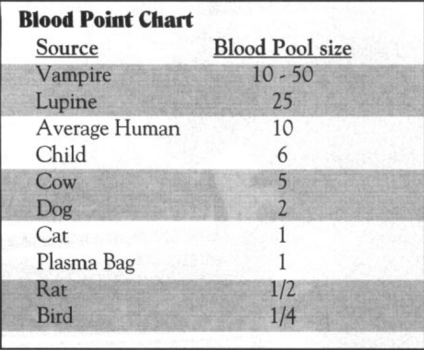
Be a psychopathic murderer or solve the rat and pigeon problem, it’s up to you
It is possible to feed from animals, but the blood is far less nourishing even when there’s more of it. Preserved blood is also much less potent. Even if you wanted to keep a farm instead of feeding on humans, that’s not really practical. Still, some Nosferatu get by on stray animals.
So how do you lose Blood? First, every vampire spends a Blood Point just to wake up every night. That means you need 37 people worth of blood every year, before you even consider the other stuff you can spend Blood on. If you’re out of Blood, you start losing a Health level every night, in addition to being starving hungry and looking like a zombie.
Second, vampires don’t heal wounds naturally. Each level of damage healed costs a Blood Point. Aggravated damage can only be healed at the rate of 1 point per day, and costs 5 Blood Points per Health Level. Have fun finding prey when you look like a starved burn victim.
Third, you can spend a Blood Point to increase one of your Physical Attributes for the rest of the scene. Now you see why that “max Blood Point spend per turn” column on the Generation chart is a big advantage in combat.
Some Disciplines require you to spend Blood. Your current Blood Pool is also the limit for any Self-Control rolls, which is why hungry vampires are prone to going into frenzy and attacking victims at random. You can cut yourself and share blood with a hungry Kindred--but that has its own risks.
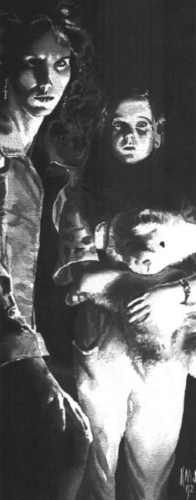
That risk is called the Blood Bond. When you drink a vampire’s blood, it gives them a psychological hold over you. This applies to mortals and Kindred alike. When you drink from them on three separate occasions, you’re Blood Bound. The victim of a Blood Bond is called a Thrall, while their master is called a Regnant. Methuselahs play their games of Jyhad by secretly enthralling younger Kindred to act as their agents. This is yet another reason Kindred politics are so paranoid.
Being Blood Bound is like being in love, in a relationship where the other person has all the power. You probably know that you’re Bound, and might hate what it makes you do, but you’re powerless to do anything about it. A Blood Bond makes it difficult to even think about refusing or acting against your Regnant, much less harm them. You’re obsessed with your Regnant and they are the central figure in your life. A Thrall will perform almost any favour asked of them by their Regnant, though they will balk at extreme risks.
Mechanically, being Blood Bound makes it easier for your Regnant to Dominate you. Much more importantly, even disobedient thoughts cost you Willpower. The only way to break a bond is by spending a huge amount of Willpower over a long period of time, while avoiding your Regnant so that they can’t force you to renew the Bond by drinking more of their blood.
The only advantage of being Blood Bound is that you can only be Bound to one person, so an existing Bond protects you from another. Two Kindred can even become Blood Bound to each other, believing it’s the only way the undead can experience true love. Such romances are frowned upon, to say the least--they’re desperate and obsessive and end badly.

The other side of the Blood Bond is Diablerie, which is draining another Kindred to death to make yourself stronger. If you drain all of another vampire’s Blood, and keep drinking, you can devour their very soul. If they are of an earlier Generation than you, it lowers your Generation by one.
Mechanically, you have to drain all of their Blood, keep drinking until all their Health Levels are gone, and make a Strength roll to basically suck their soul out. Committing diablerie always provokes a Humanity check. There’s no real benefit to committing diablerie on Kindred of equal or greater Generation, and remember that Auspex and Thaumaturgy can detect vampires who have committed diablerie.
While they don’t give hard and fast rules, “some say” that diablerizing a much older vampire means that multiple Kindred can enjoy the benefits of diablerie at once. You can also preserve elder blood, for a quick pick-me-up and possibly to temporarily gain the benefits of their Disciplines.
It’s obvious that you can build a whole chronicle around hunting elders. Diablerie is what the elders fear most, and thus the greatest crime Kindred can commit. (Note that holding a network of Kindred minions in Thrall is not forbidden anywhere in the Traditions.) Thus, diablerie is extremely cool and good. Fuck you, Vampire Dad.
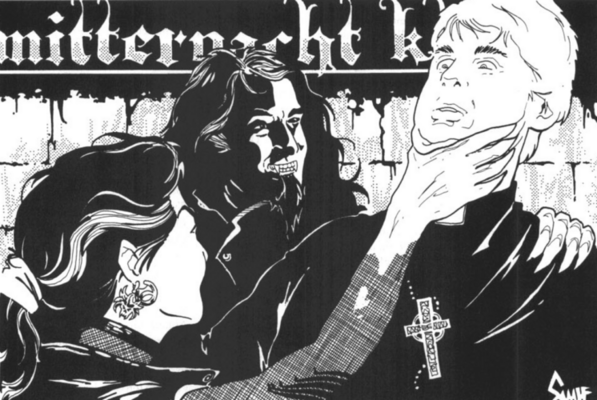
Speaking of things you can build an entire chronicle around, some Kindred seek Golconda. Golconda is a spiritual journey that ends with a vampire transcending their inhuman nature. It’s a mystical state in which a vampire has truly accepted and learned to live with their Beast instead of constantly fighting against it.
Golconda is a legend to most vampires, and some regard it as a childish fairy tale. But it definitely exists, and some few Kindred who have achieved Golconda travel from city to city, preaching the Good News about Not Eating People. The Inconnu, that secretive sect of elders who renounce politics and the Jyhad, is said to be made up of Kindred who seek or have attained Golconda.
There’s no mechanical process for achieving Golconda. It’s meant to be a Hero’s Journey that starts with seeking out legends and secrets, develops by showing remorse for past misdeeds and developing compassion, and culminates in a mystical dream-quest. It requires finding a mentor, and making restitution for past wrongs, so it’s like the most goth 12-step program ever.
Once achieved, there are mechanical benefits for Golconda: you only burn one Blood Point per week, and you never suffer frenzy or Rotschreck. To maintain Golconda, your Humanity must stay at 7 or higher, and your Conscience at 4 or higher.
An alternative to Golconda is Rebirth--becoming human again. As with so many things, “it is said” that the penultimate stage of seeking Golconda gives you the option of becoming human again. Other suggested ways of achieving Rebirth are a complicated set of rituals, or killing your sire, grandsire, and grand-grandsire. There are no real rules covering this; it’s also meant to be a campaign seed. Another suggestion is that a vampire who dies in an incredibly heroic way might experience death as a mortal, not as a Kindred.
So what do I think of Golconda? In the main, I don’t. It’s essentially a chronicle option unto itself, and an interesting one to be sure, but it didn’t get much attention from the developers as time went on. I don’t think they intend you to keep playing PCs who have achieved Golconda, and if they did, it would just be another character option. It was never written out of the game, but became a curiosity that formed a small part of the metaplot. From a cynical point of view, there’s little reason to expand on something that’s incongruous with the campaign modules and metaplots you’re publishing. From a creative point of view, the Golconda concept probably wouldn’t benefit from more elaborate rules.
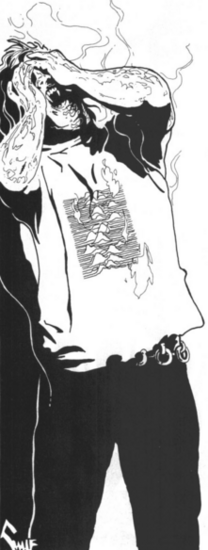
quote:
No two bloodsuckers go out the same way. Some yell and scream, some go quietly. Some explode, some implode. But all will try and take you with them.
Othello, As I Lay Dying
The last and least esoteric statistic to cover is Health, the hit points of this game. Health always seemed a little wonky to me because while everything else in Vampire runs on a 1-5 or 1-10 scale, you have 7 Health levels.
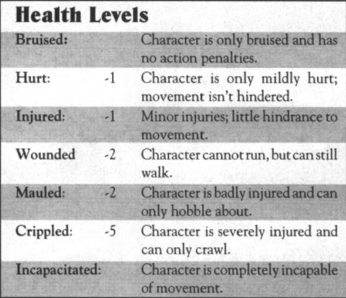
You lose Health Levels when you’re injured, and those wound penalties apply to all your dice pools. Mortals take days, weeks, or months to heal, and if they take more than 7 Health Levels of damage, they’re dead. Vampires aren’t innately more resistant to damage, but they are harder to kill.
When a vampire loses all their Health Levels, all they can do is lie there and spend Blood Points to heal themselves. If you’re Incapacitated and out of Blood, you enter torpor, a state of suspended animation. The length of torpor depends on your Humanity, ranging from days to centuries. You can be awakened if someone’s nice enough to feed you.
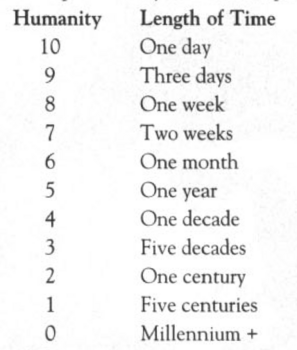
So how can you meet Final Death? If you’re out of Blood and Health Levels and you take any aggravated damage, as from fire or sunlight, you’re dead. Otherwise, it’s up to the Storyteller’s common sense--vampires can be killed by decapitation or anything that totally pulverizes a body, like explosions or deep sea pressure. Funny enough, they don’t prescribe what happens to a vampire’s remains. Fire and sunlight will burn you to ash, of course, but other things? Up to you. My favourite popular interpretation is “you become as if you were never Embraced,” so neonates leave rotten corpses and Methuselahs leave only dust.
Brief notes on sources of damage outside of combat:
Fire bad! It does aggravated damage (so only your Fortitude rating can soak it) and it can hurt you turn after turn. Fire is not only able to kill vampires, it hurts them worse than mortals.
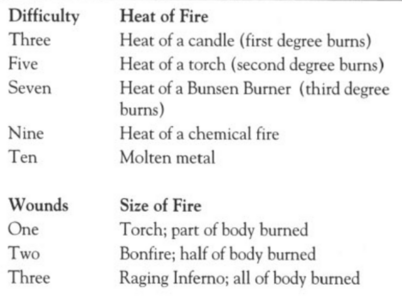
Sunlight is even worse. I mean, it’s everywhere. Same problem as fire. You can see now why I don’t think having Fortitude is all that great.
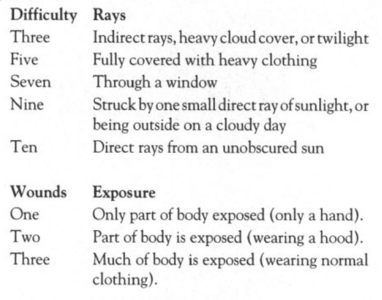
Stakes are another particular problem for vampires. Taking a stake to the heart sends you into torpor until the stake is removed. It doesn’t say whether it has to be a wooden stake, nor that you can’t do the same thing with a Bowie knife.
UV lamps and extreme heat (like 200F and up) can hurt you like sunlight or fire, but with less damage, and usually not aggravated.
Falling does one Health Level per 10 feet, to a maximum of 10.
Freezing cold is dangerous to vampires because they have no body heat. At the Storyteller’s discretion, make Stamina+Fortitude rolls with increasing Difficulty for each roll. Burning Blood will temporarily counter the effects.
Vampires can’t die from human diseases, but they can catch them, lose Health Levels from them, and transmit them to mortal victims. This doesn’t really make sense to me when your Blood becomes mystical vitae, but I suppose there are themes of plague and the Other that couldn’t be done otherwise.

Ring of +5 Thaumaturgy, Ring of +5 Protean, Ring of Fire Immunity, Ring of Sunlight Immunity, Studded Hat of Bat-Shitting,
So if you can survive being impaled, thrown off a roof, burned, and other Kindred trying to drink your blood or feed you their blood or whatever, let’s talk about the real reason you’re playing this game: Experience Points.
Vampires find it hard to truly mature, but they have plenty of time to accumulate knowledge and skill. Besides the point costs, the most important thing to know about XP is that the Storyteller is supposed to gatekeep it. They have to agree that you’ve have downtime to learn an Ability, or actually done something to reflect a personal change that justifies increasing your Virtues, etc. I think that is fair for the narrative Traits, or players would just treat losing Humanity as an XP tax. (After character creation, increasing Virtues doesn’t also increase their derived Traits.)
Disciplines are a particular sticking point. To advance in a Discipline you don’t already know, you should seek out a tutor, or perhaps find a mystical amulet that awakens new powers--if the Storyteller feels like dealing with it. Granted, it’s lame if you can just decide to learn Thaumaturgy because you had a few extra points to spend.
(As an aside, there are multiple hints in the corebook about the possibility of magical items, and potions in the form of vials of elder vitae. While a handful of such items were introduced in an early sourcebook, this mostly fell by the wayside as the line went on. Other WoD games are full of such items, but I suppose they decided it wasn’t in the spirit of Vampire. As it is, it feels like a sop to D&D cliches that the game grew out of.)
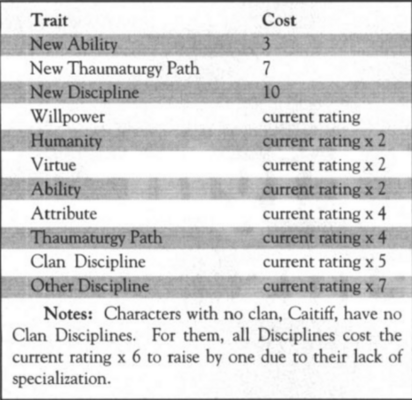
So what do these costs mean in terms of how many XP you get per session? First, everybody gets 1 XP just for playing. Goddamn snowflake millennials and their participation trophies. There are several categories of XP award that the Storyteller can hand out if they think the player earned it.
Learning Curve: Your character learned something meaningful from their experiences.
Acting: You roleplayed well.
Roleplaying: You roleplayed your Nature and Demeanor really well. I do not know why they’re hung up on this. I suppose they’re really into the idea of the Hero’s Journey, to the point that exemplifying archetypes is seen as something important in its own right.
Heroism: Kindred are selfish pricks, and actually putting yourself at risk for others deserves a reward.
Success: The coterie furthered their goals.
Danger: You survived dangerous situations.
Wisdom: The coterie succeeded because of your foresight or cleverness.
I’m not a fan of GMs handing out what might be wildly varying XP awards based on how much you like so-and-so’s character. I prefer it either be equal, or a baseline with a couple extra points awarded by vote.
Next time on Kindred the Embraced: “Drama,” which in this game means dice rolling and combat.
Drama
Original SA post
Vampire: The Masquerade (2nd Edition)
Preface
Chapter 1: Introduction
Chapter 2: Setting
Interlude: A History of Face Grabbing
Chapter 3: Storytelling
Chapter 4: Rules
Chapter 5: Character
Chapter 6: Traits
Chapter 7, Part 1: Clans
Chapter 7, Part 2: Traits
Chapter 7, Part 3: Disciplines
Chapter 8, Part 1: Dramatic Systems
Chapter 8, Part 2: Dramatic Systems
Chapter 9: Drama
quote:
The only good policeman is a dead one
The only good laws aren’t enforced
--Neil Gaiman, Enter the Wu-Tang
What’s with this “Drama” chapter? We’ve already had two separate chapters on how to GM this thing, and one I just covered was called “Dramatic Systems.” While those systems were the narrative mechanics, this chapter is advice on using the rules to resolve common situations. The idea is that if you know how to use the rules without getting bogged down, you maintain the momentum and dramatic tension.
This includes the rules for the most important part of every roleplaying game: combat!
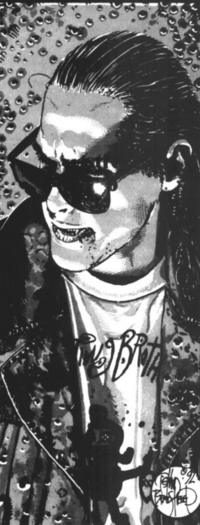
I didn’t even know Einsturzende Neubauten performed at Ringling Bros.
The Action Economy
White Wolf’s games were the first ones I owned. The rules design may leave a lot to be desired, but they trained me to have a healthy loathing of any system that tries to define precisely how many pounds I can lift, how many meters I can run, and how many seconds a combat round lasts. No 90s game is complete without an Internet flamewar over how many punches or bullets you can sling in a 3-second turn. Vampire doesn’t really have that problem.
Vampire defines a scene in the same way as a play or film. Scenes that are “just” roleplaying are still scenes--downtime is defined as the kind of thing you would just narrate, like extensive research or traveling to another city.
Combat and other tense situations are called Action Scenes. In an action scene, a turn is defined as however much time it takes for each character to take one action. In a street fight, each action probably does take a few seconds at most. But it could be longer than that in a chase scene, and longer still in some kind of social combat.
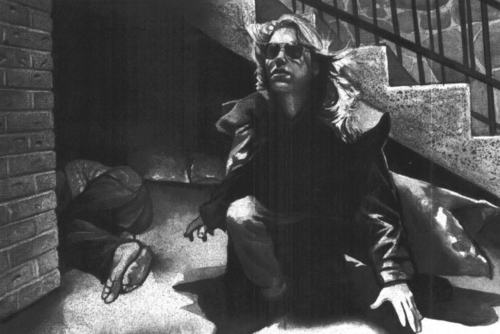
You’ve never loved anything in your life as much as this chapter loves leather jackets and New Wave hair.
Dramatic Systems
Yes, the title of the last chapter is also a section heading in this chapter. These entries are advice on how to resolve common situations that could get more complicated than a single Attribute+Ability roll. The whole lot of them are presented as suggestions, not rules, so you can change them or even disregard them if you’d rather just roleplay it.
Awakening: Vampires sleep like the dead. To awaken during the day (usually in response to some threat) roll Perception+Auspex. Humanity rolls may be required to stay awake for any length of time.
Climbing: Dexterity+Athletics, with a bonus die if you have Protean claws.
Hunting: Y’know, this is a tricky one. While the moral horror of being a bloodsucking monster is a central theme, it’s not the only theme. There are times you’ll want to deal with the practical question of feeding without derailing the narrative, especially since Kindred rarely hunt as a pack.
(Longtime writer Rob Hatch once remarked, “Which is more obscene: the Revolting Revenant, or a player distilling murder down to ‘I attack the bum and recharge my Blood Pool?’” Actually, Rob, the autistic zoophile PC template was a terrible idea in itself.)
So here’s how the recommend you resolve quick-and-dirty feeding: The PC gets 1 die per hour spent hunting, with bonuses from Herd and Fame. The Difficulty is based on the feeding ground--slums are easy, a gated community is hard. On a success, regain 1d10 blood. A botch means something goes terribly wrong. Or if you don’t have time for that, give them the blood and later tell them that they contracted a disease. Oh, brother.
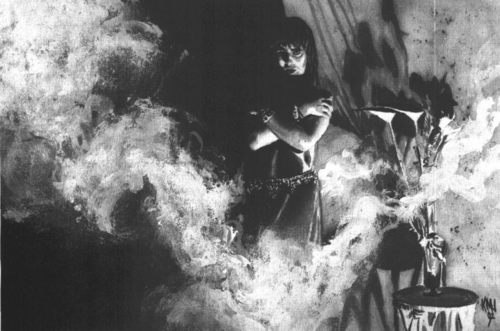
Crazy that Paula Abdul never released this video.
Feats of Strength: Your Strength+Potence sets the baseline of how much you can lift or how great a feat you can perform without rolling. To “push” it higher, roll Willpower and raise it one step per success.
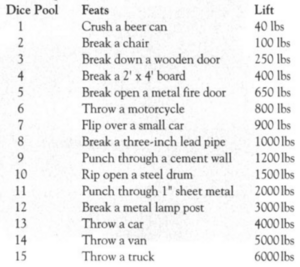
Repair: It’s an extended Dexterity+Repair task, with Difficulty and needed successes based on the nature and extent of the repair. A weird glitch has a high Difficulty but can be resolved quickly, while replacing broken parts is easy but takes a lot of time.
Sneaking: Dexterity+Stealth opposed by Wits+Alertness. You can make it an extended test if they’re trying to cover a lot of distance through a patrolled area.
Shadowing: Actually quite complicated. The stalker rolls Perception+Investigation or Streetwise to successfully follow each turn. But they also need to roll Dexterity+Stealth opposed by Perception+Alertness. The stalker needs a certain number of successes to tail the target all the way to their destination, while the target needs 5 successes to definitely spot the pursuer. There are also optional rules for two people stalking one by trading off. They made this an overcomplicated stealth minigame that’s not very fun.
Swimming: Dexterity+Athletics. This is only worth mentioning for the notes that vampires sink in water, sunlight penetrates it, and sharks are known to eat carrion.
Stunt Driving: Another complicated minigame! Roll Dexterity+Drive, but your pool is limited by your vehicle--three dice for a bus, 9 for a sports car. Vehicle types also have a listed Safe Speed, and your Difficulty goes up when you exceed it.
Pursuit: Chasing someone on foot is simple and should have been the model for how all such things are handled. Roll Dexterity+Athletics, Difficulty 6. If the chaser gets enough successes they can strike or grapple, if the chased gets enough they’ve lost their pursuer.
Stealing: Dexterity+Streetwise for shoplifting and pickpocketing, while burglary should be handled with extended Perception+Stealth rolls. A liquor store holdup is a Manipulation+Intimidation roll, with the victim’s Willpower as the Difficulty.

Negative space makes me horny.
Seduction: “Seduction is an unnatural means of gaining intimacy with another person, because every step is carefully staged and real feelings are not shared (they are faked).” Welp, this is the opposite issue of the quick-and-dirty feeding rules. How much do you want to roleplay seducing someone so you can (probably) attack them and drink their blood?
You’ll probably fail anyway, since seduction involves three stages and you have to succeed at all of them. The “opening line” requires Appearance+Subterfuge, followed by Wits+Subterfuge for “witty exchange,” then Charisma+Empathy for “conversation.” The Difficulties are the victim’s Wits+3, Intelligence+3, and Perception+3, respectively. After that you can say “Do you wanna get out of here? I’m thirsty,” and they’re confused because you’re already in a bar.
Fast Talk: You can use any combination of Manipulation/Charisma/Appearance+Acting/Subterfuge depending on what the Storyteller thinks is appropriate. Unlike most games, a failure leaves you with the option of walking back your confused, babbled lies and trying again, until you get a botch.
There are also rules for “Credibility,” which I guess is for when you’re not full of shit. In that case you roll Manipulation+Leadership against Intelligence+Subterfuge.
Interrogation: This is one of the few games I’ve seen that understands interrogation doesn’t always involve physically bullying or torture--though that’s certainly an option. Roll Manipulation+Intimidation to get useful information out of someone.
Facedown: When two people are just staring each other down to see who blinks first, each rolls Charisma + Intimidation against the other’s Willpower. First one to get their enemy’s Wits+5 in successes is the winner. This childish behaviour is very common among vampires.
Performance: The appropriate Attribute+Ability for a public performance can be one of many options. The Difficulty is based on how receptive the audience is at the outset, with successes indicating their reaction.
Research: Roll Intelligence+Investigation in an extended test, with Difficulty based on the obscurity of the information. Your first roll takes an hour, the second a day, the third a week, and so on.
Composition: Roll Intelligence + Music, Acting, or another appropriate Ability. The player chooses the Difficulty and the number of successes they’re going for, which is reflected in the quality of the final product.
Recollection: Since you could potentially be a thousand years old, there’s a roll to recall specific memories. Roll Intelligence + an appropriate Knowledge. A botch indicates you remember the event completely wrong, and are bound to roleplay this thoroughly...or the Storyteller will punish you!
Tracking: Roll Perception + Survival in the wilderness, or Investigation in the city. This is an unopposed extended test. There sure are a lot of ways to chase somebody in this system!
Investment: Yes, there are rules for investing in business. Roll Intelligence+Finance. Five successes raises your Resources level--so if you’re a Ventrue businessman, you may as well start the game flat broke!
Search: Perception+Investigation, with Difficulty from 7-10 depending on how well-concealed the hidden items are. There are notes that you should let people succeed automatically if they’re looking in precisely the right place, and give penalties if the player is clueless and just saying “I search.”
Although these entries are presented as advice, and far from all-encompassing, the overall scheme still strikes me as badly balanced. In particular, Dexterity is called for whenever you’re required to do anything physical, while Stamina isn’t called for once. Wits and Perception are also usually called in as resistance stats, something Requiem would formalize.
Anyway, let’s

quote:
Out with my crew, some punks got loud
Shotgun blasts echoed through the crowd
Six punks hit, two punks died
All casualties was applied to their side
Human lives has to pass just for talking much trash
We didn't know who they were, no one had the time to ask
--Carl Von Clausewitz, The Dark Knight Returns
Combat
Combat always begin with a Wits+Alertness roll for Initiative. Difficulty 4, count your successes. Failures go last, botchers lose their turn! Characters declare their actions in order of reverse initiative.
As you may know, the big problem with WoD combat is that each attack can involve four rolls: attack, dodge, damage, and damage resistance. That’s if nobody splits their dice pool. If your players are powergaming, they often will.
Attacking: Guns use Dexterity+Firearms, melee weapons use Dexterity+Melee, and fists and feet and claws and fangs use Dexterity+Brawl. The base Difficulty is based on the weapon.
Defending: Any time you’re attacked, you can spend your action to dodge by rolling Dexterity+Dodge. The Difficulty is 6 in melee combat, plus one for each additional enemy in melee range. The Difficulty to dodge bullets is based on the nearness of cover.
Damage: Weapons have a base Damage pool. With Firearms, you get to add your net successes to this pool, and with melee weapons you get to add your Strength. (You don’t get to attack successes from the attack roll to melee damage, but remember that Potence gives you automatic damage.) Then you roll that pool against Difficulty 6, inflicting 1 Health Level of damage per success.
Soak: A struck target gets to roll their Stamina+Fortitude against Difficulty 6, reducing the damage by 1 Health Level per success.
That’s a lot of rolling, but the basic mechanics are simple. So what are the nuances? First, the system seems to favour the attacker. If you dodge, you sacrifice your action--and if you want to dodge multiple attacks, you have to hold part of your pool in reserve! However, both the attacker’s and defender’s Difficulty are altered by the availability of cover, so taking cover is very effective.
That brings up another issue: positioning. Cover is central to the rules for ranged attacks, and multiple people in a melee together both raises the Difficulty of dodging and invokes penalties for flank and rear attacks. This is in a game that doesn’t advise using any kind of battle map, not even a vague sketch, and relies on the Storyteller to track everyone and everything meaningful when describing the scene.
A major complicating factor in combat is the ability to split your dice pool. At base, the rules for multiple actions are simple. Take the lowest applicable dice pool and split it between however many actions you want--limited by your weapon’s rate of fire or by what the Storyteller deems reasonable. Everyone gets to take one action before anybody gets to take two, and so on.
(Of course, Celerity just gives you extra actions at your full pool, which is why it’s the best Discipline.)
Different guns have different rates of fire, so even assuming you can open-carry a longarm, you have to consider base Damage and Difficulty against Rate of Fire. Shotguns in this game are cinematic--they hit like a truck and are just as hard to avoid. But an assault rifle can attack three times for good damage. Since dodging consumes your action, splitting your attack pool isn’t such a bad prospect when your target may not be able to dodge at all.
The list of guns is far from exhaustive, but Vampire definitely started the 90s trend of games that professed an emphasis on roleplaying while nursing an odd preoccupation with equipment lists.
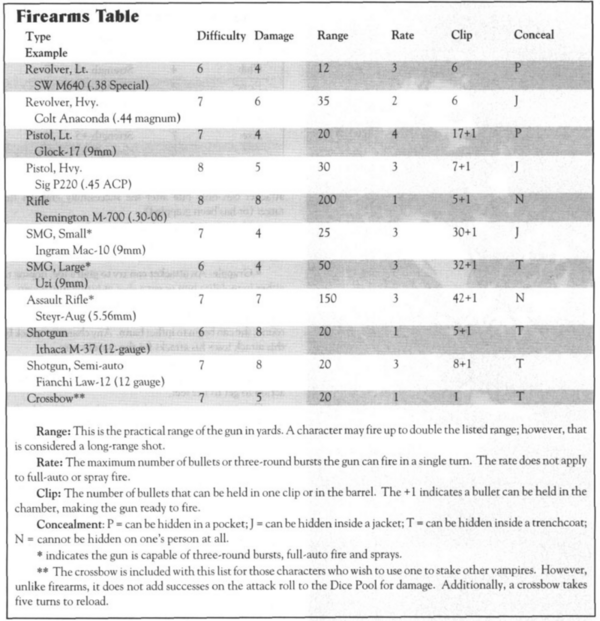
ROLEPLAYING NOT ROLLPLAYING!!!
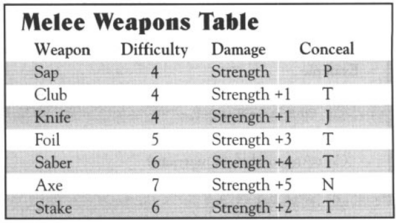
No katana?
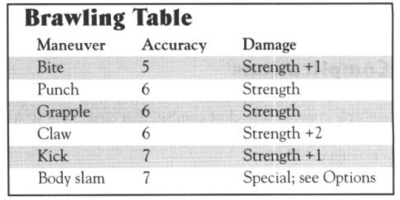
Despite a remarkably complicated combat system, I’ve always found that the best option is the simplest and least interesting: numberslam. Win initiative and do your damndest to one-shot your enemy before they can hit back. Some of you may disagree--I can usually crunch numbers with the best of ‘em, but I didn’t put nearly as much time into the game's combat math as I put into misquoting Ronny Moorings.
Fiddly Little Rules I Barely Used in a Decade of Playing This Game
Immobilized: If you’re held but still struggling, it’s -2 Difficulty to hit you. If you’re totally immobilized, it’s an auto-hit.
Range and movement: If you need to close distance and attack, it’s +1 Difficulty per 3 yards. It’s also +1 Difficulty to shoot at a moving target or while moving yourself, like a driveby shooting.
Aiming: You can add up to your Perception to an attack by spending one turn aiming per bonus die. This is insanely bad combat math, so you’d never do this unless you’re on sniper duty.
Called shot: +2 Difficulty. By itself, headshots don’t have any hard and fast rules for bonus damage.
Multiple shots: When you split your die pool with Firearms, you add +1 cumulative Difficulty per extra shot. (It doesn’t say you can make multiple attacks in melee. It doesn’t say you can’t.)
Burst fire and Spray: What would a 90s game be without autofire rules for fans to argue about? Burst fire is simple: you get +3 attack dice with +1 Difficulty.
Spray is its own thing: you get 10 extra dice, yes, but Spray is only for hosing down an area with multiple targets, and you split your big sweaty dice pool among several targets and exhaust your clip. Not a magazine, a clip. The chart says so.
Flank and Rear Attacks: Attacking a target from the side gives -1 Difficulty, attacking from behind gives -2 Difficulty. This game doesn’t have facing rules, so have fun ruling on that shit.
Stake: To stake a vampire you need to get 3 net successes and do at least 3 damage. There are stats for a wooden stake, but it doesn’t say you have to use a wooden stake.
Biting: Bites do aggravated damage, and as soon as you do any damage you can start draining Blood.
Claws: Just saying, they’re a damn good weapon. Perfectly concealable and they do aggravated damage.
Grapple: Do a melee attack and get more successes than your enemy’s Strength. Grappled targets lose their action, but make opposed Strength+Brawl rolls to break free.
Body Slam: This is not what you think it is. It’s a tackle. Make a melee attack, success means all your enemy’s actions are Difficulty +2, and they have to roll Dexterity+Athletics not to fall down. For actual rasslin’ rules, please refer to Street Fighter: The Storytelling Game or the Trinity Player’s Guide.
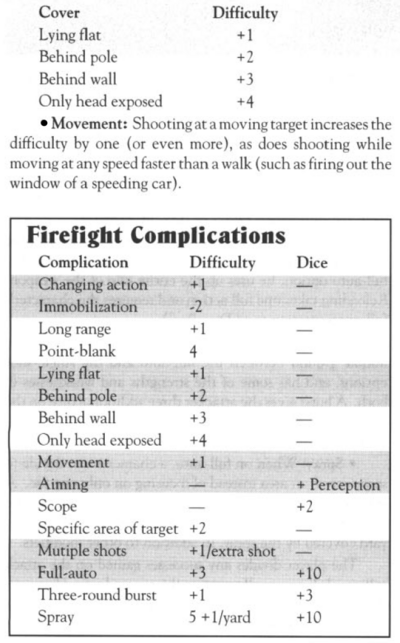
Armor
Sure, this game has armor. Wear a leather jacket, it’s a free +1 Soak. Anything more than that and you start taking Dexterity penalties, which is suicide.
Next time on Kindred the Embraced: Monstrous Compendium I: Mad Catholics!
Appendix, Part 1
Original SA post
Vampire: The Masquerade (2nd Edition)
Preface
Chapter 1: Introduction
Chapter 2: Setting
Interlude: A History of Face Grabbing
Chapter 3: Storytelling
Chapter 4: Rules
Chapter 5: Character
Chapter 6: Traits
Chapter 7, Part 1: Clans
Chapter 7, Part 2: Traits
Chapter 7, Part 3: Disciplines
Chapter 8, Part 1: Dramatic Systems
Chapter 8, Part 2: Dramatic Systems
Chapter 9: Drama
quote:
Sundown, you better take care
When I find you been creepin’ round my back stair
--Gordon Lightfoot, “Sundown”
quote:
That’s not a joke. They quoted a Gordon Lightfoot song in this book.
--Halloween Jack, FATAL & Friends 2020: The Other WoD Thread
Appendix, Part 1
Chapter 9 concludes the formal rules. (If you missed the writeup of the terrible combat rules because the old thread closed, the link is above.) Everything after this is lumped together in an appendix. This update will be a quick one before I get into the more important part: a sample campaign outline and intro adventure.
Example of Play
Chapter 9 ends with an example of play. Its text is split into two columns: a narrative of what the PCs are doing, and the way that’s reflected in the rules.
Clarissa and Ian are searching for Emily, Clarissa’s missing sire. They’ve come to investigate a cemetery where she was last spotted. They run into Dre, a Brujah who claims the cemetery as his turf. After some bickering, he agrees to let them look around.
Together they espy a group of three men: a minion of the Prince called the Sheriff, a notable Toreador still wearing a dinner party tuxedo, and a ghoul lackey--Ian can tell by the fact that this one breathes.
Clarissa hears the Toreador admit that he killed Emily in exchange for the Sheriff’s help against a rival, and presents her ring as proof of her death. She flies into a frenzy and attacks him, igniting a brawl. Clarissa beats Michael to a pulp, the Sheriff does the same thing to Dre, and when the ghoul pulls a gun, Ian uses Dominate to make him stop in his tracks and throw up. Seeing the tide turn against him, the Sheriff grabs the other two and runs.
It’s a fine example of play that includes some physical checks, some perception checks, combat, Disciplines, and an example of when to invoke rules like frenzy. It involves too many die rolls (the PCs roll to sneak up on and detect each other) but that’s the point of the thing.
The most notable thing about it is that “Sheriff” became a common Camarilla political office in later editions, a hatchetman for the Prince.
Antagonists
These are statblocks and notes on some common enemies you might face. The most interesting thing about this section is that because none of the other games had come out yet, they give advice on modeling things like werewolves, wizards, and ghosts with vampiric Disciplines and special traits. It’s also odd that they waited until this section to give you the rules for ghouls.
Vampire doesn’t advise combat encounters for their own sake, and some of these come with reminders that you really shouldn’t fight them head-on. For example, cops. The average cop statblock has unrealistically high stats (Firearms 3?) but that’s not why you should worry. Cops have basically infinite backup if you’re stupid enough to keep fighting them. Also included are stats for police detectives, SWAT troopers, and federal agents. The Camarilla really frowns on tangling with FBI agents.
Witch-hunters are officially unofficial agents of the Roman Catholic Church who hunt the supernatural. But the archetypal Inquisitor is apparently a priest with nothing but a cassock and a crucifix. I’m not sure why I’m supposed to be worried about people who have no combat training, can’t go to the press or the police, and that I’ll see coming a mile away.
Granted, they have True Faith, which we also should have seen the rules for before now. So some truly devout people have a True Faith rating. They can use it to ward off Kindred, who must roll against a Difficulty equal to the rating to approach them, or else suffer a level of damage and suffer Rotschreck. Meh. The Church is still more dangerous to children than to vampires.
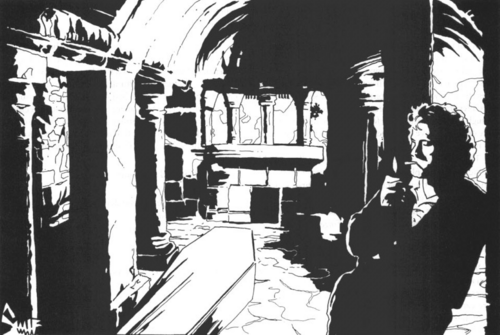
Ghouls are people who drink vampire blood without being drained first. Humans who feed on vampire blood “regularly” get some benefits: they can spend the vitae in their system like a vampire can, they get a dot of Potence and the ability to learn Disciplines, and most importantly, they don’t age. The only vampiric weakness they develop is the potential to go into frenzy when angered, and a long-lived ghoul will age rapidly if their supply of Kindred blood is cut off.
Since the Blood Bond works on mortals, nearly all ghouls are slaves of their creators. Kindred usually treat ghouls like mushrooms, keeping them in the dark and feeding them more bullshit than blood. Creating ghouls is still a Masquerade breach, so you’d better have the Prince’s permission. The most common use for ghouls is to guard their master and run their errands while they sleep the day away.
Although Werewolf: the Apocalypse was released in between the 1st and 2nd editions of Vampire, they don’t try to cram in the rules from a different game. “Lupines,” as Kindred call them, are modeled with Disciplines and some unique abilities. They can assume man, wolf, or man-wolf form. In wolf-form, their Physical Attributes are doubled. In man-wolf form, they get the benefits of frenzy in combat. They regenerate 1 Health Level every turn. Their claws and fangs do aggravated damage, and they get multiple actions is if they had Celerity 2-8! They can also have whatever other Disciplines you think are appropriate.
Kindred are urban creatures, and they’re kinda stuck there. They need population density to hunt, and shipping your carcass from city to city is precarious. But if that’s too complex for your players, you can just tell them “Rural areas are dominated by Lupines, and fighting them is suicide.”
Magi, uh, exist. We’re only told that they are wary and disdainful of vampires, and hold the Tremere in special contempt. Mages have powers that are equivalent to Disciplines, especially Thaumaturgy, with the ability to use each effect once per scene.
Ghosts are also real, and vampires being dead themselves, you’re likely to come in contact with them. They have the equivalent of Auspex and Thaumaturgy powers. (A funny thing about the World of Darkness, as it developed over time, is that Kindred don’t actually have much reason to interact with wraiths and various spirits. It seems they tried to patch this by giving necromantic powers to new clans and bloodlines, with mixed results.)
Faeries are creatures who live in the mystical realm of Arcadia and visit our world only when the stars align. They “range from tiny sprites to mighty tree-lords,” and have Obfuscate, “a variety of Disciplines,” and “various illusion powers.” In other words, whatever powers you want. This is very different from what “Changeling: the Dreaming” turned out to be.
Finally, the biggest thread to vampires? Other vampires. There’s a rundown of how you should stat out vampires of a given Generation range: neonates, ancillae, elders, and Methuselahs. One notable thing is that old vampires have lower Virtues than younger ones as the Beast takes its toll. The other notable thing is that they suggest you give Methuselahs 15 dots of Disciplines. That’s very low by the standards of the “signature NPCs” that were statted up over the course of the game line. They typically have 20-35 dots of Disciplines regardless of their Generation.
Antediluvians don't get stats. They're godlike, and can’t be confronted directly. Only a large-scale coordinated effort can thwart their plans.
Next time on Kindred the Embraced: Built on Sand, Forged in Steel.
Forged in Steel
Original SA post
Vampire: The Masquerade (2nd Edition)
Preface
Chapter 1: Introduction
Chapter 2: Setting
Interlude: A History of Face Grabbing
Chapter 3: Storytelling
Chapter 4: Rules
Chapter 5: Character
Chapter 6: Traits
Chapter 7, Part 1: Clans
Chapter 7, Part 2: Traits
Chapter 7, Part 3: Disciplines
Chapter 8, Part 1: Dramatic Systems
Chapter 8, Part 2: Dramatic Systems
Chapter 9: Drama
Appendix, Part 1
quote:
Columbus sailed the Atlantic, the first steam engines tottered into motion, the British squares stood firm under the French guns at Waterloo, the one-eyed scoundrels of the nineteenth century praised God and filled their pockets; and this is where it all led--to labyrinthine slums and dark back kitchens with sickly, ageing people creeping round and round them like blackbeetles.
--Evelyn Waugh, “The Nameless City”
Vampire finishes out with a sample chronicle. As a proof-of-concept and answer to the age-old question “But what do I do with this weird new game,” I think rather highly of it.
The chronicle is titled “Forged in Steel,” after the motto of Gary, Indiana. The Storyteller conceived the idea while driving through the city on a road trip, and after seeing Michael Moore’s classic documentary Roger and Me. And you fools thought I was mad, mad for my leftist analysis of games about monster superheroes!
Gary is an archetypal “Rust Belt” city that’s suffered drastic population loss and urban decay as American manufacturing collapsed. At the time Vampire was published it had lost 35% of its peak population, and it’s only continued to decline--today, almost a third of its buildings are abandoned. The only thing it needs to be part of a “Gothic-Punk World of Darkness” is a few gargoyles perched on its crumbling landmarks.
Because Gary is a hollowed-out shell of its former self, part of the central concept is that it’s a satellite of Chicago, the real seat of Kindred and mortal power in the region. Chicago became the “signature city” of Vampire: the Masquerade. Choosing a modern, Midwestern metropolis, instead of New York or New Orleans, was an inspired choice for a gothic horror game.
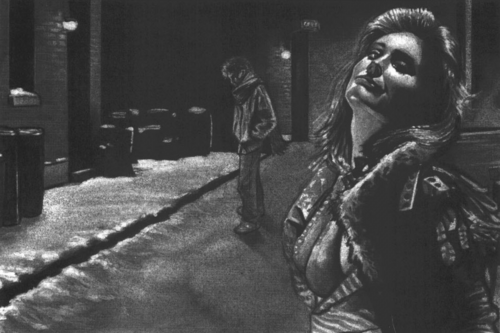
Hey Sailor
The premise is a strong one: for decades, the princes of Gary and Chicago were rivals. Modius controlled Gary’s unions while Lodin controlled big business in Chicago. Modius saw his power base collapse along with the steel industry, and finally lost the war by forcing a Conclave that went very badly for him. Now he must “confer” with Lodin on major decisions; he’s been stewing in this humiliation ever since.
Chicago is a hive of Jyhad, and Lodin has banned the creation of new Kindred for 15 years in order to tighten his grip. So disobedient vampires bring their childer to Gary, and the city has become a dump where the fallout of Chicago intrigues can settle. Modius is downright welcoming, since it maintains the charade that his princedom matters.
To develop the setting, the Storyteller begins by just writing down a list of evocative images he’ll use to establish such lofty elements as theme and atmosphere. Chain-link fences, abandoned houses, pollution, gangs, drugs, literal rust...you get the idea. The dominant motif of the chronicle is sheer decay. Neither the people nor the vampires of Gary have the means or the will to change their situation. Social issues like poverty, addiction, education, and pollution can be woven into the story at will, like The Wire with fangs.
The Wasteland is an eight mile wide stretch of abandoned factories and warehouses along the southern shore of Lake Michigan. Flakes of rust cover everything, and the fleeing industrialists left plenty of toxic waste behind. The only people here are anarchs and mortal gangsters who use abandoned buildings as headquarters.
The dockyards are the only major employer left in Gary. Most freight bound for Chicago is unloaded here. It’s technically part of the suburb of East Chicago, but part of Modius’ territory.
Gary Exports Co. is the front for a smuggling operation--guns, drugs, and vampires. Kindred who want to travel internationally can have themselves shipped in special containers.
The Auction is a slave market held in an abandoned church. A free ghoul named Williams has his thugs round up homeless people, and sells them to vampires for blood and cash. Of course, he won’t drink from the same vampire more than twice. It’s assumed that the PCs will eventually take it upon themselves to end this.
The chronicle’s concept allows the PCs to be a motley crew of unlikely allies. The only prompts are that their sires are all from Chicago, and they should all feel responsible for Gary. There are only seven other Kindred in the city and the Prince is a deluded has-been. This is their city, or it will be. Eventually, they’ll have to defend it against Chicago.
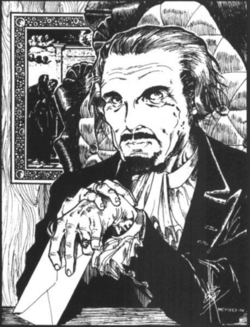
“He looks like Albert Einstein, only he wears nicer clothing and has a more stately bearing. The hair is about the same.”
In Gary, even the few institutions that maintain a respectable veneer are rotten underneath. No one exemplifies that theme better than Modius himself. A Toreador Embraced in the early 19th century, his fashion sense appears to have petrified during the Victorian era. He claims to have been involved in occult circles, and is rumoured to have connections to the Tremere. (He does have a dot of Thaumaturgy. I suspect they originally intended him to be a Malkavian, since he has more Obfuscate and Dominate than his own clan’s Disciplines.)
At heart, Modius is a conniving coward with a massive ego. His intelligence and cleverness are sabotaged by his vanity and paranoia, so the power he craves can only make him miserable when he gets it. He governs by vacillating between flattery and empty threats--empty because he has few henchmen, and isn’t the type to get his hands dirty.
Modius is a great character. He’s not some distant ruler who will hand the characters quests or come down on them when they fuck up. He’s a volatile schemer who needs the PCs more than they need him. As their star rises, he could turn on them out of sheer jealousy. That’s fine, because by the time he’s no longer a useful patron, they’ll be sick of him.
The story hook involving Modius has him “adopting” one of the PCs as a sort of replacement for a cruel and distant sire. Modius will flatter the PC to the point of talking about abdicating in their favour, just to con them into refighting his war against Lodin.
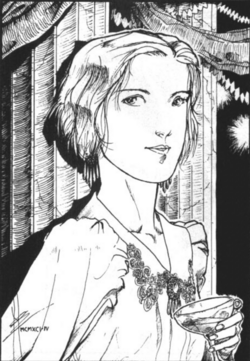
Allicia is shy and sad. She was a beautiful young woman when Modius Embraced her. Her mortal life ended in 1938, and she dresses like it. She remembers barely anything of her human existence, and hasn’t spoken for 50 years.
She lives simply from an old store of wealth. She seems to have spent most of her life as the mistress of powerful men, and still has connections to wealthy families in Chicago. These are slipping away from her as her lack of aging becomes obvious.
Alicia has had a number of failed affairs with Kindred who come to Gary, because Modius is using her as a pawn. She’s Blood Bound to him, and when she shares blood with other vampires, they eventually become Bound to him as well. She’s been very sheltered with regard to Kindred lore, so she doesn’t understand what’s happening. The major story hook involving Alicia has her getting romantically involved with one of the PCs, creating a tale of star-crossed lovers.
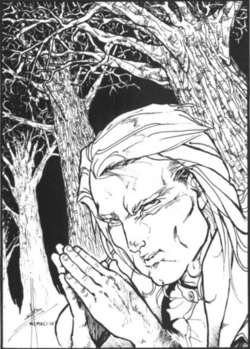
Bet you didn’t know vampires can get the mumps.
Juggler is that guy you know who’s a lot of fun, despite being a complete asshole. In Chicago he’s become an urban legend, the “Party Man” who appears to midnight revelers, takes them on a wild ride, and vanishes before sunrise. No one knows why Modius tolerates his presence in Gary, but many assume he owes Juggler some kind of debt. Juggler is a Brujah and is secretly an anarch leader in Chicago. His comrades maintain a headquarters in Gary’s Wasteland, and he’s working on bending the local gangs to his will.
The story hook for Juggler is a fun one: he’s secretly the sire of one of the PCs. He tells them that they will both be killed if the connection is discovered. He offers aid, as long as it doesn’t blow their cover, and controls them with threats. Meanwhile, Modius accepts the PC as the childe of a reclusive Chicago elder and flatters them constantly.
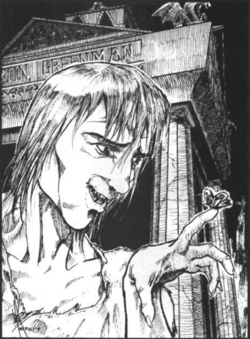
Michael is a sad case. He is physically and mentally disabled; other Kindred suspect he was Embraced out of cruelty. He’s managed to not only survive, but avoid drawing attention to himself. He sometimes attaches himself to Allicia for a few months, but eventually wanders back to his haven in a crumbling mausoleum. If asked about it, he’ll point to the epitaph and say “Daddy,” but there’s no evidence that he’s related to the man buried there.
Michael is difficult to talk to. He’s very shy, and good at hiding himself, despite being a tall wiry man with a severe limp. He’ll only reveal himself to those who spend a lot of time hanging around his cemetery looking for him. If attacked, he’ll defend himself with great strength, but he’s not aggressive. (When asked how he feeds, he just shrugs.)
I’m not fond of Michael as a character. Intellectually disabled characters are rarely handled well, and Michael isn’t free from cliches: he’s uncoordinated but has incredible strength, and the roleplaying notes say to “Play up your low intelligence, but make sure you let a certain craftiness and wisdom shine through.” Pass.
I do think the given story hooks for Michael are pretty good. The PCs could mistake him for a killer or a member of the Sabbat before getting to know him. He can also be the target of a vampire hunter, lacking the wherewithal to deal with the situation alone. As Michael is a Malkavian, I’d rather recast him as a vampire who is afraid to travel far from his haven and doesn’t really understand what he is.
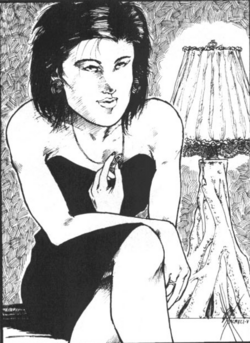
Why do half of these faces look like Charlie Kirk memes?
Evelyn Stephens is the other half of the Taylor Swift music video. She encountered Juggler while partying in Chicago, became fascinated with him, and eventually seduced him into Embracing her. At first she was terrified, but soon began to revel in her power. Evelyn is an impulsive, reckless hedonist, and when Modius finds out about her, he will fly into a rage.
Evelyn’s story hooks center on getting herself into trouble and dragging the PCs along with her. Her initial terror at her Embrace led her to confide everything in her brother, a police detective. After befriending the PCs, she will introduce them to her brother. (Juggler is such a terrible sire that Evelyn doesn’t know better than to commit a capital crime and then admit it to Kindred she barely knows.)
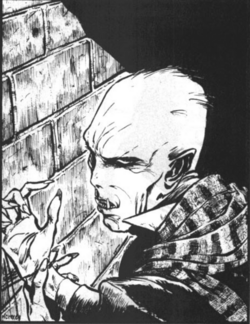
Alexander Danov is a Nosferatu, Embraced around the turn of the 14th century. He’s a very unusual vampire. He is centuries old without claiming the status of elder, he is a nomad who travels from city to city, and he is a Golconda seeker. He doesn’t proselytize, but will help PCs who are interested in seeking Golconda. Danov is a very humane vampire with no political ambitions, so there’s not much else to him. He's very knowledgeable and respected, so he could be used to point the party in the right direction when they miss a cue.
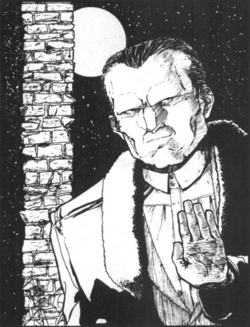
My man got Trump hands
Lucian is an ancient Gangrel who owns Gary Exports and controls the city’s shipping industry. He could surely seize the Princedom if he wanted it, but he doesn’t, and has a cordial relationship with Modius.
Lucian is described as an unusually decent vampire who only gets involved in Kindred politics to keep the peace. (I find this odd considering he smuggles drugs and guns.) He doesn’t care at all for Jyhad, or clan allegiances, or really Kindred society at all--he comes from a time when vampires were far fewer and far-flung and rarely associated with one another. He also freely admits to having murdered his own sire, which many vampires find appalling.
Lucian has no story hooks specifically written down for him. Considering that he’s the real power in Gary and has a business transporting vampires across the Atlantic, the PCs will need him sooner or later.
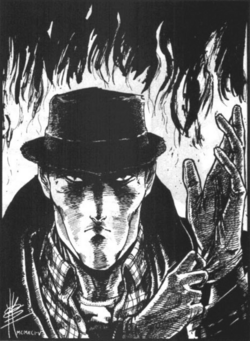
Sullivan Dane is a zealot. From a young age, he believed he had a calling from God. He wanted to become a Jesuit, but his studies were interrupted by his encounter with a vampire. Unable to convince his peers in the Church, he was recruited by the Inquisition, which supports his activities. He’s devoted his life to destroying vampires and proving their existence to the Vatican.
Dane is a sharp-featured, athletic man who dresses conservatively. He wears gloves to conceal the burn scars he suffered in killing his first vampire--that was the last time he got sloppy. Dane may be a mere mortal, but he’s brilliant, clever, and highly skilled. (He also has a True Faith rating of 8 and an unexplained dot of Auspex, so have fun with that.)
Dane is a very careful hunter who stalks his prey for a long time before striking, and will use one vampire as a stalking horse to find others. His goal is to expose and destroy every vampire in Gary and Chicago--he has no idea how many there are. If the PCs accidentally lead him back to Modius, they will be blamed.
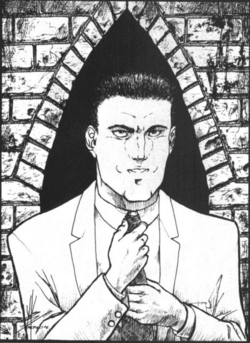
Wrex.
William Shepard is a FBI agent who knows that vampires exist. (He’s not an agent of Special Affairs, and doesn’t even know they exist). He’s aching for the opportunity to investigate Kindred activities that fall under his jurisdiction, and will hover around local law enforcement looking for leads.
Shepard is a professional who never tips his hand or rushes into danger without backup. He’s also not a crank who will admit his beliefs to his colleagues. If he ever meets up with Greg Stephens, the Kindred of Chicago will be in deep shit. He’ll have an ally in the local police who knows the score. Shepard can easily play the role of principal antagonist in the chronicle.
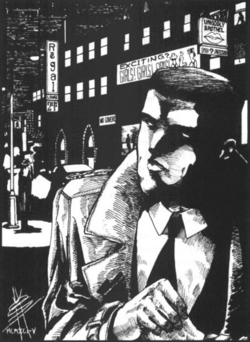
Gregory Stephens is a Chicago homicide detective and the brother of Evelyn Stephens. He was once a raw recruit who just needed a job, but his years on the force have made him hard-working and compassionate. (This is in the most infamously corrupt and violent police department in the United States, by the way.)
Since he learned that vampires exist and his sister is one of them, Greg has spent most of his time trying to deal with it in one way or another. He’s contacted a lot of occult fringe groups in an attempt to find a cure, and he’s worked both for and against various Kindred he’s identified, per the demands of his conscience and his agenda to gather more information. He’s already had one encounter with Juggler that left him seriously hurt, and the only thing keeping him alive is Lodin’s edict that killing cops is off-limits. That’s wise, since Stephens has set up a dead-man’s-hand to deliver all the information he’s gathered to a trusted police commissioner.
Next time on Kindred the Embraced: “Baptism by Fire,” the intro module.
Scenario
Original SA post
Vampire: The Masquerade (2nd Edition)
Preface
Chapter 1: Introduction
Chapter 2: Setting
Interlude: A History of Face Grabbing
Chapter 3: Storytelling
Chapter 4: Rules
Chapter 5: Character
Chapter 6: Traits
Chapter 7, Part 1: Clans
Chapter 7, Part 2: Traits
Chapter 7, Part 3: Disciplines
Chapter 8, Part 1: Dramatic Systems
Chapter 8, Part 2: Dramatic Systems
Chapter 9: Drama
Appendix, Part 1
Appendix, Part 2: Forged in Steel
quote:
Most of you are afraid of our neighborhood.
But did you know? So are we.
But we are here, you see,
Not because we want to be.
--True Sounds of Liberty, “The Haunted Palace”
Vampire: The Masquerade wraps up with an intro scenario for the “Forged in Steel” chronicle. It’s meant to be the first session for the PCs, after any “Becoming” one-on-one sessions from character creation. “Baptism by Fire” is designed to instantly put the PCs at the center of the city’s intrigues. It’s flexible and gives them several options, both individually and as a group.
The scenario is set at a party, and it’s designed so that it can be run as a LARP, including suggestions for managing NPCs and a few stage directions. That strikes me as a bad idea for a first session. My other criticism of the scenario is the way various intrigues tend to split the party up. Other than that, it makes for a low-stress session that allows both the Storyteller and the players to get into character. There are only a handful of key events, and the rest of the time is spent meeting the other vampires of Gary and getting a feel for its politics.
Setting
Modius has decided to revive a tradition he maintained in his salad days: hosting a New Year’s Eve party which all the Kindred in Gary are expected to attend. The party is held in Modius’ large mansion, where the decline of Gary and its Prince is on full display. The antique furnishings are almost too rotten and moth-eaten to sit on, and the roof is so leaky that the characters walk past buckets on their way to the hors d’oeuvres they can’t eat. If asked, Modius’ response suggests that he’s too paranoid to even allow a contractor into the house. The proceedings are guarded by four flannel-clad union stewards, all thoroughly Dominated by Modius.
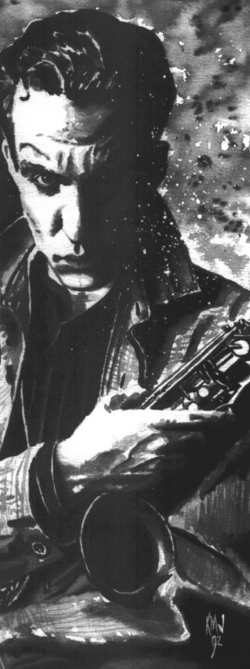
Sergio
Events
The Hunt: Before the scenario formally begins, you may want to run individual scenes where the PCs hunt for blood. It may be their first time doing so without any handholding from their sire! It’s recommended that you not spend too much time on this, but if you like starting in media res with an action scene, a botched hunt is an opportunity to do so.
The Entrance: When you arrive, Modius will greet you, dressed in an old-fashioned tailcoat. As always, Modius behaves with unctuous courtesy. He may reference details from the first time he met each of you, during your formal introduction to the Prince.
Danov: Alexander Danov is standing in the dance floor, staring at the wall. At the slightest prompting, he will converse with you on lofty moral and political topics like the Traditions, the anarchs, diablerie, and Golconda. He will also make cryptic comments like “Don’t let yourself get sucked in,” which he will not explain. Danov is the extremely rare vampire who is intensely interested in learning about the characters without having any ulterior motive, and may seem like a lunatic because of it. If you’re interested in pursuing Golconda, Danov is a gift-wrapped opportunity.
Lucian: The ancient Gangrel is sitting alone and staring off into space. (I think this scenario wants to drive home the point that old vampires are fucking weird.) He will answer your questions, but curtly, and pretend to be angered if the questions are personal. With a little effort, he will warm up and gladly tell stories about his very long life. He likes to talk about fighting for Julius Caesar.
However, Lucian is fickle. If he dislikes you, he will play a little prank on you by taking you aside and filling your head with vague talk of conspiracies and hidden threats. He’ll even accuse Danov of being a spy and Modius of being a diablerist.
The Trap: Modius will approach each of you individually to ask where you make your haven. He claims that this is for ease of communication in times of crisis, but it’s a shallow power play. As always, he speaks with mincing courtesy, but throws tantrums and holds grudges if refused. If you lie, you’ll get away with it for now.
Fucking Up: If you do something stupid that breaks the Masquerade, like displaying your Disciplines, Modius will fly into a rage. He’ll demand that you drink some of his blood as punishment, bringing you one step toward being enslaved to a sad old queen. NPCs won’t intervene--Modius is a joke, which means he leaves them alone most of the time, which means a status quo they can live with.
The Seduction: Allicia will make a play for one of the male PCs, “usually the eldest or most sensitive-looking.” First, she’ll do that thing where she lingers at the edge of your perception and you’re certain she’s looking at you, but turn away if you look back. (This isn’t a supernatural power, everyone in the goth scene just knows how to flirt like this.) Later, she will try to you upstairs to her bedroom, touch you all over, and pantomime a desire to share blood, which is how vampires have sex.
Remember, Allicia is mute. I don’t know how to wordlessly proposition someone for sex and blood-drinking; it’s something that really has to be negotiated in detail. It’s problematic.
Allicia’s desire is sincere; she’s desperately lonely and pretty much gagging for it. But this is all a plot by Modius to establish Blood Bonds on young Kindred. He’ll even try to catch you in the act and pretend to be scandalized to drive the characters closer together. This is meant to be the start of a long-running romantic subplot that will probably end in tragedy.
Midnight Toast: As midnight approaches, Modius will gather everyone for a champagne toast, and complain about Juggler’s absence. He will announce that one of Gary’s steel mills is reopening, and prophesy a glorious future for Gary and the union movement.
Soon after, Juggler crashes the party with a gaggle of drunk mortals. He takes the classical music CD out of Modius’ Bose stereo and puts on some Black Flag or Butthole Surfers, and his followers descend on “any available females” and starts dancing with them.
Modius will--can you guess? He’ll fly into a rage, and demand that the mortals be killed for this not-quite-breach of the Masquerade. (His anger is really born of his paranoia about his haven.) It’s up to cooler heads, i.e. the PCs, to intervene and suggest an alternative. Juggler doesn’t give a shit either way, knowing that Modius can’t punish him. Juggler treats the PCs like dirt, calling them “the little slaves” of a “windbag, senile, has-been” Prince. Everything he says is really directed toward Modius.
Evelyn’s Presentation: Juggler has also brought Evelyn, who will introduce herself to the PCs. She’s vivacious, outgoing, and naive, to the point that she’ll admit Juggler is her sire. In a few minutes, Juggler himself will introduce her to Modius and announce that she is his childe. Juggler will, again, fly into a rage that goes on for several minutes and is full of empty threats, before coming to an abrupt halt and letting it go.
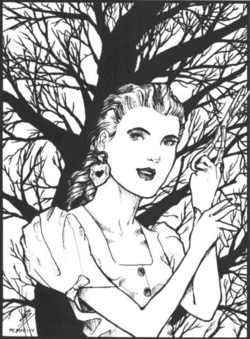
She’s always depended on the kindness of strangers.
Annabelle: Late into the party, a beautiful woman arrives in a white limousine. She and Modius greet one another like old friends, and Juggler slinks out as quietly as possible. This is Annabelle, the Toreador justicar. So one of the most powerful Kindred in the world, as far as you know, and kind of a big deal.
Annabelle takes Modius aside for a private meeting in his office. If you hang around, you can hear a lot of shouting. They emerge with Modius still shouting and Annabelle trying to calm him down. It becomes clear that Annabelle has brought Modius a list of demands from Lodin, the Prince of Chicago. It’s equally clear that she delivered the letter personally because she anticipated his reaction.
Modius expects “the neonates among us” to go to Chicago and deliver his response to Lodin. If you refuse he’ll threaten, cajole, bribe, or do whatever it takes to get you to agree--he has no one else. He adds that you will probably have to formally Present yourself to Lodin as if you were new Kindred. Lodin, that fool, thinks he’s the real Prince around here!
Modius offers you two letters, one containing his response and another acting as a safe conduct. If opened, the response contains only meaningless platitudes and excuses. The safe conduct is worthless, and Modius knows it. The only guidance you’ll get is from Lucian, who advises you to look up an old friend of his at the Succubus Club. Modius overhears this and insists that the Succubus Club is a wretched hive of scum and villainy, but it’s your only lead.
And that’s the scenario. A lot of chances to meet people, some tension, some action, some vampire sex, maybe you kill some drunk people, and then you get a quest.
Next time on Kindred the Embraced: Nostalgia is not a harmless vice.